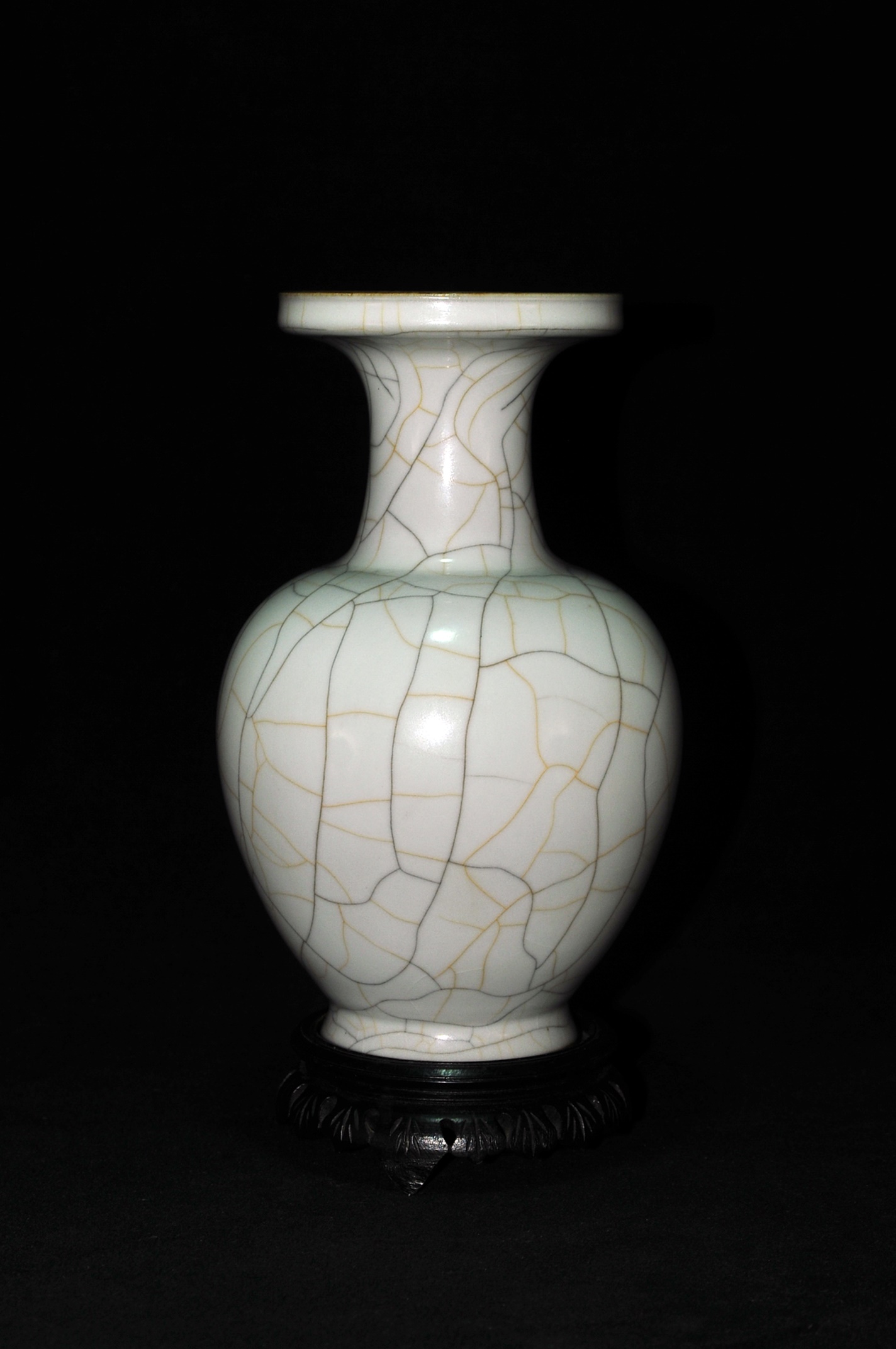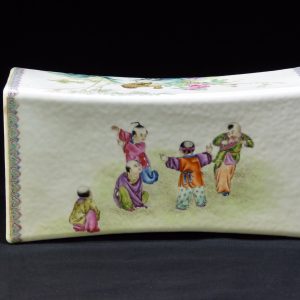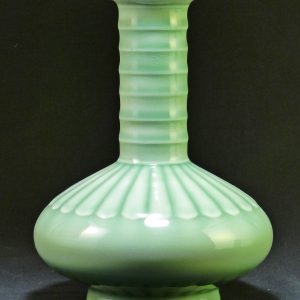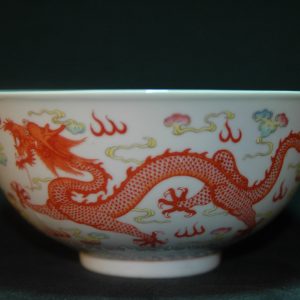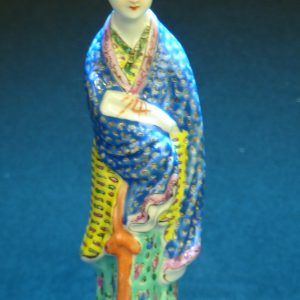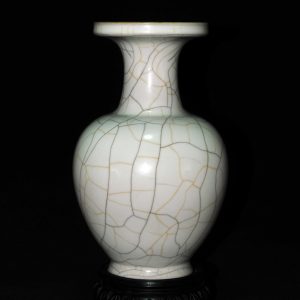Description
大清乾隆 仿哥釉 撇口瓶 盘口尊 盘口瓶 凤尾尊
参考:苏富比
Important Chinese Art
March 22, 01:01 PM PDT
Lot 520. A Guan-type ‘Three Rams’ meiping, Seal mark and period of Qianlong
清乾隆 仿官釉三羊開泰梅瓶 《大清乾隆年製》款
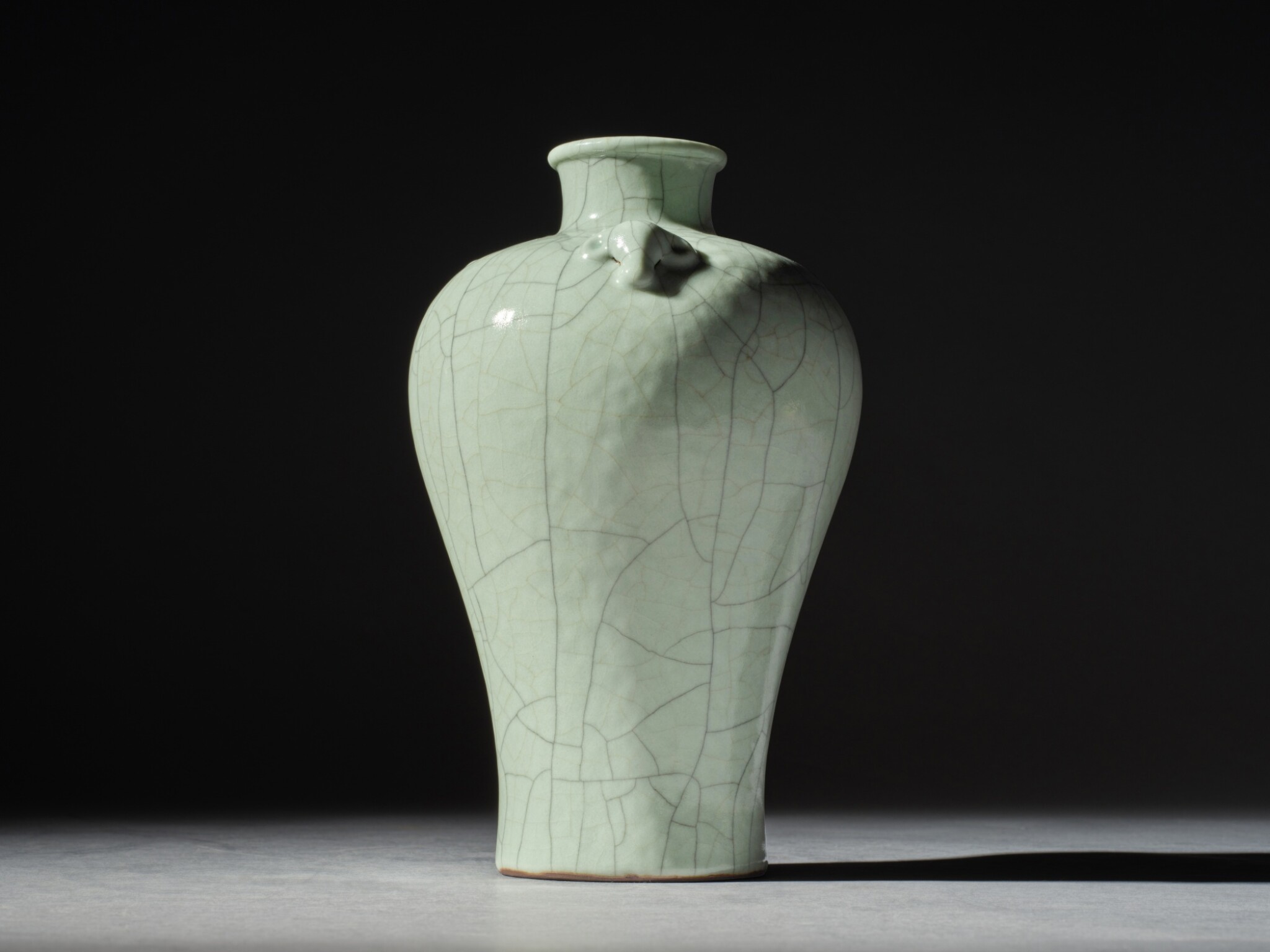
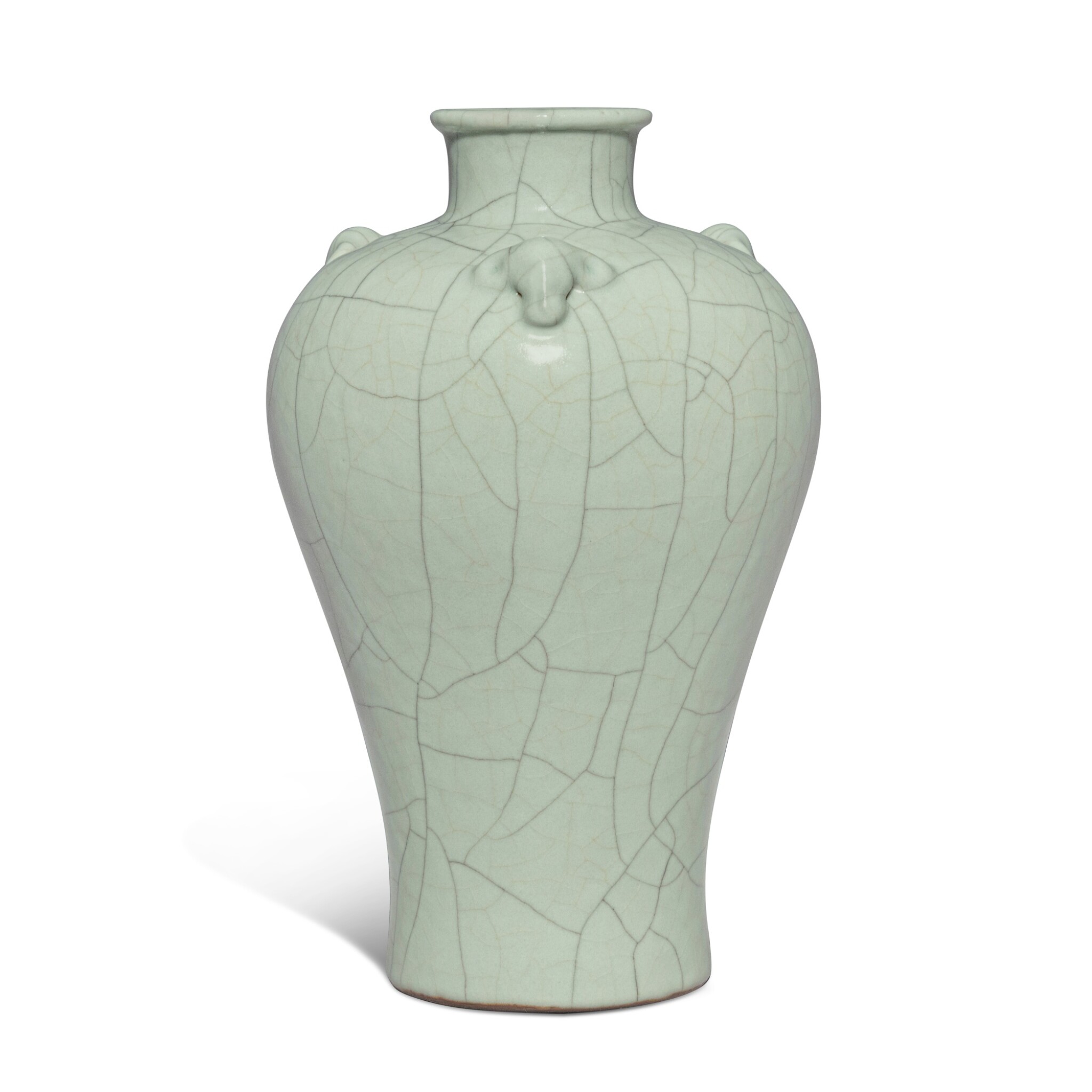
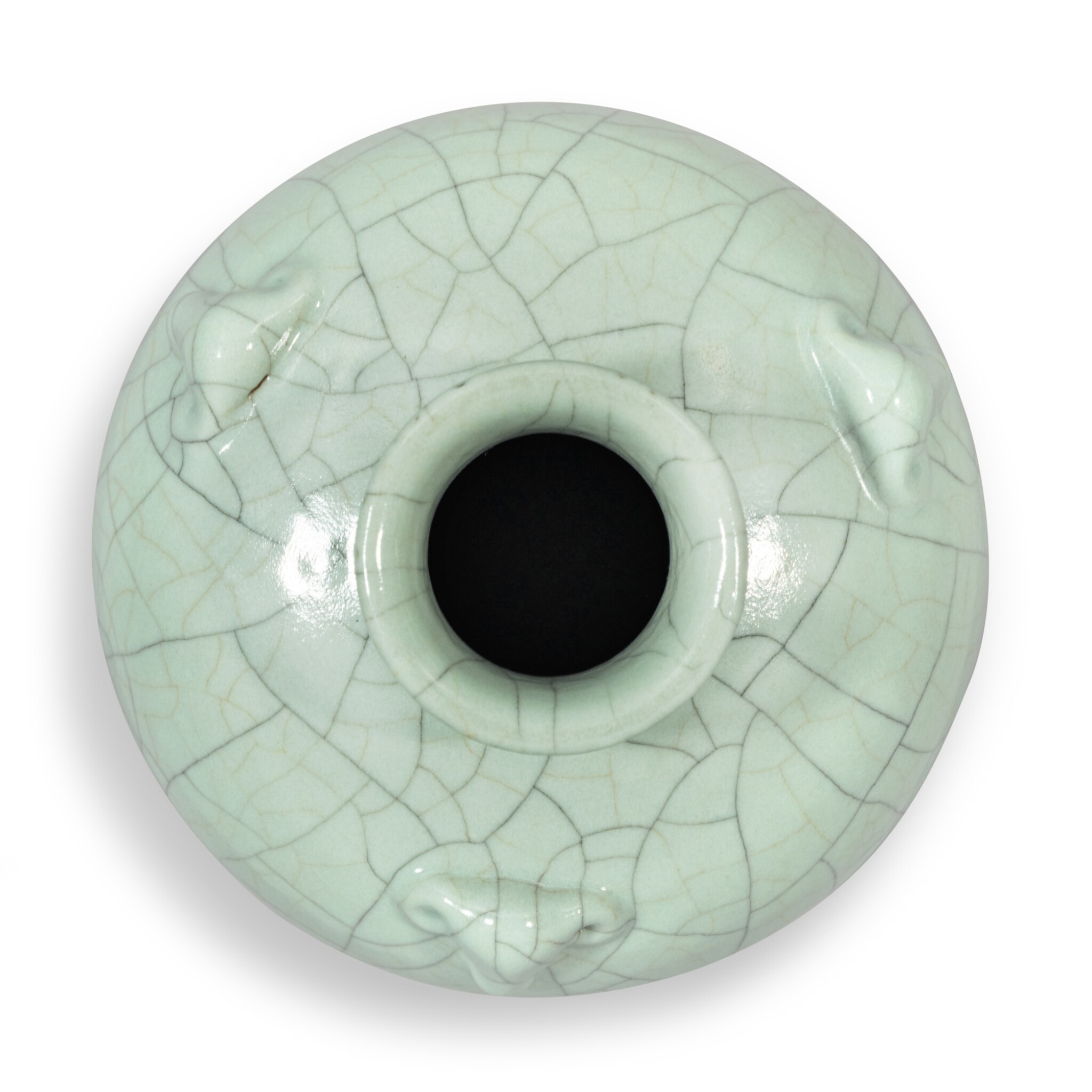
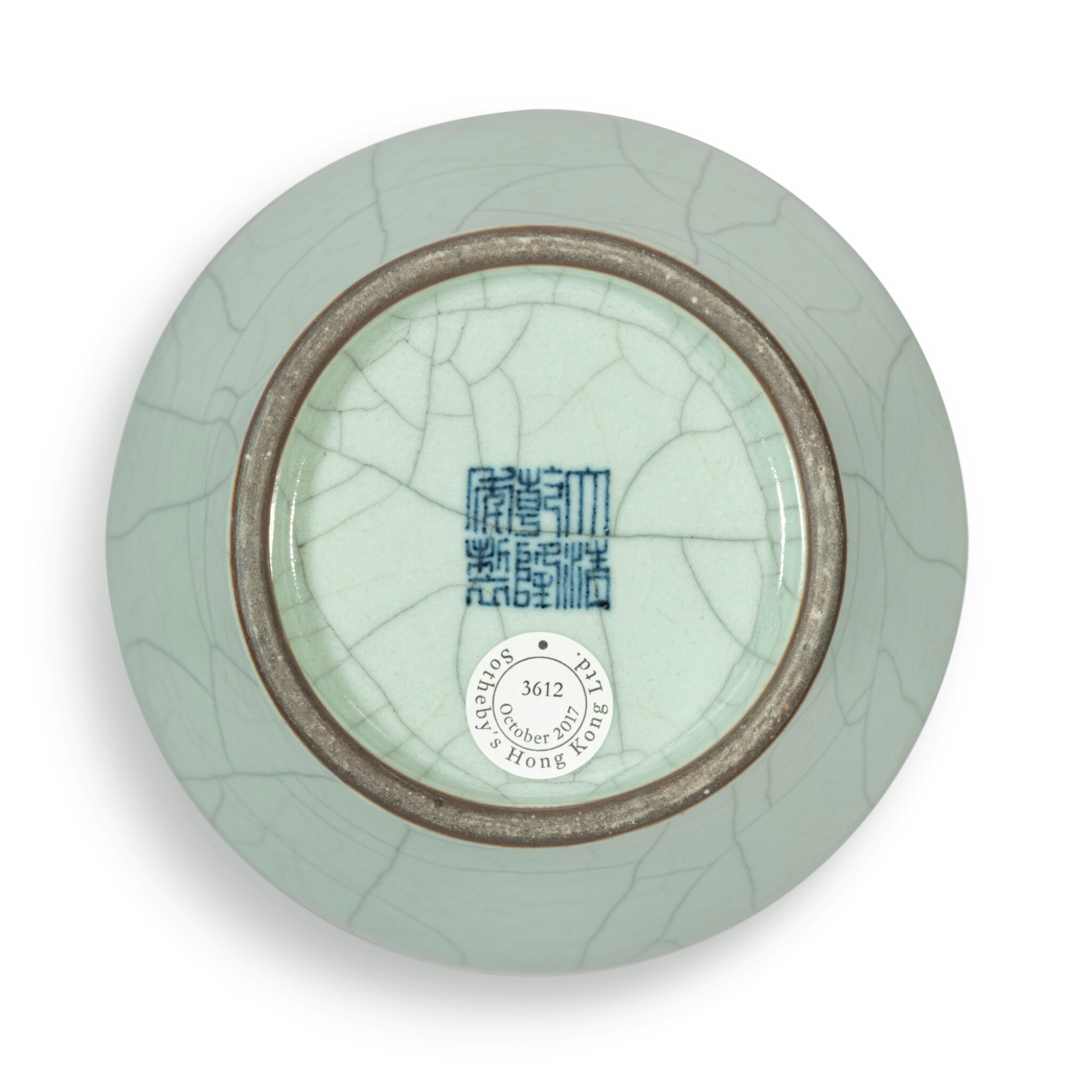
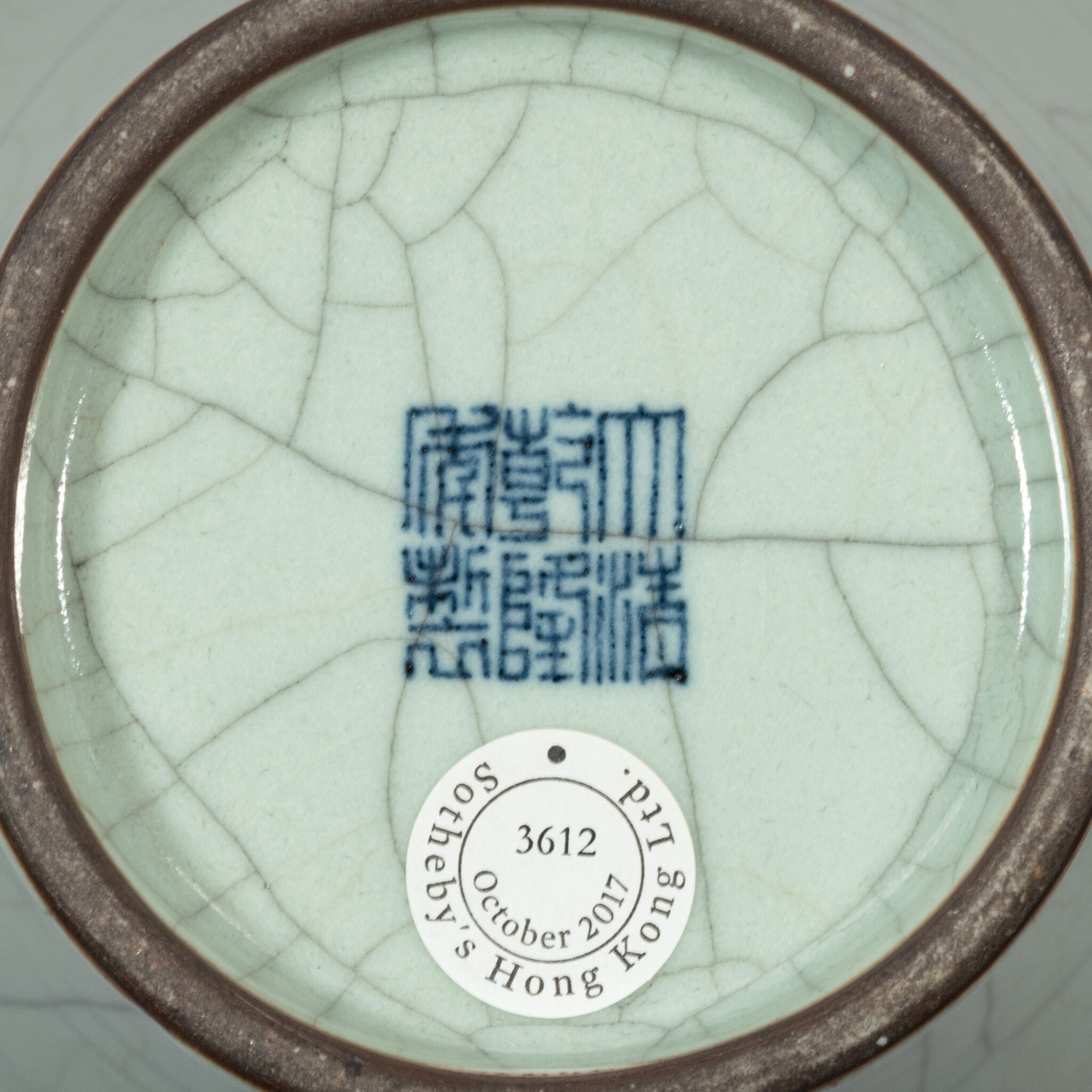
Estimate 150,000 – 250,000 USD
Lot Sold 444,500 USD
A Guan-type ‘Three Rams’ meiping
Seal mark and period of Qianlong
清乾隆 仿官釉三羊開泰梅瓶 《大清乾隆年製》款
the base with a six-character seal mark in underglaze blue
Height 9⅛ in., 23.2 cm
Condition Report
The lip with a small section of light touchup, otherwise in good condition with minor firing imperfections. The glaze with a fine original craquelure.
口沿見一小處微修。除此外,品相良好,見少許微細窰燒瑕疵。 釉面見原始片紋。
Provenance
Japanese Private Collection.
Sotheby’s Hong Kong, 3rd October 2017, lot 3612.
日本私人收藏
香港蘇富比2017年10月3日,編號3612
Exhibited
Sekai kobijutsu tenrankai [Antiques of the world exhibition], Yamanaka & Co. and Tokyo Art Club, Osaka and Tokyo, 1932, cat. no. 688.
《世界古美術展覽會》,山中商會及日本美術協會,大阪及東京,1932年,編號688
Catalogue Note
Guan, the official ware of the Southern Song court, has historically been and continues to be one of the most admired and desirable amongst all Chinese ceramics. The Yongzheng and Qianlong emperors were particularly keen admirers of guan wares and had original pieces sent to the imperial kilns at Jingdezhen as models of inspiration. Every aspect of the Song glaze was observed and emulated in order to capture the essence of the famed ware. However, the potters were not merely re-creating these wares—ceramicists at the Jingdezhen kilns, especially during the reign of the Qianlong Emperor, were greatly inventive in combining contemporary forms with famous glazes of the past in an effort to establish a distinctive artistic language which emphasized the Manchu Qing dynasty as a legitimate successor and continuation of China’s dynastic history.
The present vase is a rare and impressive example of such innovation: a familiar Song guan glaze with its characteristic crackle generously covers a finely-potted meiping with a waisted neck and a rounded shoulder decorated with three intricately molded ram heads. The design speaks to the Qianlong Emperor’s particular affinity for the ‘Three Rams’ (san yang) motif. The phrase san yang was first mentioned by the Yijing (Book of Changes) referring to the three male lines called tai, which was a change in fortune that comes about during the first month of the lunar year. The ‘Three Rams’ motif is thus a play on the original phrase, and the famous proverb ‘sanyang kaitai’ represents a change of fortune with the arrival of Spring and the New Year.
Compare a similar Qianlong ‘Three Ram’ vase of meiping form with a ru-type glaze from the Qing Court Collection, now in the Palace Museum, Beijing, published in The Complete Collection of Treasures of the Palace Museum: Monochrome Porcelain, Hong Kong, 1999, pl. 208. See also a few Qianlong ‘Three Ram’ examples but with a globular body and long waisted neck; two celadon-glazed examples in the National Palace Museum, Taipei (accession nos 中瓷001202N000000000 and 中瓷001203N000000000); four sold in our Hong Kong rooms, one with a celadon glaze sold most recently on 8th October 2009, lot 1632; one ru-type example, sold 5th October 2011, lot 1934; two with teadust glaze, sold 5th October 2016, lot 3656 and 11th July 2020, lot 116.
参考:佳士得
25 6月 2021 | 網上拍賣 20379
亞洲藝術
拍品 308
清十八/十九世紀 仿官釉雙耳大瓶
CHINE, DYNASTIE QING, XVIIIEME-XIXEME SIECLE
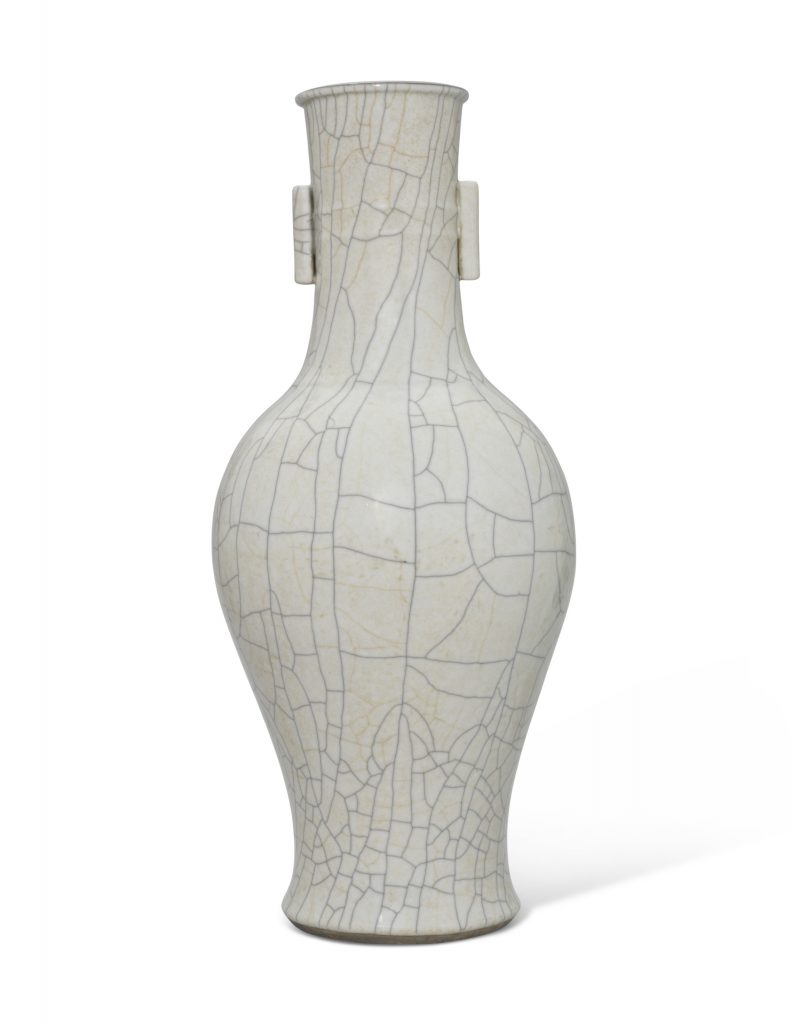
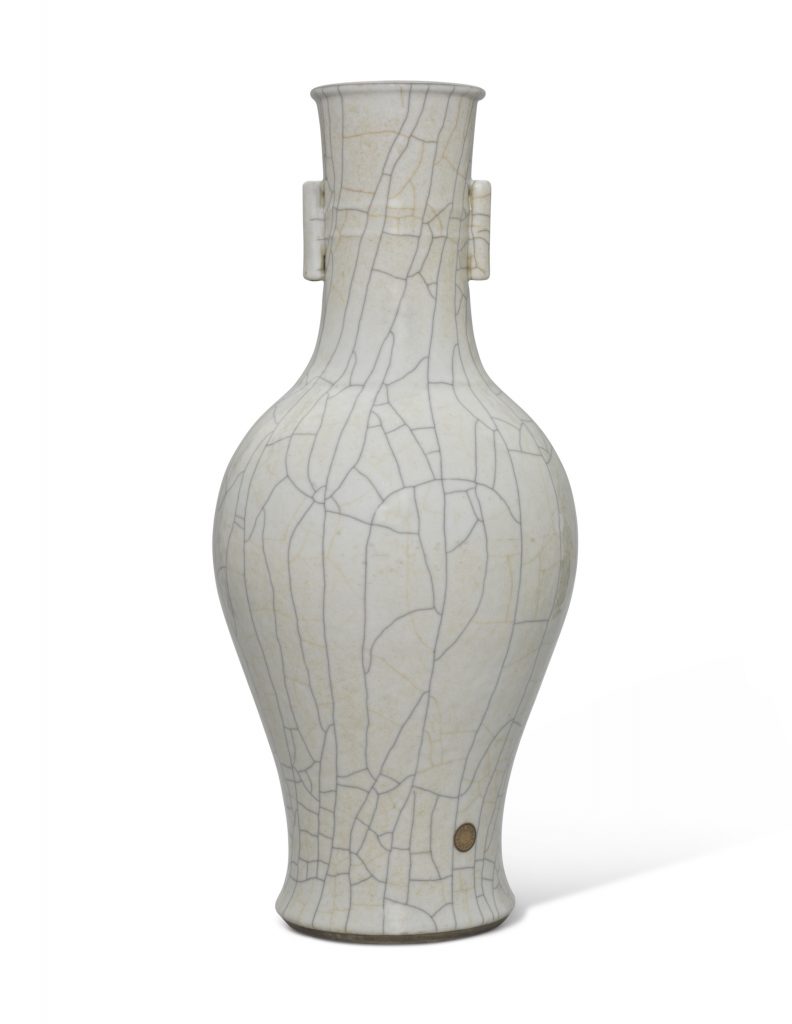
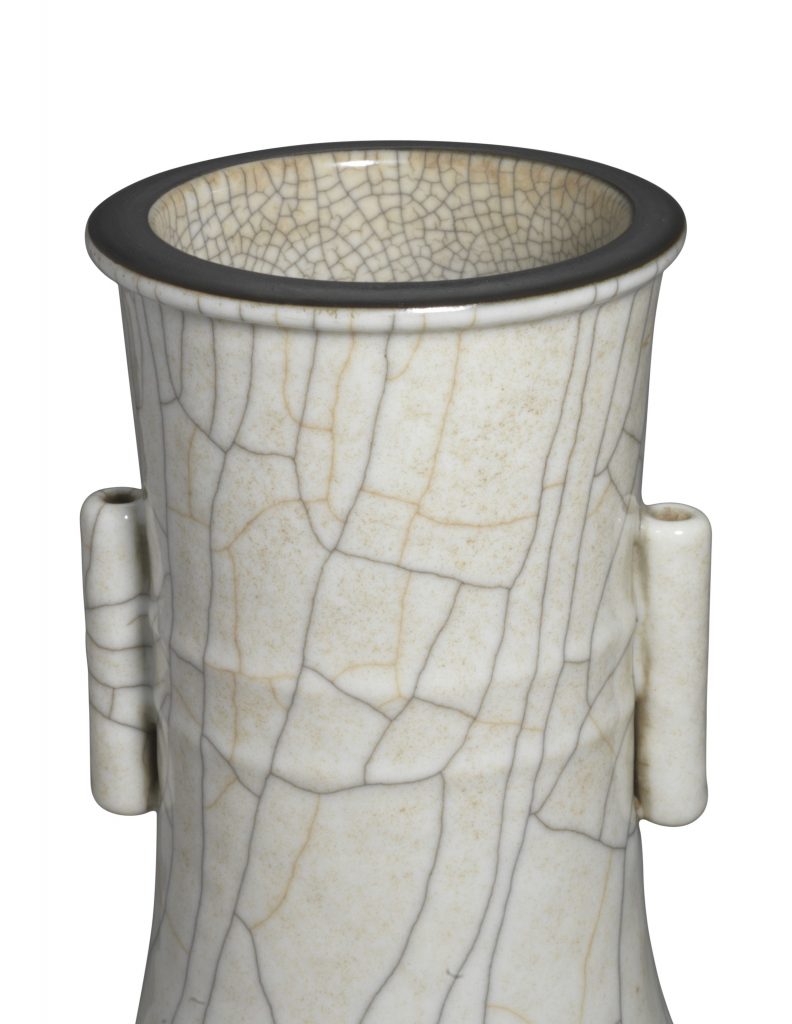
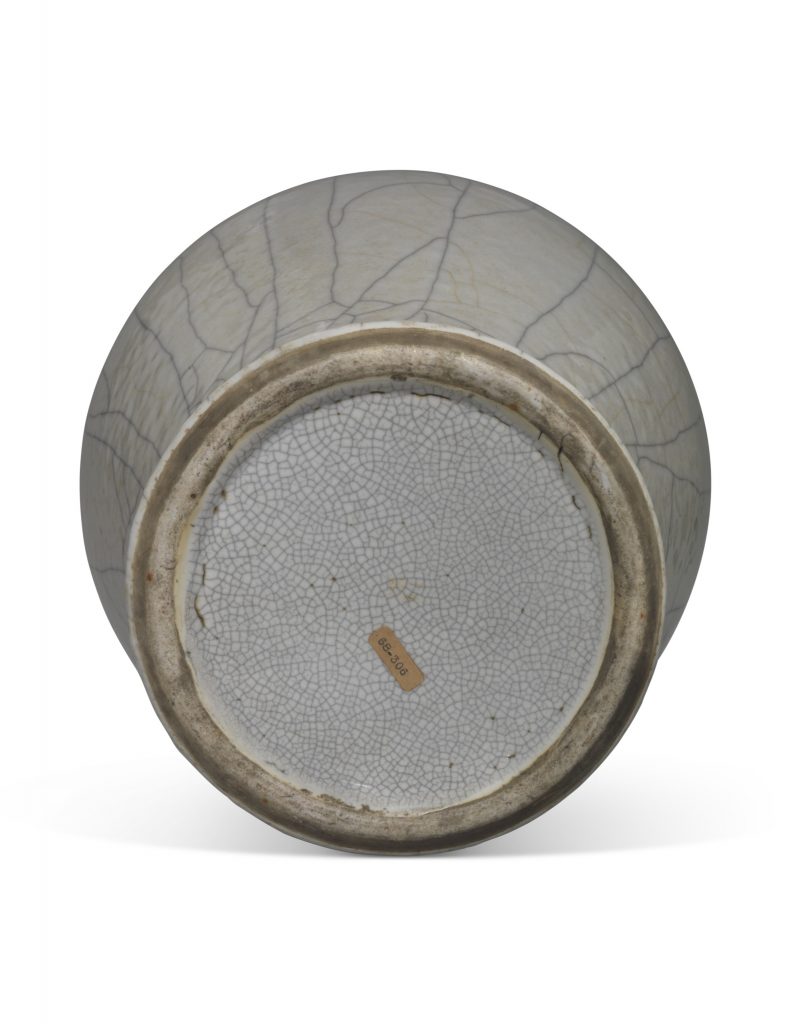
成交價 EUR 9,375
估價 EUR 2,500 – EUR 4,000
清十八/十九世紀 仿官釉雙耳大瓶
CHINE, DYNASTIE QING, XVIIIEME-XIXEME SIECLE
Hauteur: 62,2 cm. (241⁄2 in.)
Please note this lot is the property of a consumer. See H1 of the Conditions of Sale.
來源
意大利羅馬 Mario Prodan 先生舊藏(標籤)
狀況報告
拍品的狀況可能存在極大差異,而由於其性質使然,拍品難以處於完美無瑕的狀態。拍品均以拍賣時的狀況出售。
We have sought to record changes in the condition of this piece acquired after its initial manufacture.
– There are a few short firing cracks to the base.
– There are some age-related surface scratches and wear.
– Otherwise, this appears to be in overall fairly good condition.
参考:佳士得
11 5月 2017 | 現場拍賣 13984
中國瓷器、工藝品及紡織品
拍品 493
A GE-TYPE GLAZED GARLIC MOUTH VASE
PRIVATE ENGLISH COLLECTION
清十八世紀 仿哥釉蒜頭瓶
YONGZHENG-QIANLONG PERIOD (1723-1795)
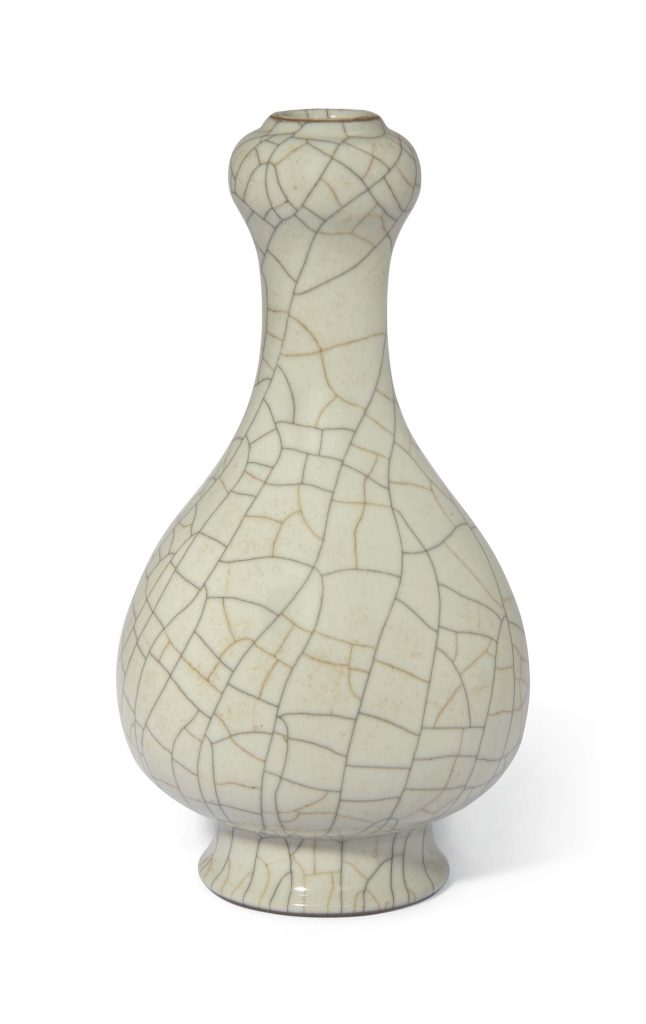
成交價GBP 3,750
估價GBP 3,000 – GBP 5,000
細節
清十八世紀 仿哥釉蒜頭瓶
9 1/4 in. (23.4 cm) high
來源
Acquired in the 1970s in England.
來源: 私人珍藏, 於1970年代購自英國
狀況報告
We have sought to record changes in the condition of this piece acquired after its initial manufacture.
This is overall in fairly good condition.
參考:蘇富比
The Three Emperors: Imperial Porcelain of the Kangxi, Yongzheng and Qianlong reigns from the Yidetang Collection
12 October 2021 • 18:00 HKT
Hong Kong
4
A very rare pair of small guan-type bottle vases, Seal marks and period of Yongzheng
清雍正 仿官釉直頸瓶一對 《大清雍正年製》款
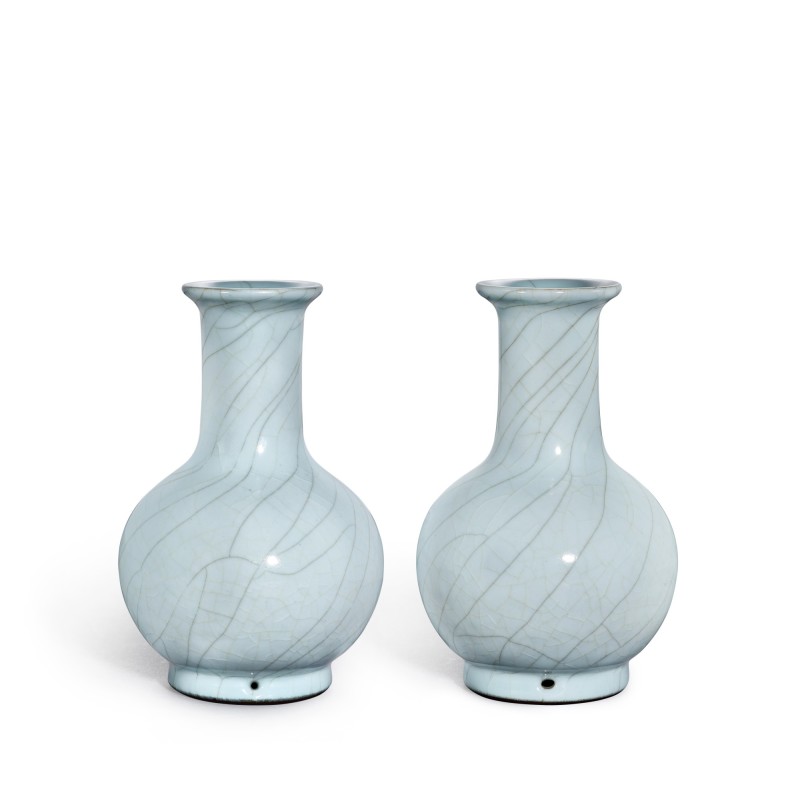
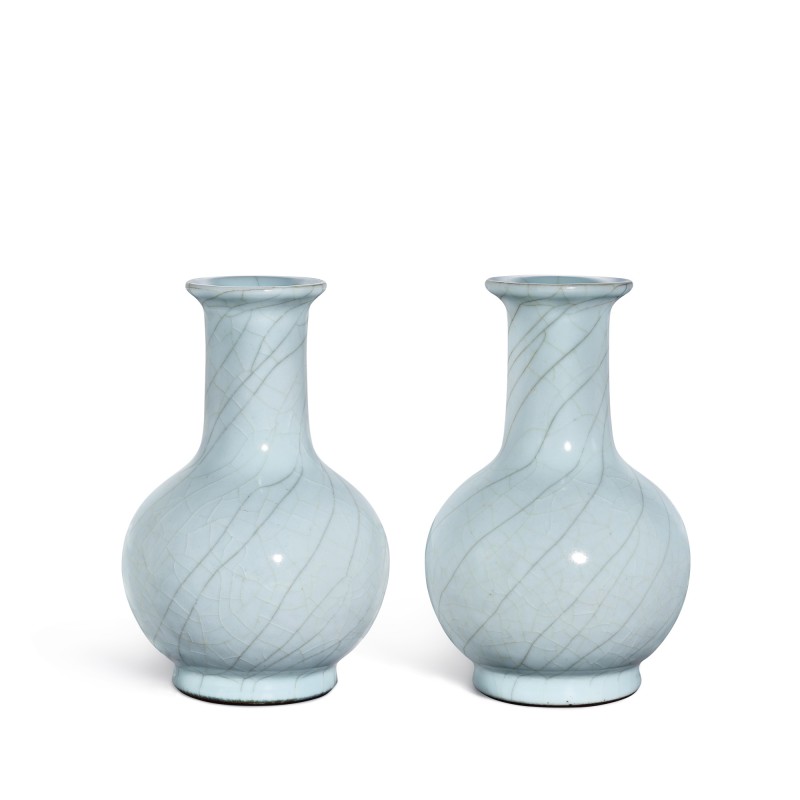
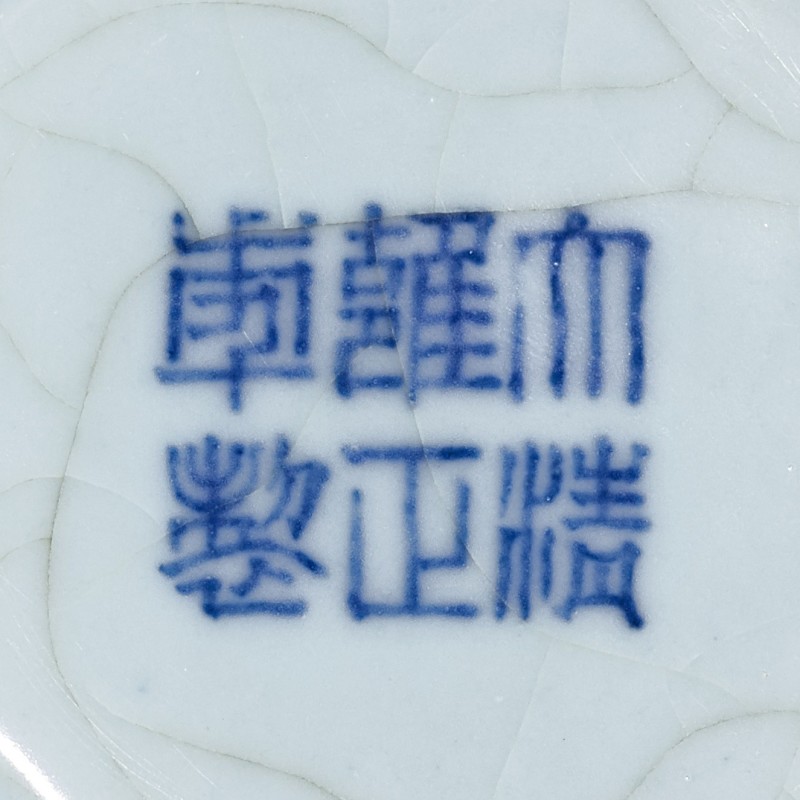
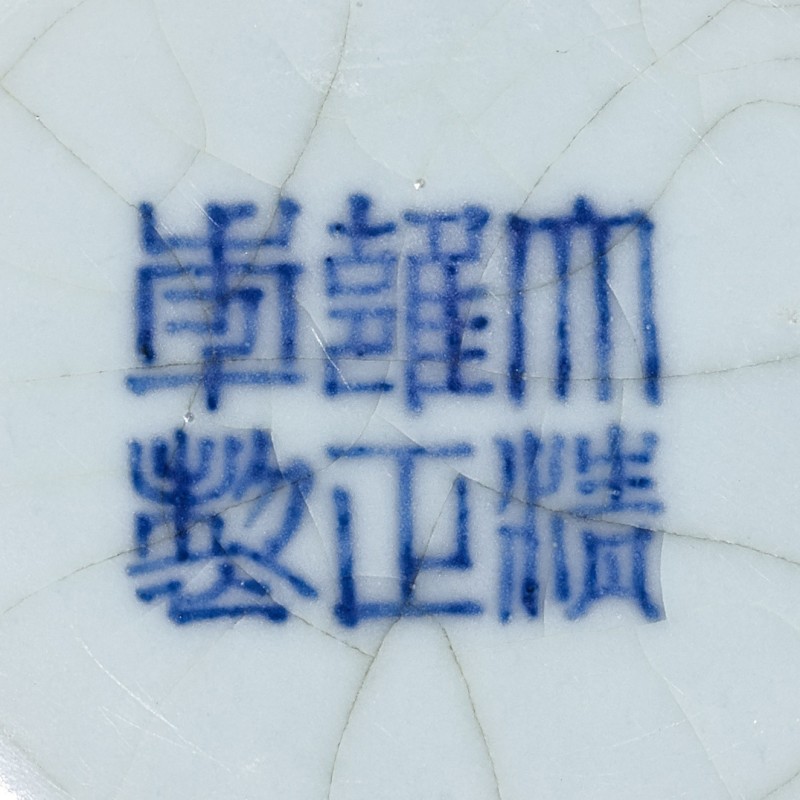
Estimate: 800,000 – 1,200,000 HKD
Description
A very rare pair of small guan-type bottle vases
Seal marks and period of Yongzheng
清雍正 仿官釉直頸瓶一對 《大清雍正年製》款
each exquisitely potted with a globular body rising from a short straight foot to a cylindrical neck and an everted rim, covered overall in an even unctuous pale grayish-blue glaze suffused with a fine network of dark and light crackles, the foot pierced to two sides, the footring applied with dark brown dressing, inscribed to the base with a six-character seal mark in underglaze blue
14.3 cm
Condition Report
Both vases are in very good overall condition, one vase with minor associated pinpricks from the original crackling, including at the mouth rim and above the foot ring.
整體品相良好。一瓶見細小棕眼,包括口沿及圈足上方。
Provenance
Collection of Stephen Junkunc, III (d. 1978), and thence by descent.
Christie’s New York, 21st September 1995, lot 242.
Christie’s Hong Kong, 3rd November 1996, lot 734.
史蒂芬.瓊肯三世(1978年卒)收藏,此後家族傳承
紐約佳士得1995年9月21日,編號242
香港佳士得1996年11月3日,編號734
Catalogue Note
This pair of vases is remarkable for not only its unctuous, bluish crackled glaze which echoes the finest Song prototypes, but also its well-proportioned form and charmingly small size which appear to be unusual during the Yongzheng period. Only one closely related pair of vases is known, covered in a lavender-blue glaze, formerly in the Meiyintang Collection, illustrated in Regina Krahl, Chinese Ceramics from the Meiyintang Collection, vol. 2, London, 1994, pl. 852, and sold in these rooms, 7th April 2011, lot 29. The pair of slits in the foot of these vases is a feature inspired by archaic bronze vessels.
See a pair of vases of slightly different form, moulded with raised bands on the neck and with a galleried rim around the mouth; a larger piece, with two openings on its base as the present pair, preserved in the Palace Museum, Beijing, illustrated in Guanyao ciqi / The Guan Kilns, Beijing, 2016, pl. 63, where the author suggests that it is an imperial copy of a Song vessel in the Qing Court collection. For Song guan ware vessels of this form, see one in the Palace Museum, Beijing, op.cit., pl. 2.
Compare also vases of similar size to the present piece, but of slightly compressed globular shape and without the holes in the foot and the flared mouth rim; see one smaller guan-type vase with a faint crackle and a four-character Yongzheng reign mark sold at Christie’s New York, 20th September 2013, lot 1342; and another guan-type vase, covered in a less glossy, more greyish glaze, preserved in the Palace Museum, Beijing (accession no. Gu-148470).
對瓶形小器大,線條優雅,釉色潤澤,極富宋官窰器神韻和精髓。雍正一朝內之仿作例極稀。拍場上似未見完全相同瓶例,但有一對器形近似,掛天藍釉,屬攻茵堂收藏,於香港蘇富比2011年4月7日賣出,編號29,並刊於康蕊君,《玫茵堂中國陶瓷》,倫敦,1994-2010年,卷2,圖版852。以上瓶例的足部皆有一對穿孔,是受古銅器所啓思。
參考器型略大、瓶頸模印突起弦紋及口部外反、足部同穿雙孔的作例,屬北京故宮收藏,並刊於《官窰瓷器》,北京,2016年,圖版63。著者認為應屬清宮依宋瓷仿作。原形之宋官窰瓶則可參看同書內圖版2。
也可比對大小相近、但較圓渾、無反口及足部穿孔的瓶例,於2013年9月20日紐約佳士得售出,編號1342,及現藏北京故宮一釉色較啞灰作例(藏品編號:故148470)。
参考: 苏富比 3612
中國藝術珍品
清乾隆 仿官釉三犧尊
《大清乾隆年製》款
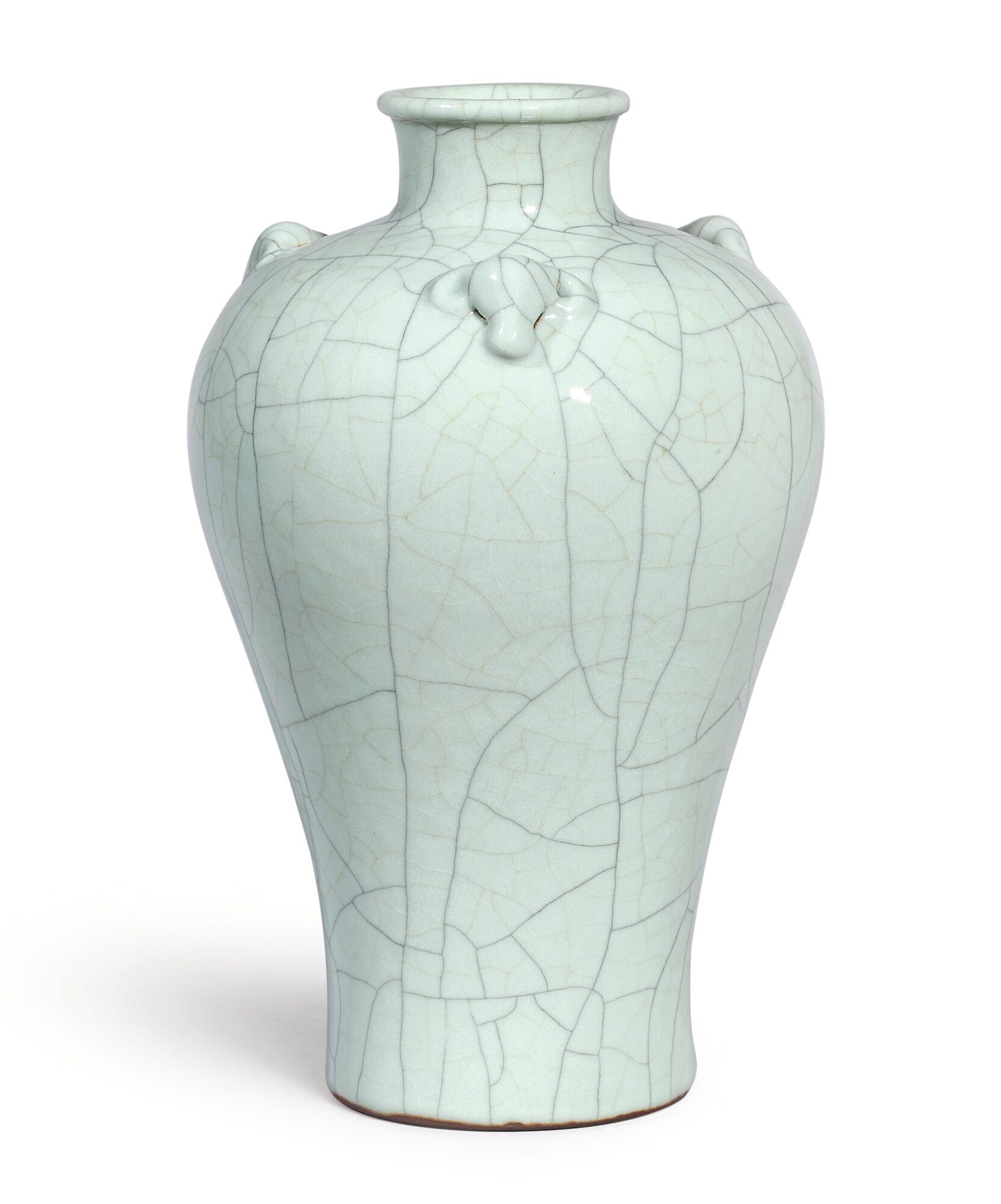
《大清乾隆年製》款

《大清乾隆年製》款
500,000 — 700,000港幣
拍品已售 1,062,500 港幣 成交價 (含買家佣金)
拍品詳情
清乾隆 仿官釉三犧尊
《大清乾隆年製》款
23.4 公分,9 1/4 英寸
狀況報告
口沿約2.3公分小處經磨。器面有爆釉及輕微磨痕,屬正常。
展覽
《世界古美術展覽會》,山中商會及日本美術協會,大阪及東京,1932年,編號688
中國藝術珍品
2017年10月3日 | 下午 2:00 HKT
香港
参考:保利
第42期精品拍卖会
瓷器 玉器 工艺品
0280 明万历 哥釉观音瓶
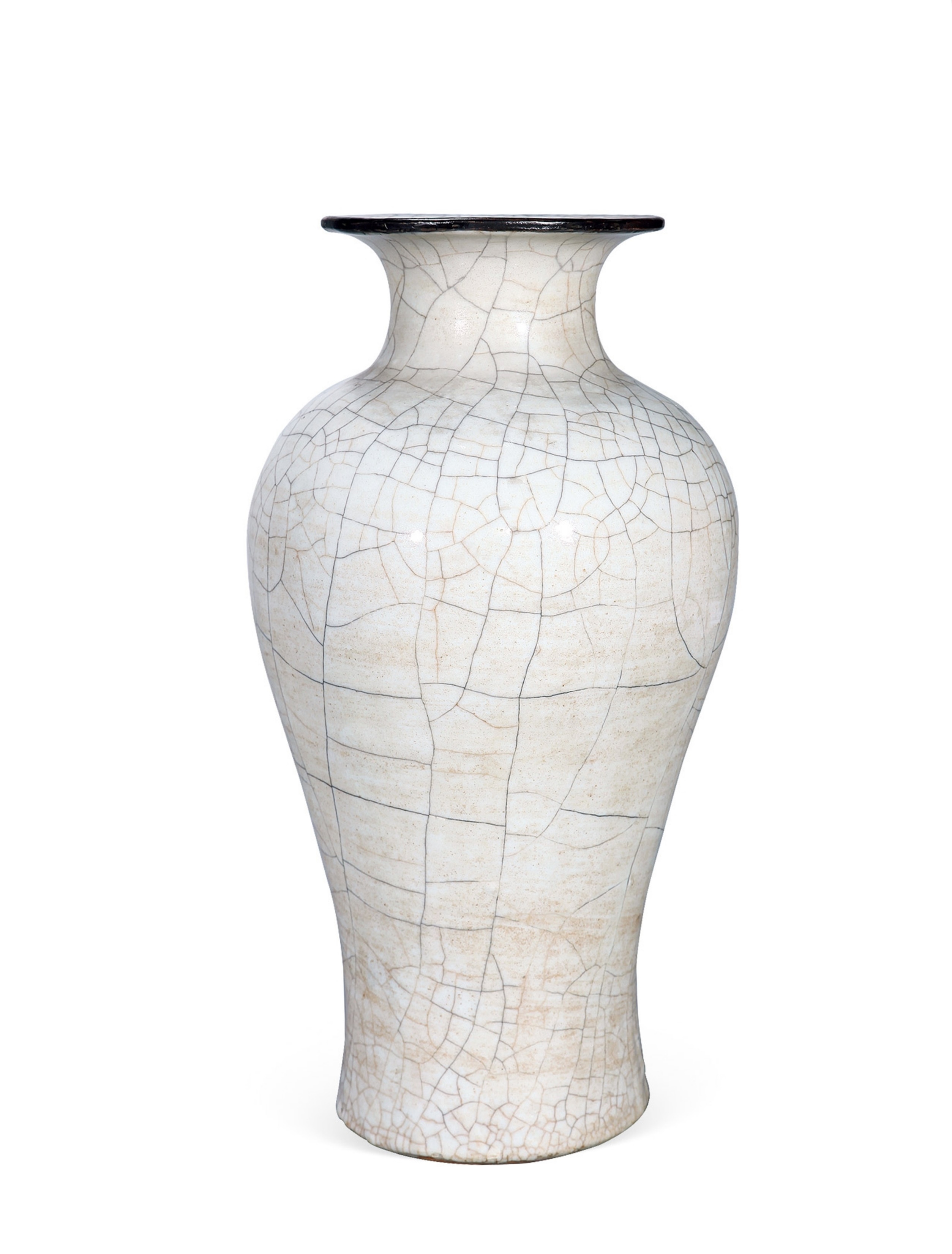
哥釉观音瓶
尺寸 高35.5cm
估价 50,000-80,000
成交价 RMB —
参考: 苏富比 1
玫茵堂珍藏──重要中國御瓷選萃之二
2011年10月5日 | 上午 10:00 HKT
香港
清 雍正 仿哥釉棒槌瓶
A FINE GE-TYPE BOTTLE VASE
SEAL MARK AND PERIOD OF YONGZHENG
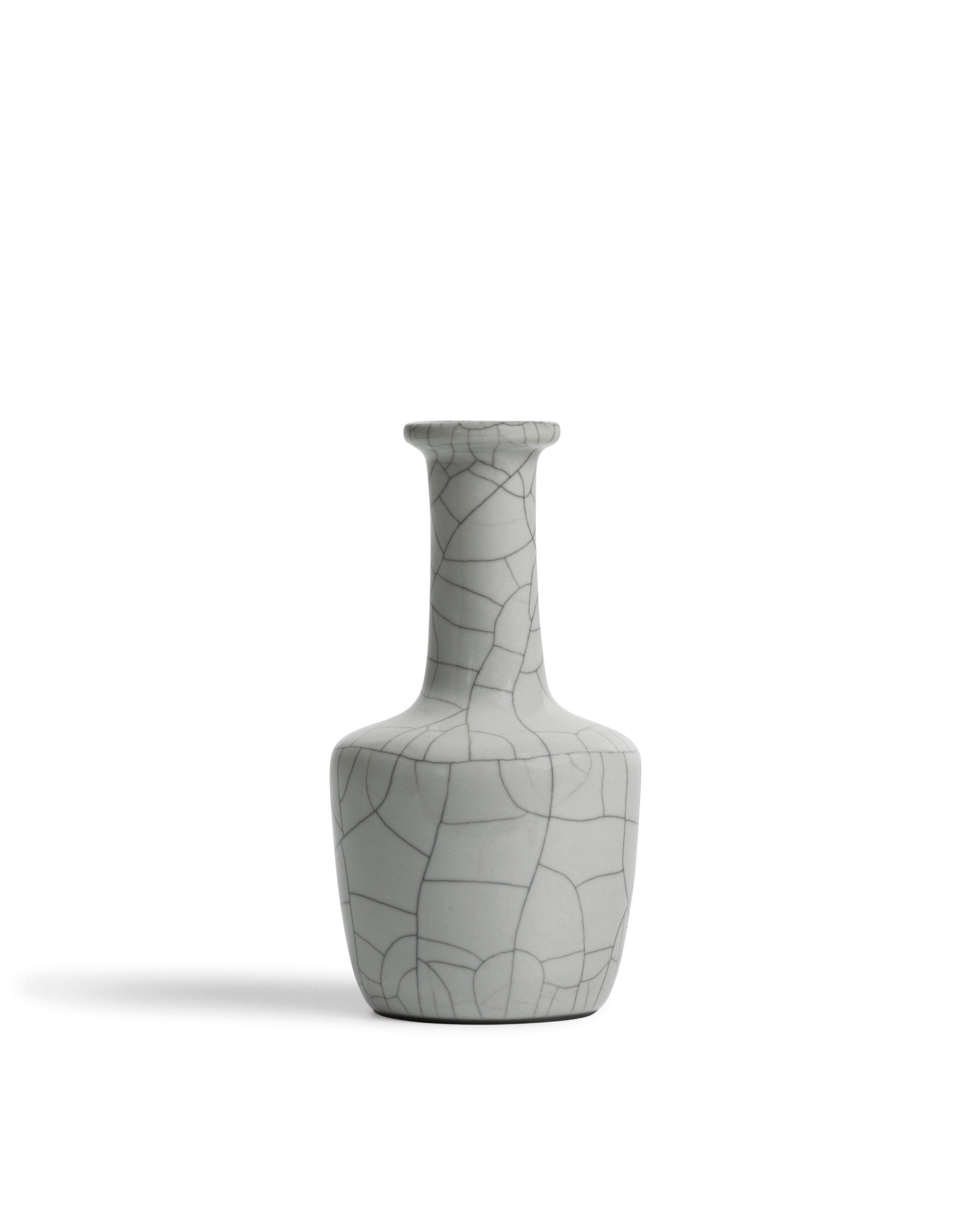
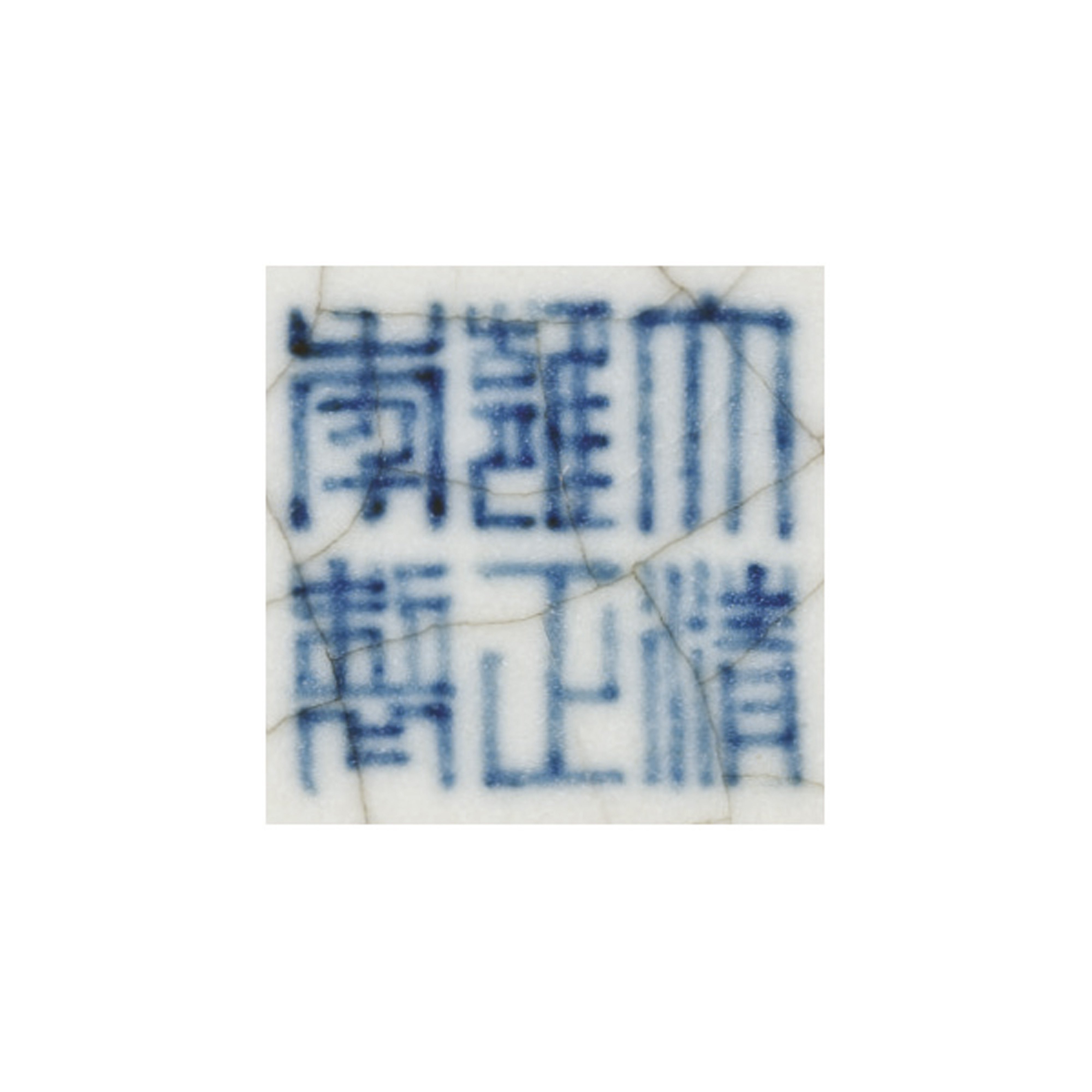
1,000,000 — 1,500,000港幣
拍品已售 4,940,000 港幣 成交價 (含買家佣金)
拍品詳情
A FINE GE-TYPE BOTTLE VASE
SEAL MARK AND PERIOD OF YONGZHENG
of mallet form, the body tapering slightly towards the low footring below a tall columnar neck set with a wide everted mouthrim, covered overall in an even, thick, greenish-grey glaze with large-scale dark-stained crackle, the footring left unglazed revealing the dark brown dressing, the recessed base inscribed with an underglaze-blue six-character reign mark
16.8 cm., 6 5/8 in.
狀況報告
The overall condition is very good. The actual colour is slightly creamier and greener than in the catalogue illustration.
來源
Ralph M. Chait Galleries, New York (label).
出版
Regina Krahl, Chinese Ceramics from the Meiyintang Collection, London, 1994-2010, vol. 4, no. 1793.
相關資料
Apair of Yongzheng vases of this rare shape with Ru-type glazes, from the Huaihaitang collection, was included in the exhibition Ethereal Elegance. Porcelain Vases of the Imperial Qing. The Huaihaitang Collection, The Art Museum, The Chinese University of Hong Kong, Hong Kong, 2007-8, catalogue pl. 24; and for a single Yongzheng vase of this form with a guan-type glaze see Sotheby’s Hong Kong, 30th April 1996, lot 394.
参考: 苏富比 1987
中國瓷器及工藝品
清 雍正 哥釉辅首耳壶
PROPERTY OF A HONG KONG COLLECTOR
A GE-TYPE VASE, HU
SEAL MARK AND PERIOD OF YONGZHENG
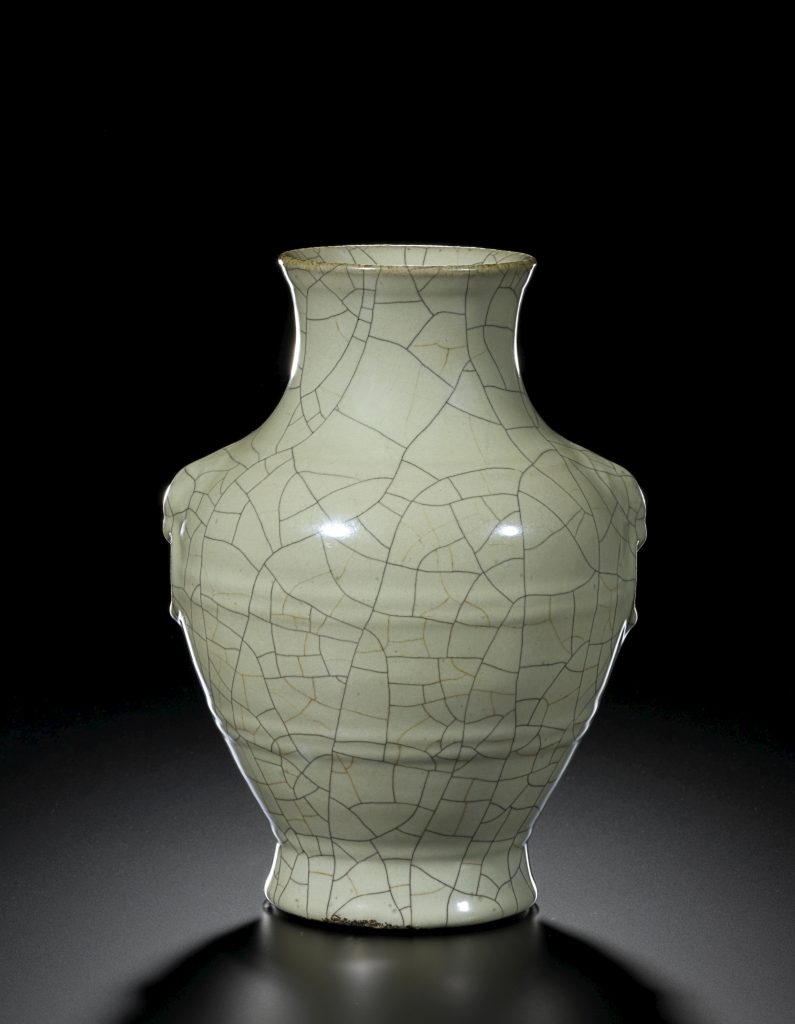
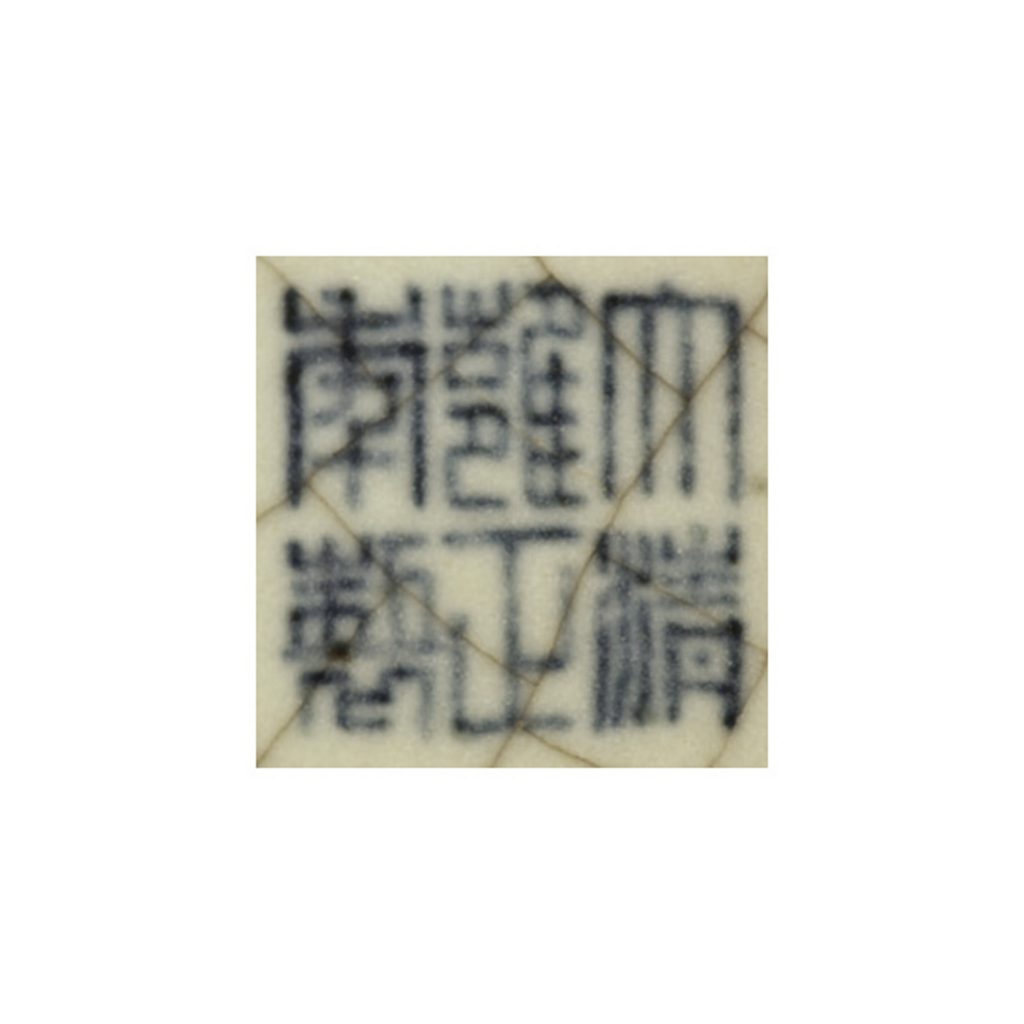
1,200,000 — 1,800,000港幣
拍品已售 1,460,000 港幣 成交價 (含買家佣金)
拍品詳情
A GE-TYPE VASE, HU
SEAL MARK AND PERIOD OF YONGZHENG
of archaistic hu form, the ovoid body supported on a pronounced foot, decorated with two double-raised fillets, gently tapering to a waisted flared neck, flanked by a pair of animal mask and mock-ring handles at the shoulder, applied overall with a soft creamy grey glaze suffused with a matrix of dark and golden crackles stopping, the base similarly glazed and inscribed with a six-character reign mark in underglaze blue, stand
25 cm., 9 7/8 in.
狀況報告
來源
Christie’s Hong Kong, 27th October 2003, lot 706.
相關資料
In its glazing this vase was made to imitate one of the celebrated wares of the Song dynasty, ‘Ge’ ware, while its form derives from archaic bronze prototypes. The combination of a precious glaze and ancient form suggests a deep appreciation and respect for the past, together with the want for its preservation.
It is rare to find Yongzheng vases of this type, although a vase of the same size and form, but covered with a teadust glaze, in the National Palace Museum, Taipei, in included in the Illustrated Catalogue of Ch’ing Dynasty Porcelain in the National Palace Museum, vol. I, Tokyo, 1980, pl. 152. For a Qianlong example with a Guan-type glaze, see one sold in our London rooms, 1st/2nd April 1974, lot 254.
For the inspiration of the form of this vase, see the hu excavated from a Western Han tomb date before 179BC at Qianping, Yichang, Hubei province, illustrated in Kaogu xuebao, 1976, no. 2, p. 124, fig. 12.
中國瓷器及工藝品
2011年10月5日 | 上午 11:30 HKT
香港
参考: 佳士得 拍賣 2152
重要中國瓷器及工藝精品
香港|2003年10月27日
拍品706 清 雍正 哥釉壶
A RARE SMALL GE-TYPE HU
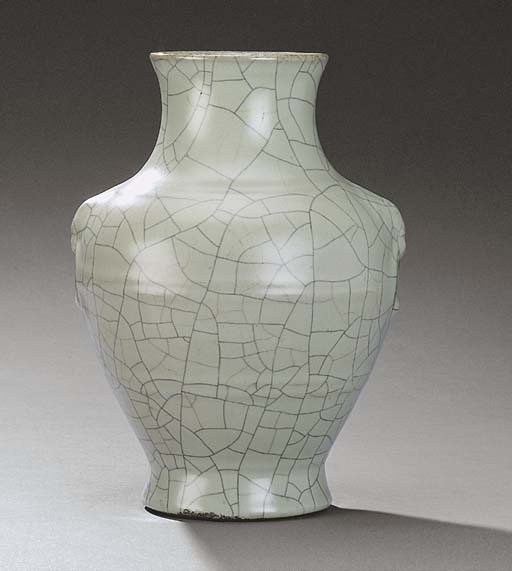
成交總額 HKD 155,350
估價 HKD 150,000 – HKD 200,000
A RARE SMALL GE-TYPE HU
YONGZHENG SIX-CHARACTER SEALMARK AND OF THE PERIOD (1723-1735)
Moulded with three tiers of raised twin bands around the tapering body, the broad shoulders flanked by a pair of moulded monster-masks suspending rings integral with the body, all raised on a spreading foot and covered with a pale grey glaze suffused with a network of wider dark grey and finer golden-brown crackles
9 7/8 in. (25 cm.) high, stand, box
拍品專文
Cf. a larger Yongzheng vase (55.5 cm.) of this shape and with a guan-type glaze, sold in our London Rooms, 6 December 1993, lot 99; a vase of this rare shape and size, covered with a flambé glaze, from the Hall Family Collection, sold at Sotheby’s Hong Kong, 2 May 2000, lot 536; and another with a robin’s-egg glaze in the Beijing Palace Museum, illustrated in Kangxi Yongzheng Qianlong, Hong Kong, 1989, p. 290, pl. 119.
参考:佳士得 拍賣 12290
中國瓷器、工藝品及紡織品(第二部分)
倫敦南肯辛頓|2016年5月13日
拍品619| 清 哥窑玄纹瓶
PROPERTY FROM THE ZEISER COLLECTION
A GE-TYPE CRACKLED BOTTLE VASE
18TH CENTURY
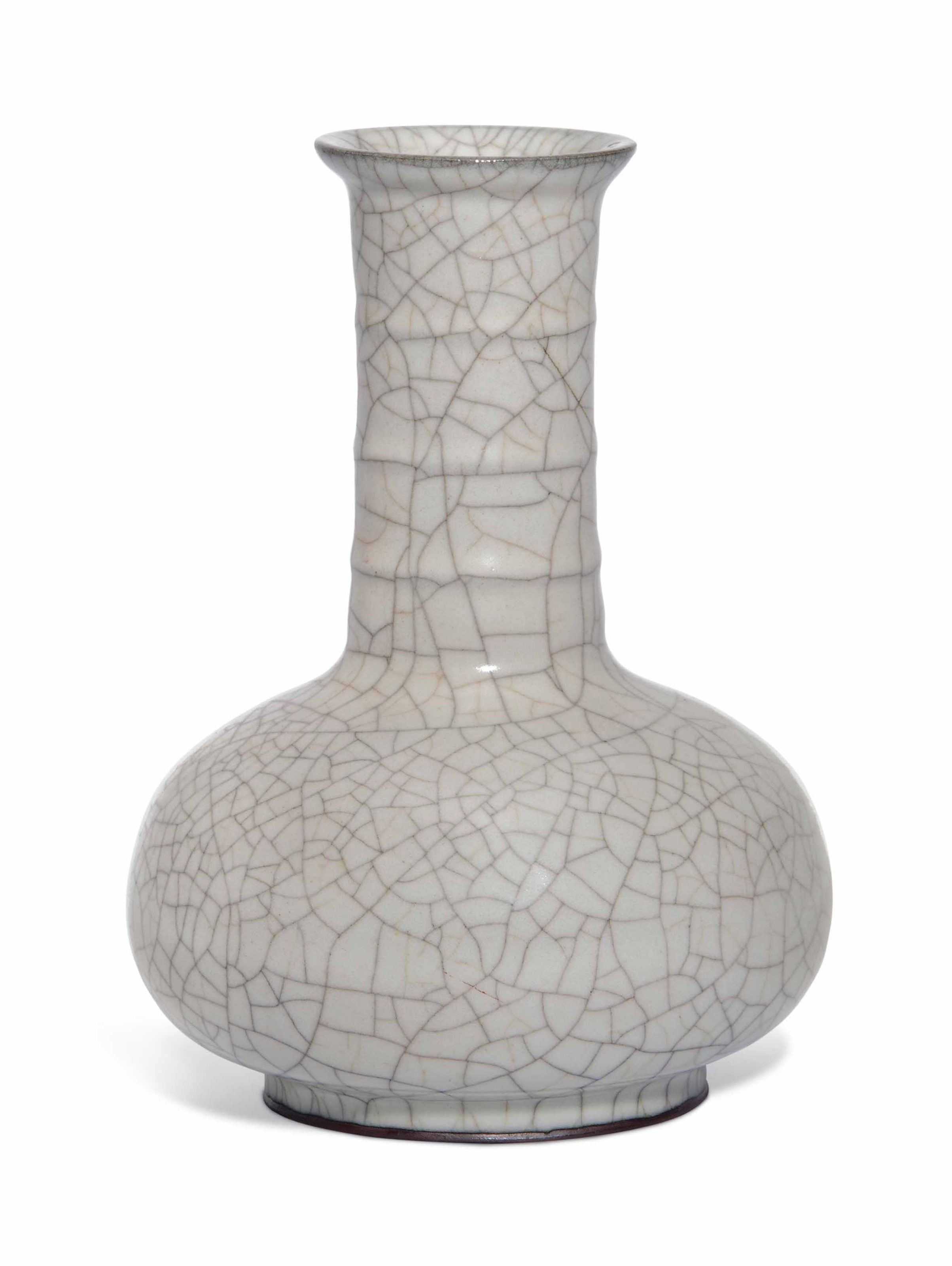
成交總額 GBP 23,750
估價 GBP 1,500 – GBP 2,500
A GE-TYPE CRACKLED BOTTLE VASE
18TH CENTURY
The compressed body is surmounted by a tall neck that is moulded with horizontal ribs. The vase is covered all over with a pale grey glaze suffused with dark grey and russet crackles. The foot rim is mounted with a metal band.
8 ¾ in. (22 cm.) high
來源
Property from the Zeiser Collection.
参考:佳士得 拍賣 14802
亞洲藝術
巴黎|2017年12月13日
拍品69 清十八世紀初 仿哥釉貫耳壺
來源:Dr. Hugh Shire舊藏Desmond Gure舊藏
CHINE, DYNASTIE QING, PREMIER QUART DU XVIIIEME SIECLE
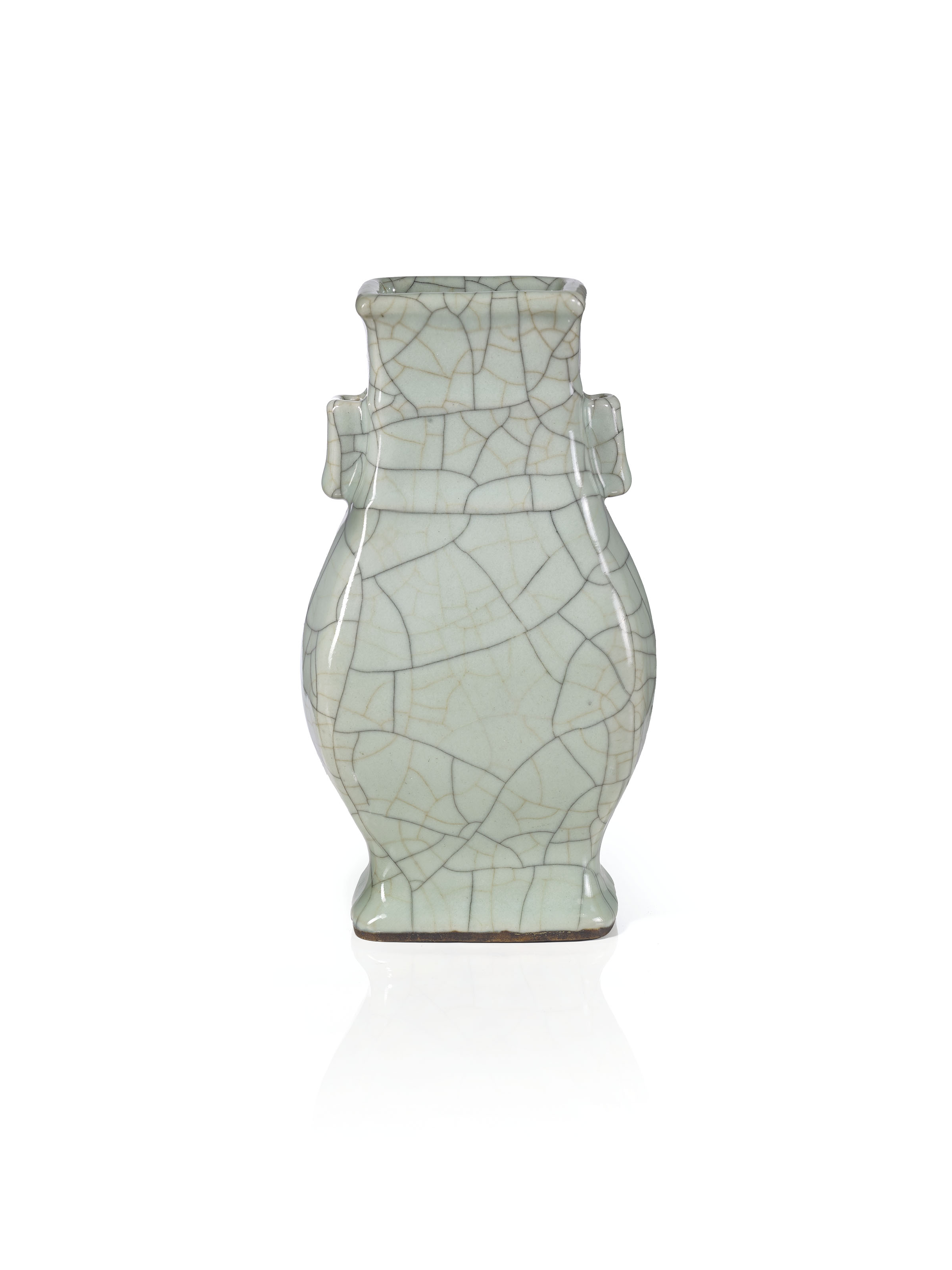
成交總額 EUR 25,000
估價 EUR 20,000 – EUR 30,000
清十八世紀初 仿哥釉貫耳壺
來源:
Dr. Hugh Shire舊藏
Desmond Gure舊藏
Hauteur: 19 cm. (7 ½ in.)
來源
Previously in the collection of Dr. Hugh Shire.
Previously in the collection of Desmond Gure.
拍品專文
The crackles on this vase are known as jinsi tiexian (Gold thread and iron wire), and were deliberately induced during the cooling process and later highlighted by staining. The glaze and black dressing are conscious imitations of Song Ge ware.
See Catalogue of the International Exhibition of Chinese Art, 1935–6, no. 876, in the collection of Sir Percival David. For related Yongzheng examples, see Catalog of the Special Exhibition of K’ang-hsi, Yung-cheng and Ch’ien-lung Porcelain Ware from the Ch’ing Dynasty in the National Palace Museum, no. 63; Lam, Ethereal Elegance: Porcelain Vases of the Imperial Qing, The Huaihaitang Collection, no. 39, pp. 160–1; and Tie, The Complete Collection of Porcelain of Jiangxi Province: Porcelain of the Qing Dynasty (I), p. 113. Note also Catalogue of a Special Exhibition of Ch’ing Dynasty Monochrome Porcelains in the National Palace Museum, no. 80, for a Guan-glazed example; and Xu, Treasures in the Royalty: The Official Kiln Porcelain of the Qing Dynasty, p. 205, for a rust-glazed version.
編製圖錄及詳情
Post Lot Text
A GE-TYPE VASE, FANGHU
CHINA, QING DYNASTY, FIRST QUARTER OF THE 18TH CENTURY
参考:佳士得 拍賣 13981
中國瓷器及工藝精品
倫敦|2017年5月9日
拍品120 明 仿哥釉罐
A GE-TYPE GLAZED JAR, GUAN
MING DYNASTY, 15TH CENTURY
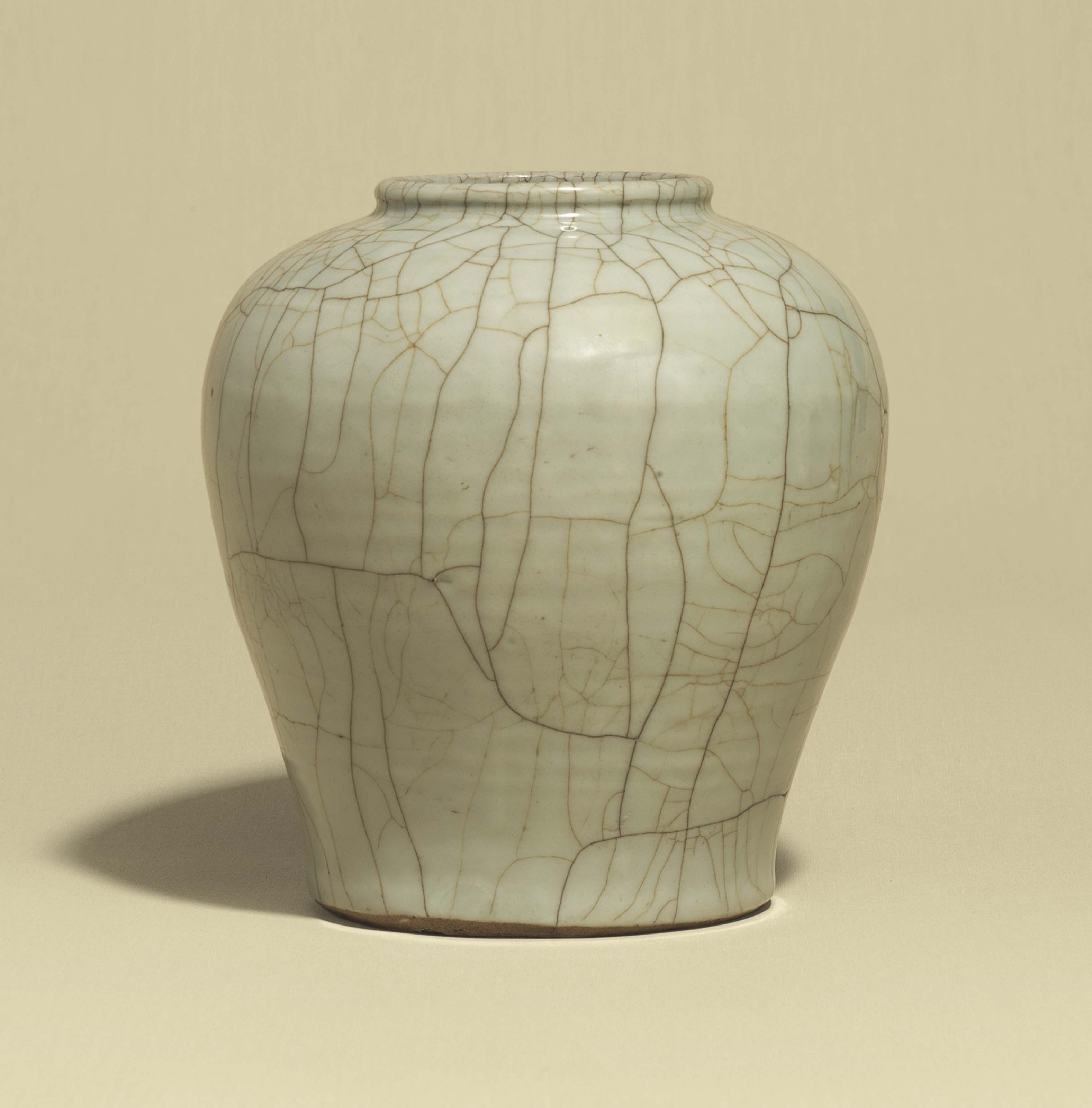
成交總額 GBP 12,500
估價 GBP 10,000 – GBP 15,000
A GE-TYPE GLAZED JAR, GUAN
MING DYNASTY, 15TH CENTURY
The jar is glazed overall with a greenish-grey glaze suffused with two layers of crackle, one thick and dark, the other thin and golden, jinsitiexian, meaning gold floss and iron thread. The base with a diamond-shaped area left unglazed.
8 ½ in. (21.5 cm.) high
参考:佳士得 拍賣 13981
中國瓷器及工藝精品
倫敦|2017年5月9日
拍品119 大清乾隆 仿哥釉小香炉
A CRACKLE-GLAZED GUAN-TYPE SMALL CENSER
QIANLONG SIX-CHARACTER SEAL MARK IN UNDERGLAZE BLUE AND PROBABLY OF THE PERIOD (1736-1795)
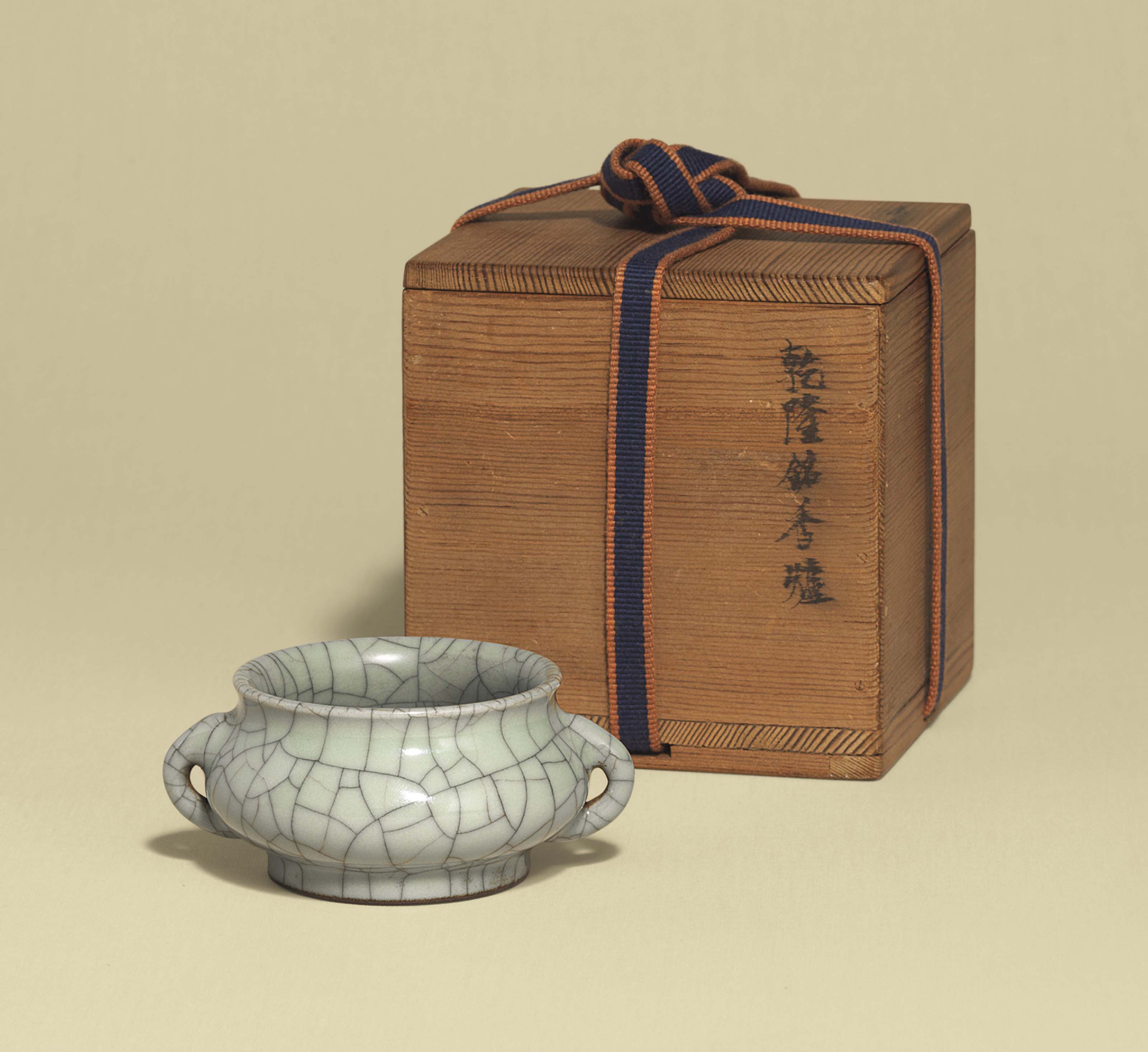
成交總額 GBP 17,500
估價 GBP 10,000 – GBP 15,000
A CRACKLE-GLAZED GUAN-TYPE SMALL CENSER
QIANLONG SIX-CHARACTER SEAL MARK IN UNDERGLAZE BLUE AND PROBABLY OF THE PERIOD (1736-1795)
The delicately formed bombe-form censer is applied with two loop handles that extend from the shoulder to the foot. It is covered overall with a grey-celadon glaze suffused with a network of dark and light gold crackles. The foot rim is covered in a brown wash.
3 ½ in. (9 cm.) wide across the handles
來源
Property from a private UK collection.
参考:佳士得 拍賣 16245
亞洲藝術
巴黎|2018年12月12日
拍品157 清 乾隆 仿官釉方壶
GUAN TYPE CELADON PORCELAIN VASE, FANGHU CHINA, QING DYNASTY, BRAND WITH SIX CHARACTERS IN BLUE SEAL IN COVER AND QIANLONG PERIOD (1736-1795)
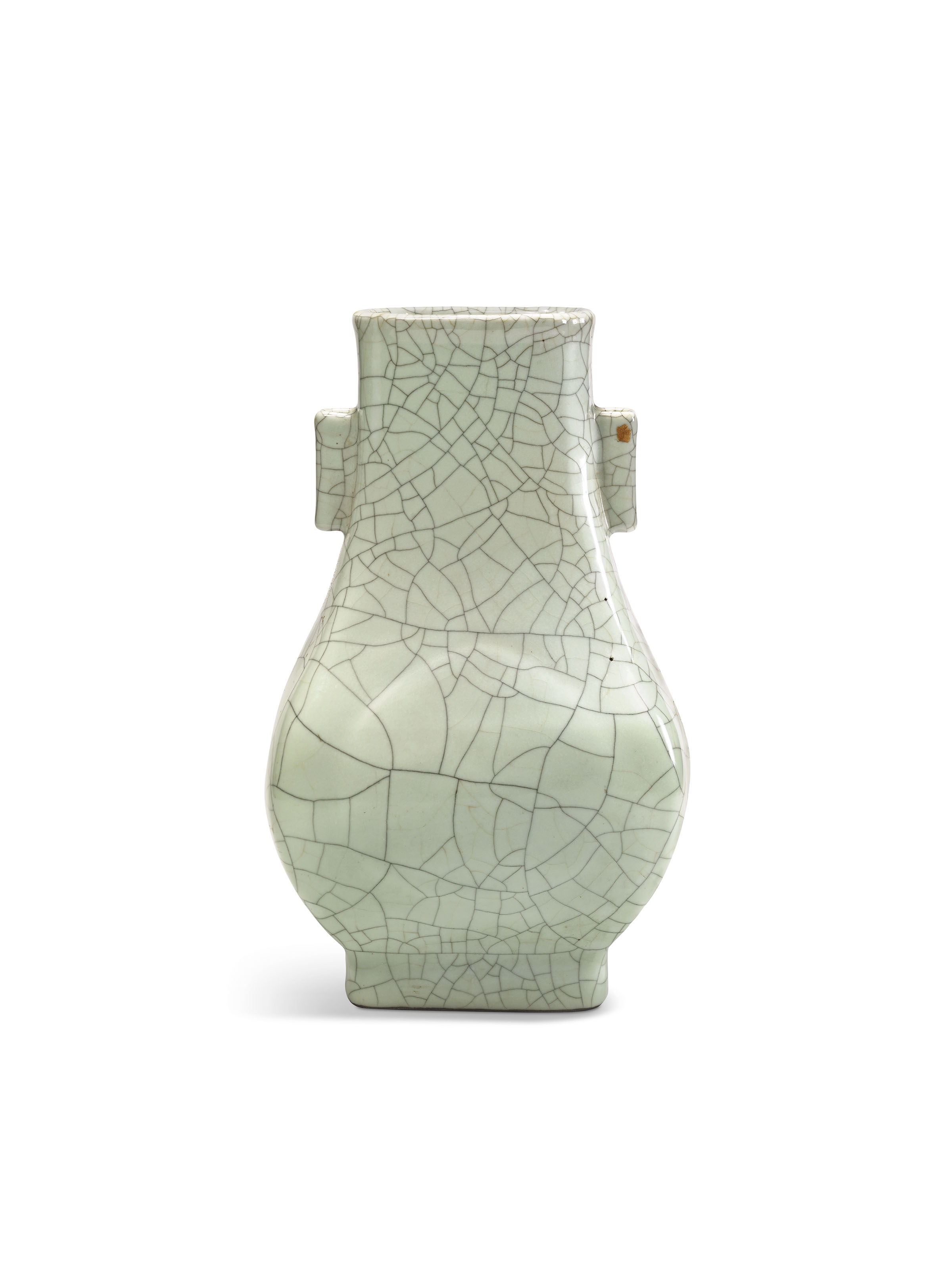
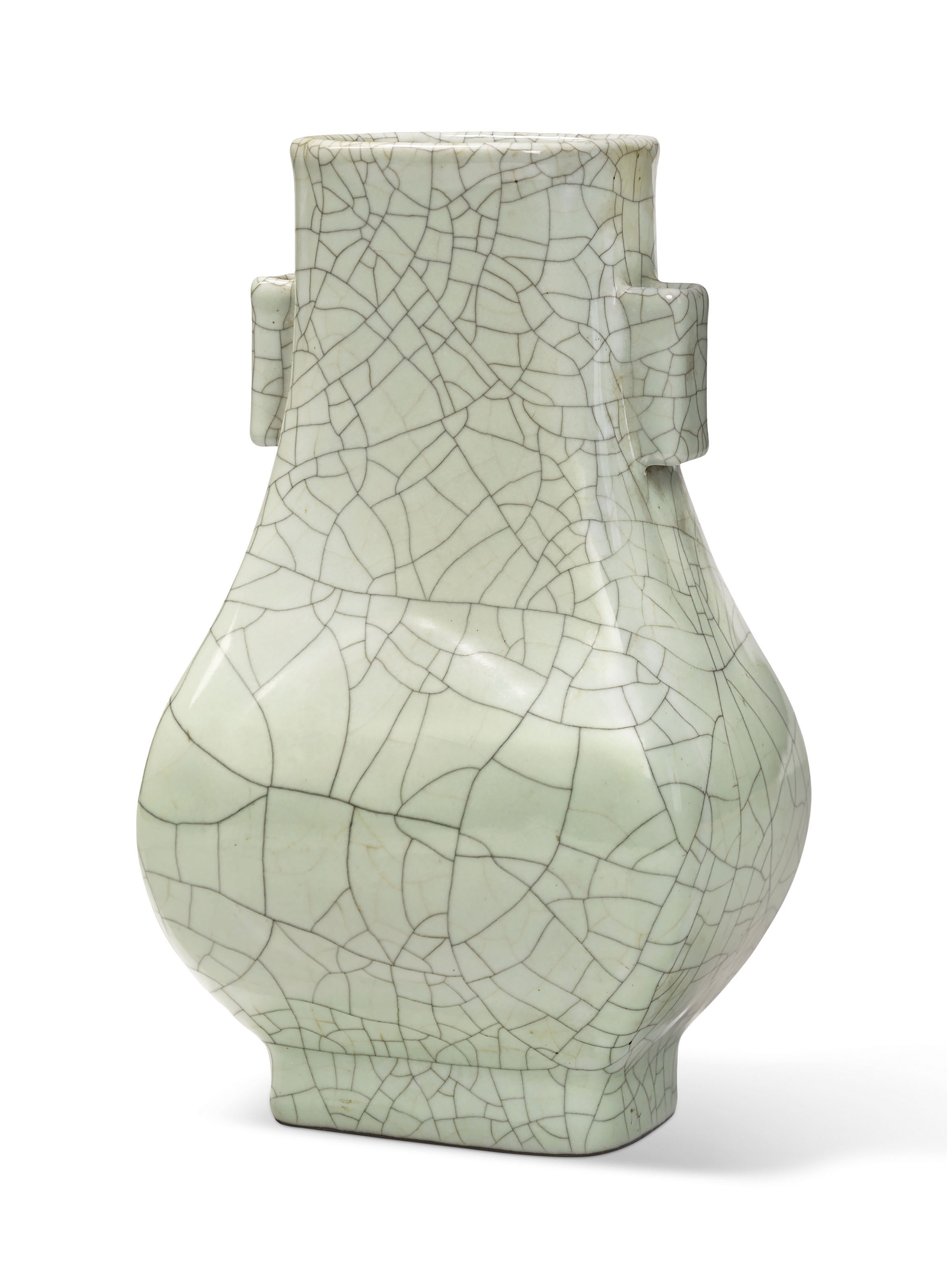
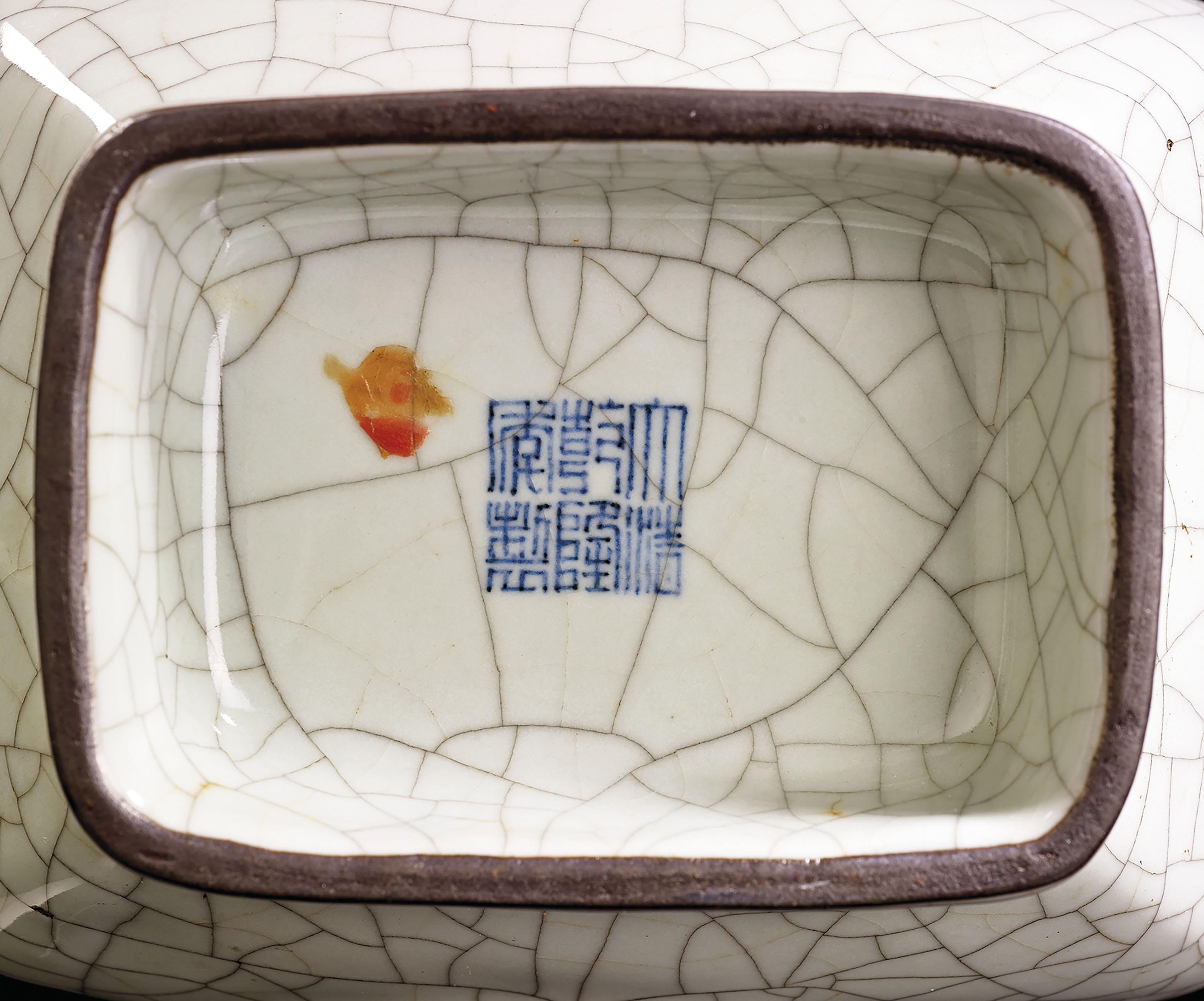
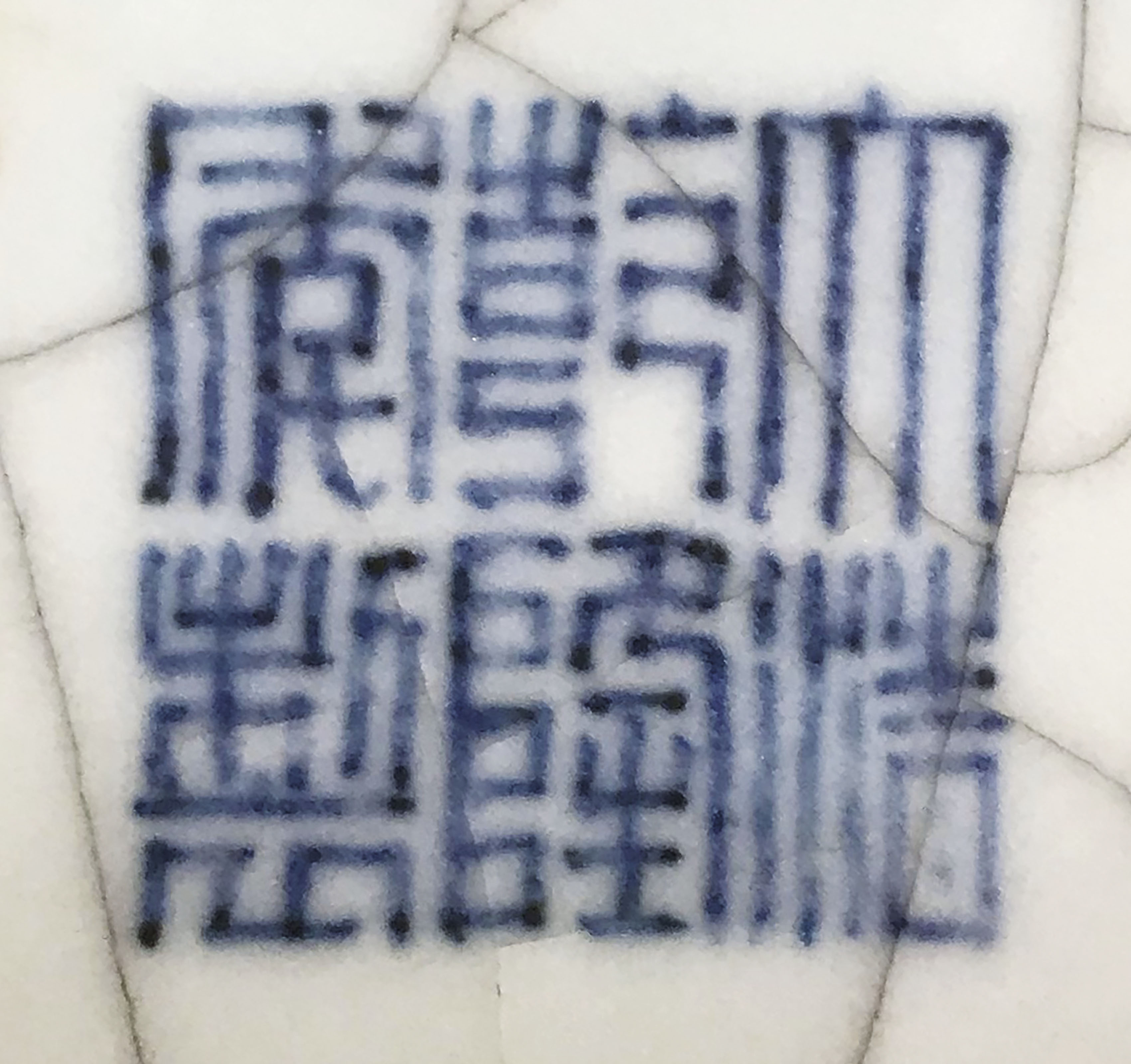
成交總額 EUR 75,000
估價 EUR 60,000 – EUR 80,000
GUAN TYPE CELADON PORCELAIN VASE, FANGHU CHINA, QING DYNASTY, SIX MARK CHARACTERS IN BLUE STAMP UNDER COVER AND QIANLONG PERIOD (1736-1795)
Round hexagonal in shape, fully covered with a finely infused blue-gray glaze black and brown cracks. The flared neck is flanked by a pair of tubular handles.
Height: 31 cm. (12 ¼ in.)
來源
Property of a French noble family, acquired by the present owner’s great-grandfather in the early 20th century.
拍品專文
Archaism as a major theme in the crafts of the Qing dynasty, is represented two-fold on the present lot. The fanghu shape is derived from early bronze wares of the Shang and Zhou dynasties, while the glaze is an imitation of the Southern Song dynasty Guan glaze. Compare the present vase with its Song prototype, a small Guan vase with canted corners in the Freer Gallery of Art, Washington D.C., illustrated in Oriental Ceramics, Kodansha Series, Japan, 1981, vol. 9, Japan, 1987, no. 960; and another sold at Christie’s Hong Kong, 30 May 2005, lot 1513.
編製圖錄及詳情
Post Lot Text
A GUAN-TYPE GLAZED VASE, FANGHU
CHINA, QING DYNASTY, QIANLONG SIX-CHARACTER SEAL MARK IN UNDERGLAZE BLUE AND OF THE PERIOD (1736-1795)
参考:佳士得 拍賣 16314
中國藝術:紐約夏季網上拍賣網上|2018年 7月 11 – 18日
拍品 19
清十八/十九世紀 仿哥釉花口洗
18TH-19TH CENTURY
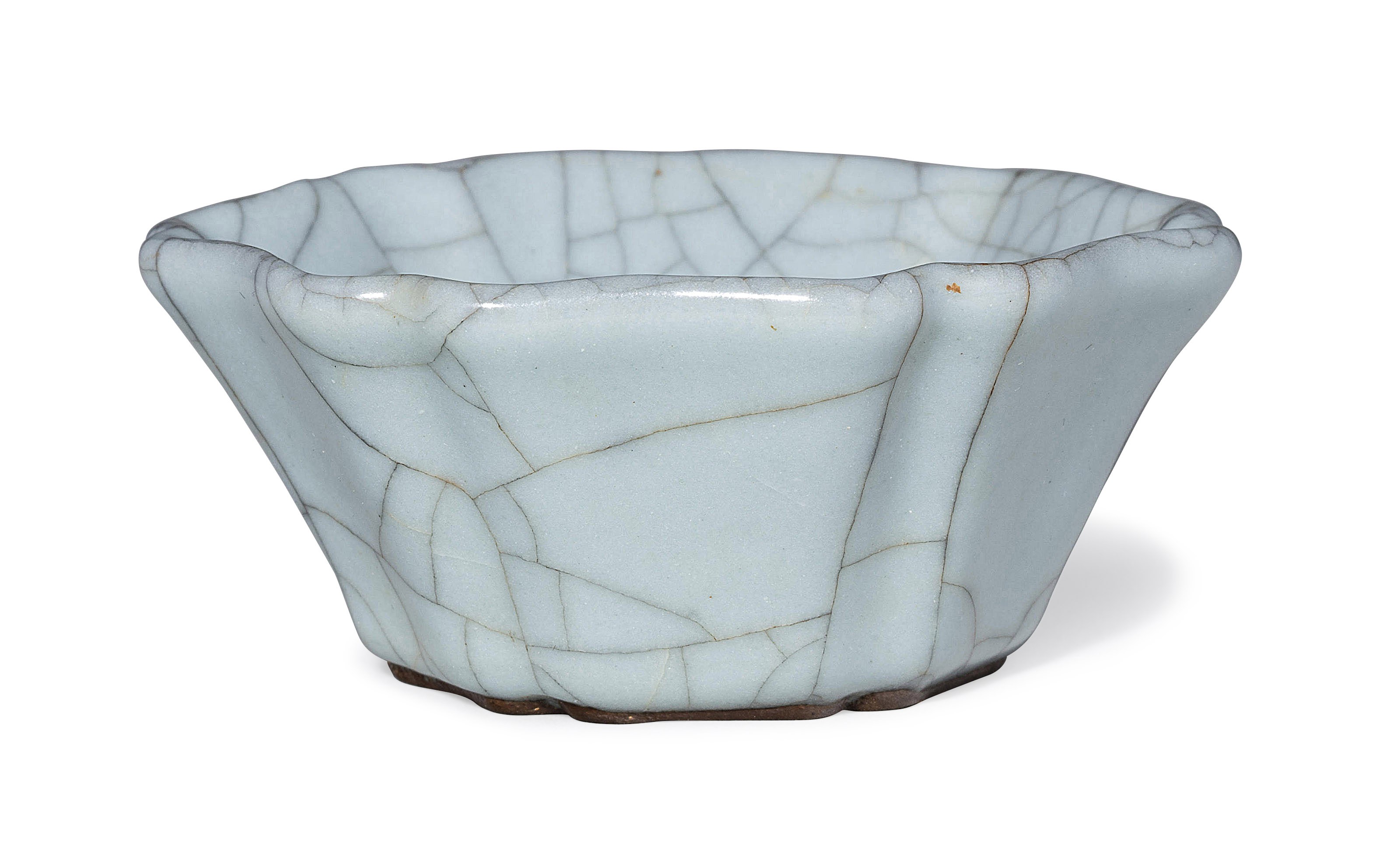
清十八/十九世紀 仿哥釉花口洗
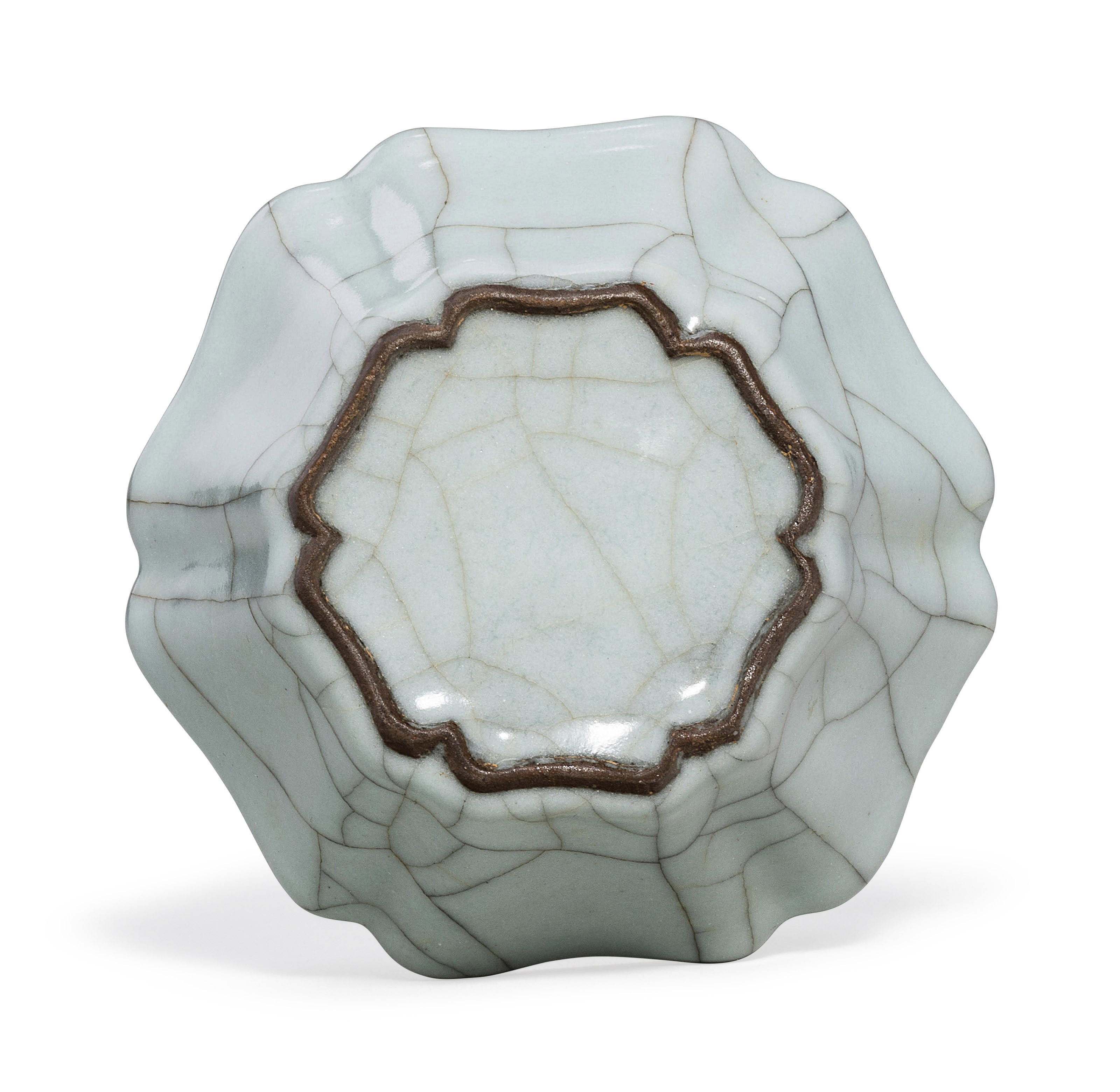
清十八/十九世紀 仿哥釉花口洗
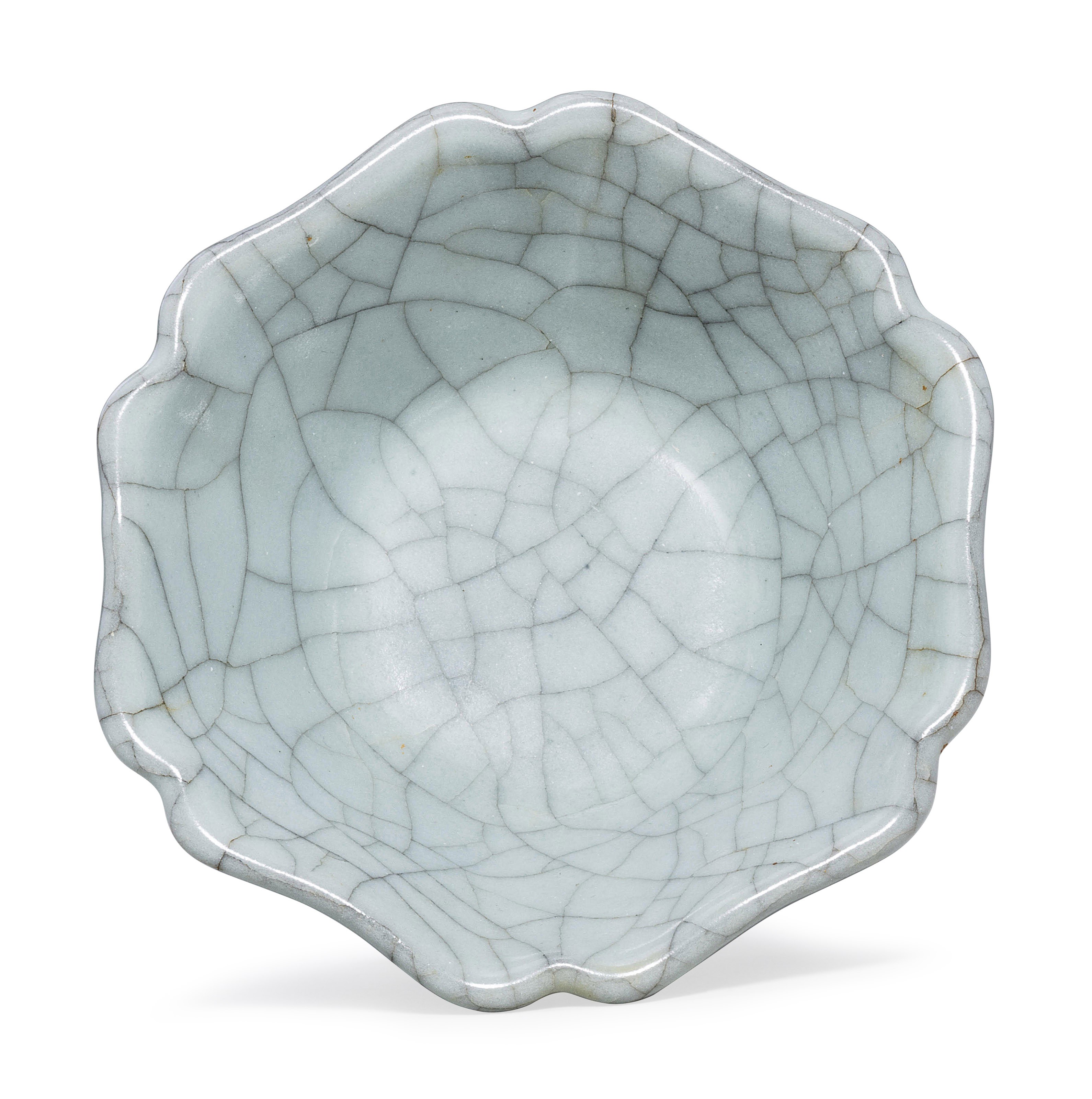
清十八/十九世紀 仿哥釉花口洗
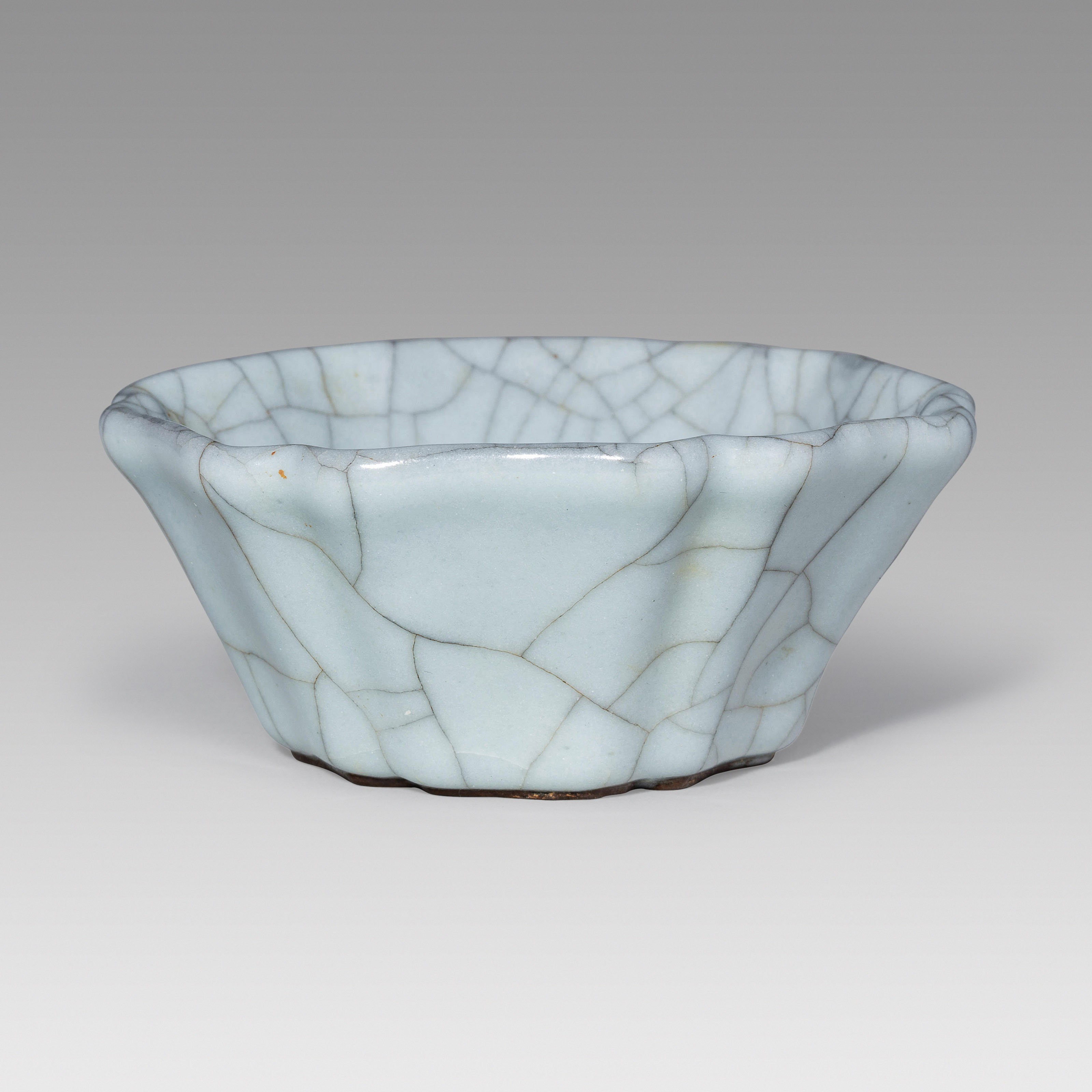
清十八/十九世紀 仿哥釉花口洗
估價: USD 4,000 – USD 6,000
(CAD 5,307.20 – CAD 7,960.80)
成交價: USD 16,250
The vessel is covered with a glaze of pale blue tone suffused with a network of black and brown crackle.
3 1/4 in. (8.3 cm.) diam.
参考:佳士得拍賣 15487
中國瓷器及工藝精品
倫敦|2018年5月15日
拍品175|PROPERTY FROM A PRIVATE SCOTTISH COLLECTION
清乾隆 仿官窯小瓶 四字篆書款
來源:蘇格蘭私人珍藏
QIANLONG FOUR-CHARACTER SEAL MARK IN UNDERGLAZE BLUE AND OF THE PERIOD (1736-1795)
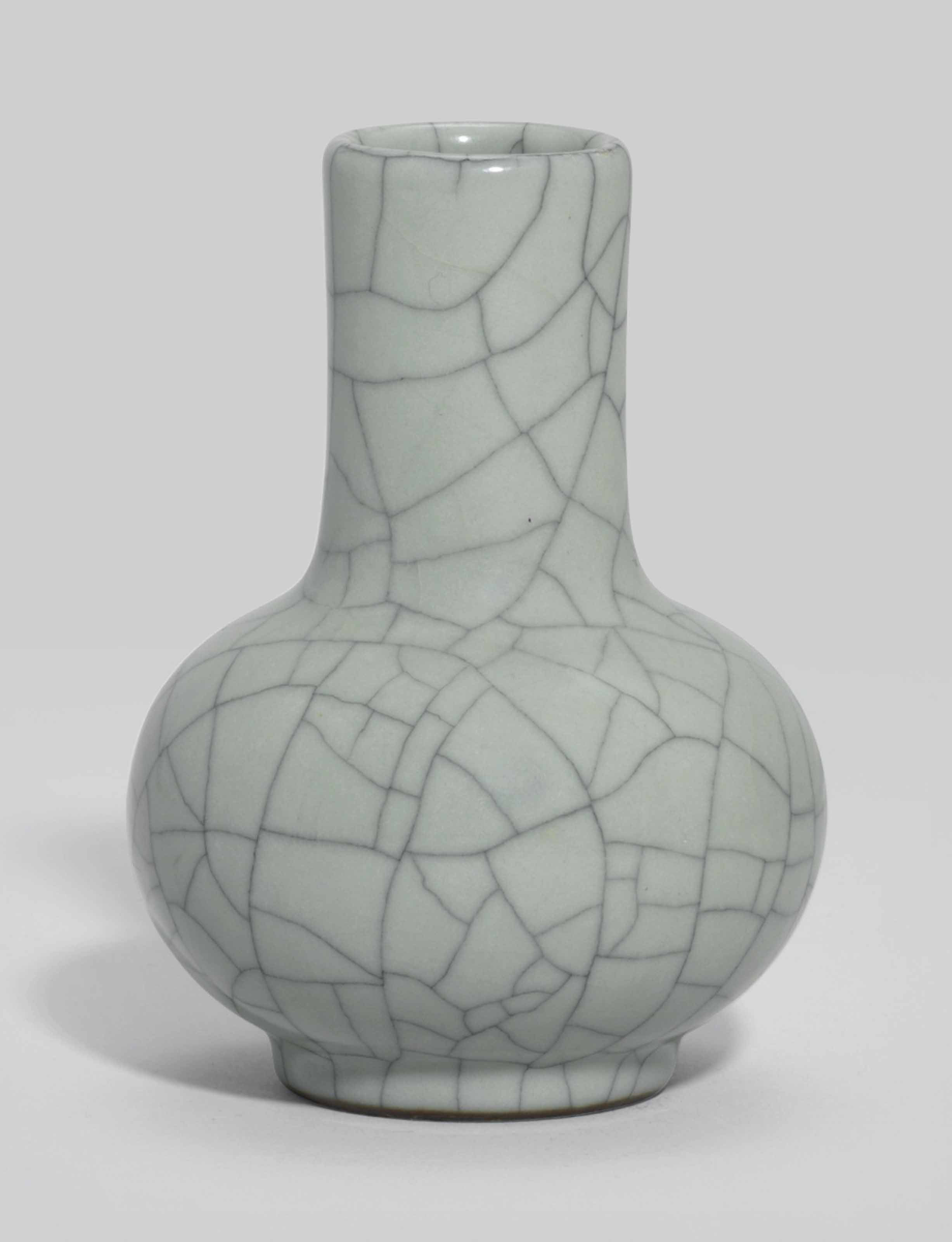
成交總額 GBP 68,750
估價 GBP 10,000 – GBP 20,000
清乾隆 仿官窯小瓶 四字篆書款
來源:蘇格蘭私人珍藏
4 1/8 in. (10.5 cm.) high
拍品專文
Compare a small Ge-type bottle vase with a Qianlong four-character mark illustrated in Ethereal Elegance, Porcelain Vases in the Imperial Qing, the Huaihaitang Collection, The Chinese University of Hong Kong, 2007, no.48, p 178. Similarly, compare with a guan-type small Qianlong mark and period bottle vase from the same collection and illustrated in the same book, no. 36, p 154. A very similar but slightly smaller (10 cm. high) vase also with a Qianlong four-character mark from the collection of Stephen Junkunc III was sold at Christie’s New York, 19 March 2008, lot 633.
編製圖錄及詳情
拍品前備註
PROPERTY FROM A PRIVATE SCOTTISH COLLECTION
参考:佳士得 拍賣 16321古今|
網上拍賣: 中國藝術集珍網上|2018年 4月 4 – 12日
拍品 8 亞洲私人珍藏
清十八/十九世紀 仿哥釉直頸瓶
QING DYNASTY, 18TH-19TH CENTURY
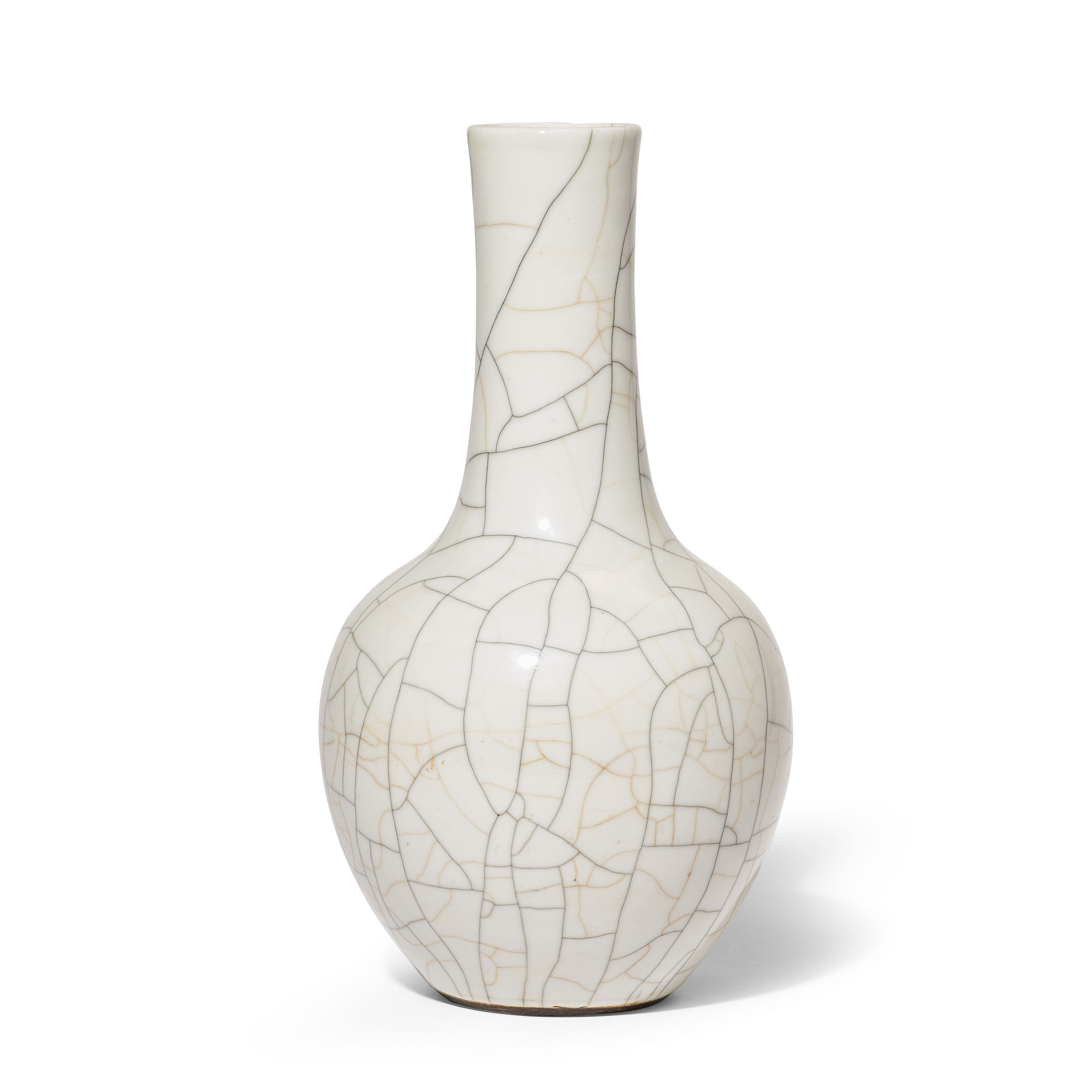
清十八/十九世紀 仿哥釉直頸瓶
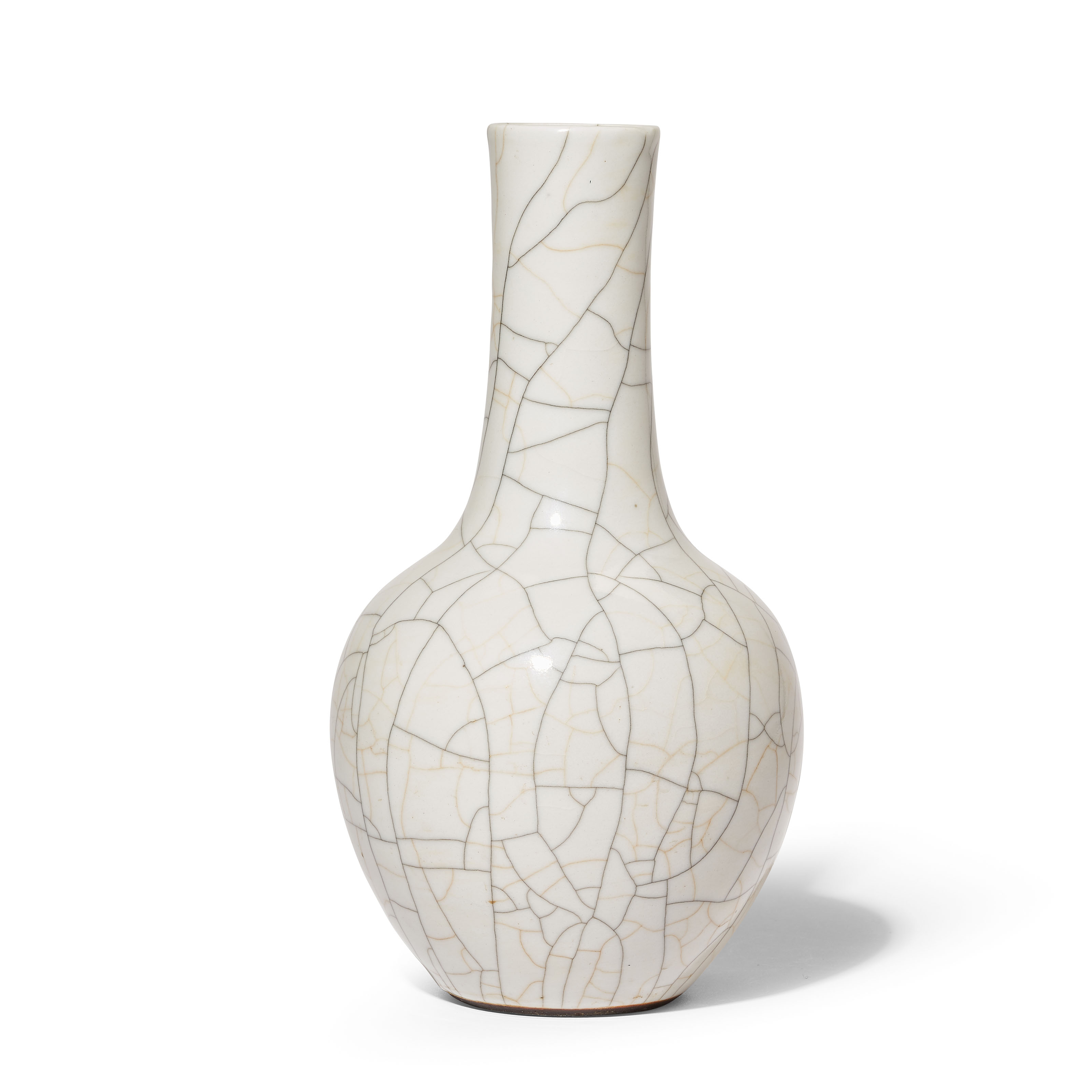
清十八/十九世紀 仿哥釉直頸瓶
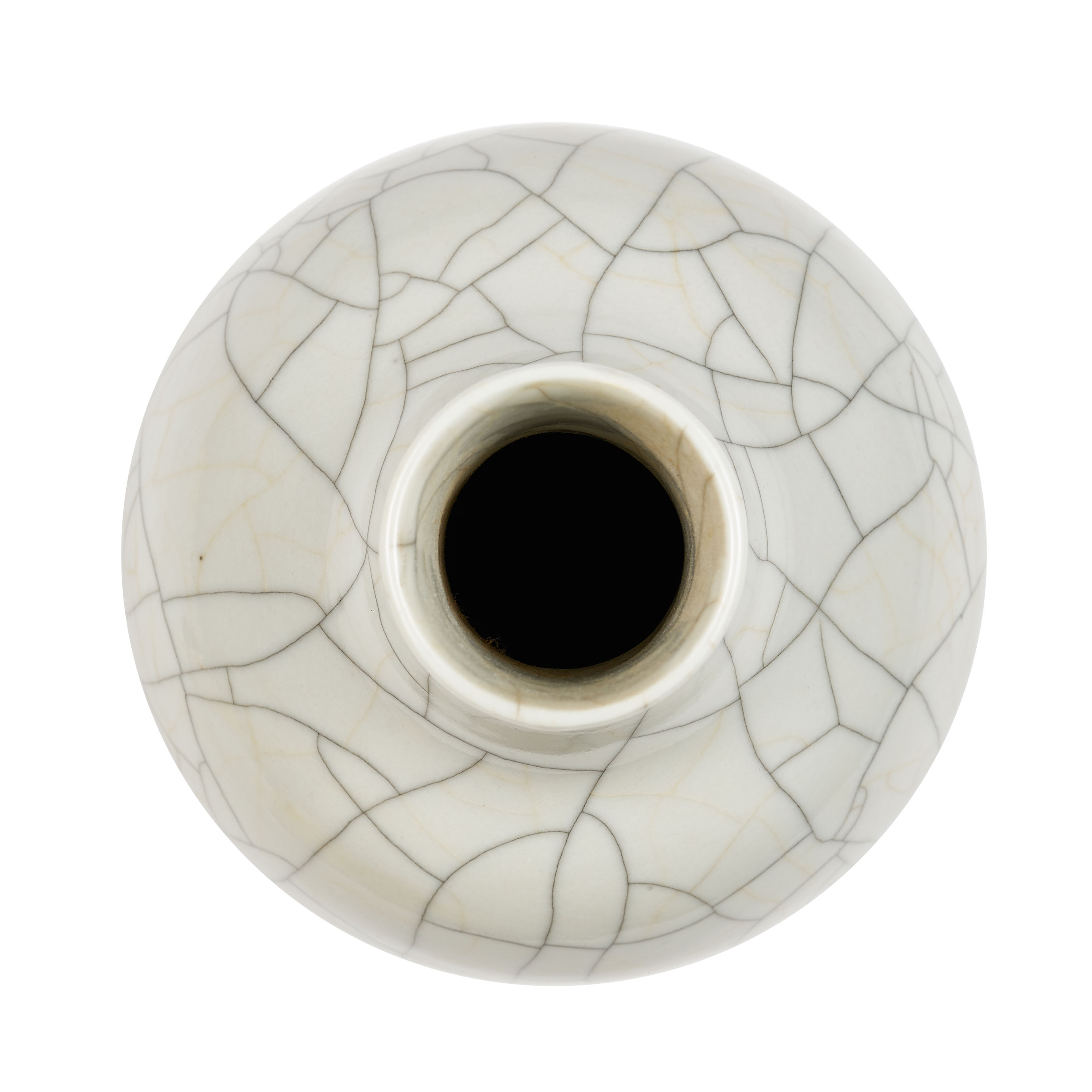
清十八/十九世紀 仿哥釉直頸瓶
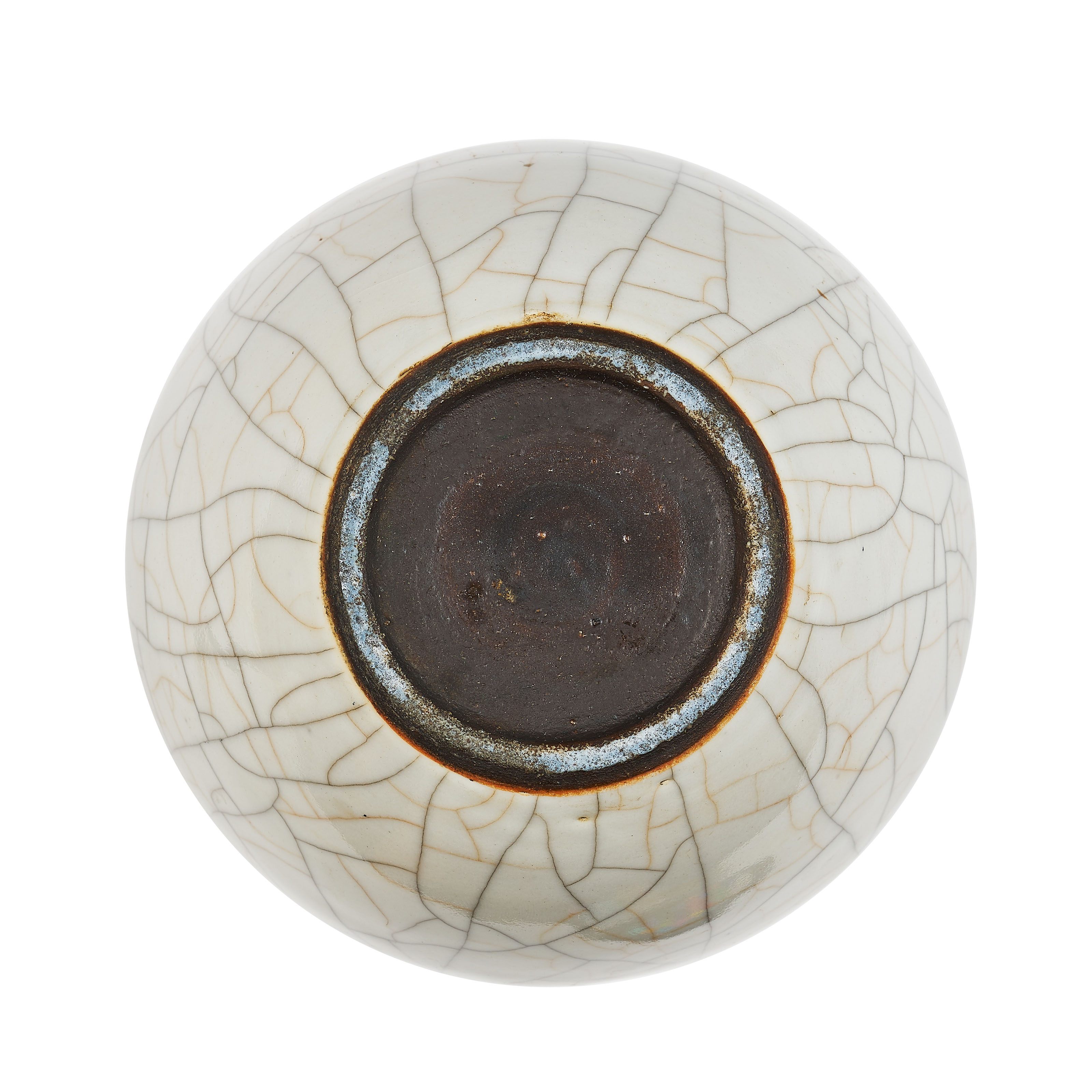
清十八/十九世紀 仿哥釉直頸瓶
估價: HKD 10,000 – HKD 20,000
(CAD 1,582 – CAD 3,164)
成交價: HKD 68,750
The vase has a bulbous body with a sloping shoulder rising to a cylindrical neck. It is covered overall with a pale grey crackled glaze. The ring foot and the base are unglazed and dressed in a brown wash.
8⅝ in. (22 cm.), high, box
請注意,此拍品為私人藏家所有。
來源
1980年代購於台北
参考: 佳士得拍賣 15449
中國瓷器及工藝精品
紐約|2018年3月22日 – 23日
拍品717|THE PROPERTY OF A PRIVATE COLLECTOR
明 哥釉小方洗
MING DYNASTY (1368-1644)
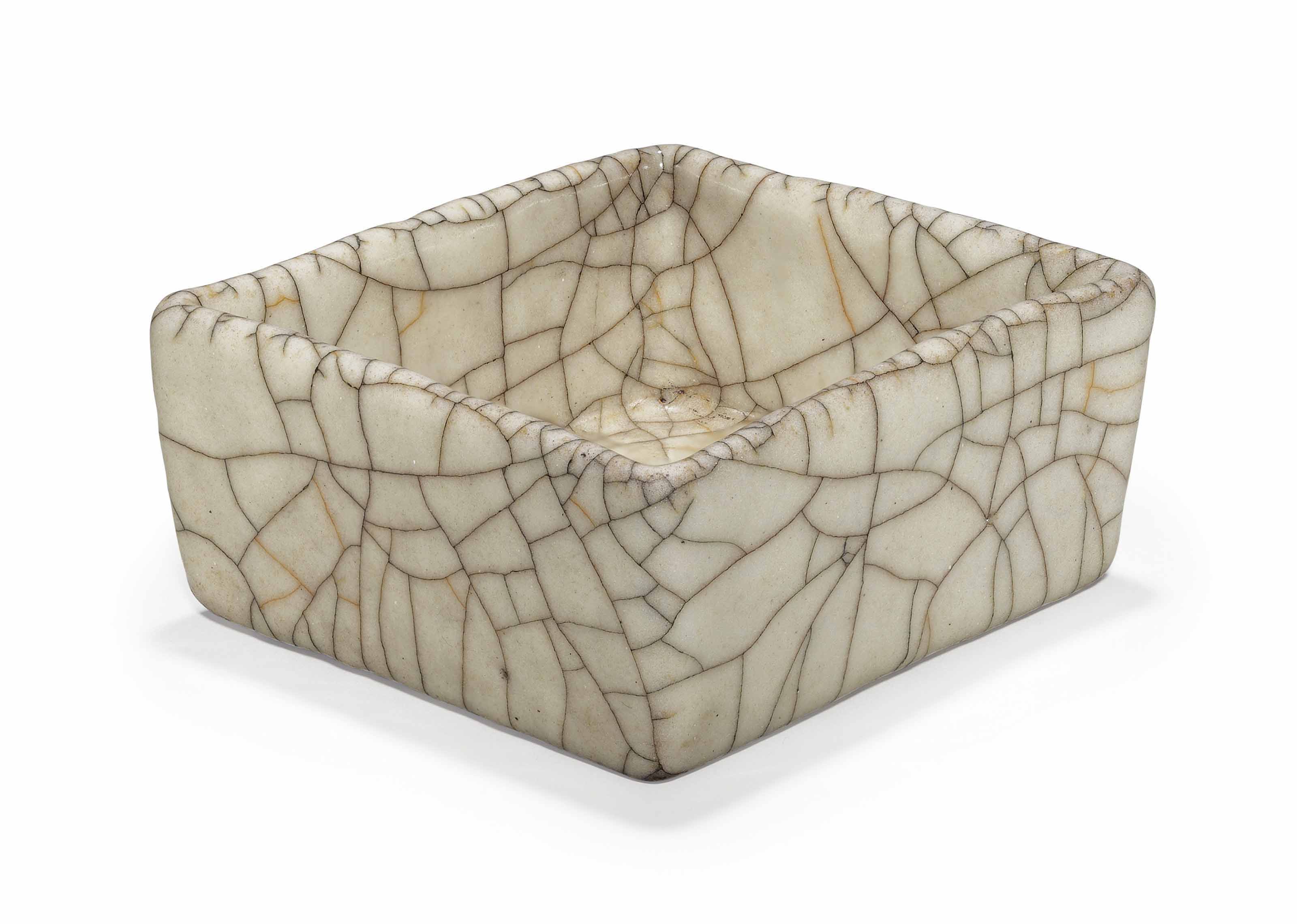
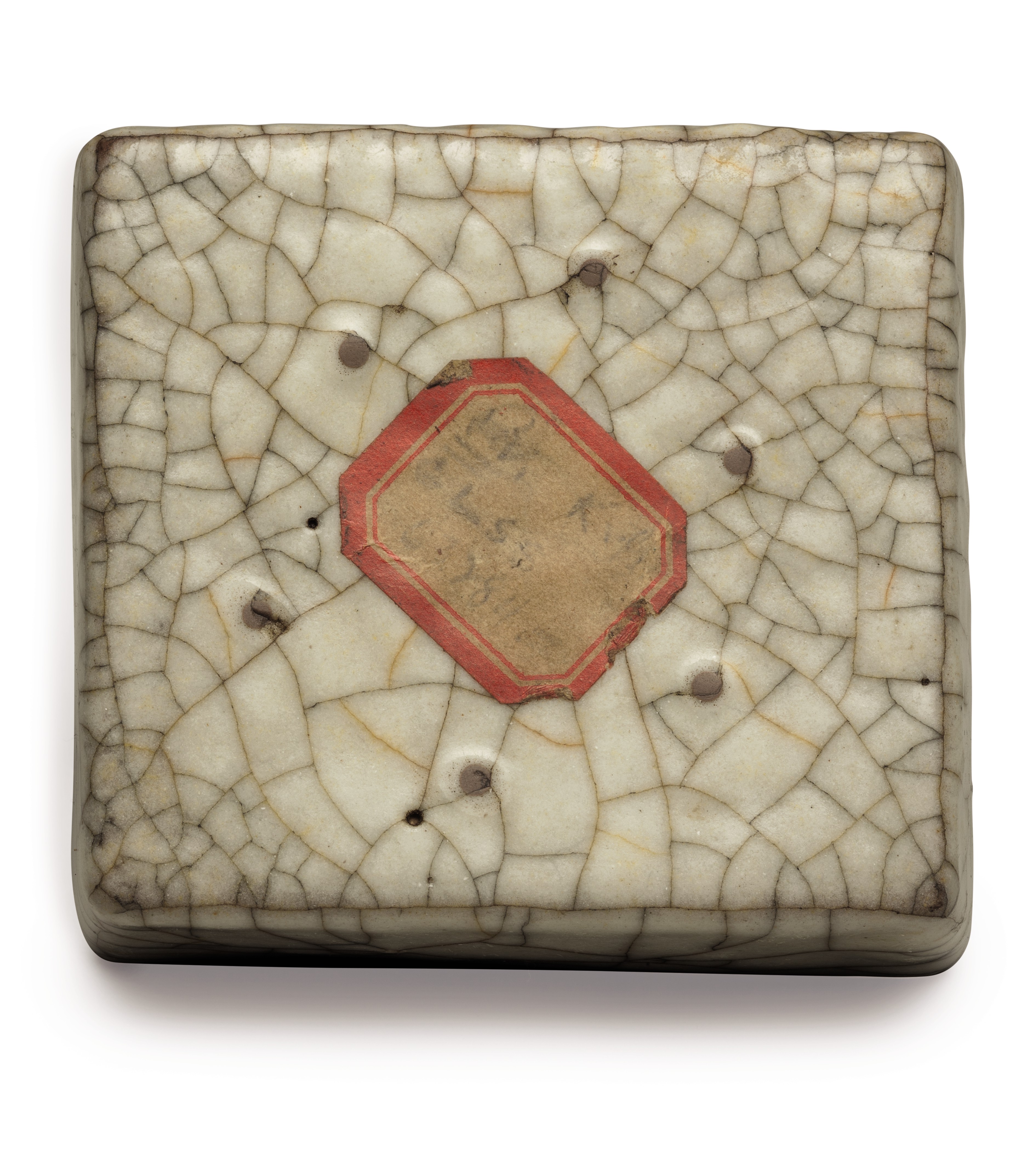
成交總額 USD 21,250
估價 USD 7,000 – USD 9,000
明 哥釉小方洗
3 ½ in. (8.8 cm.) wide
拍品專文
Ge ware, along with Guan, Ru, Ding and Jun, comprise the ‘Five Great Wares of the Song Dynasty’. The problems of distinguishing the two crackled wares, Guan, and Ge, were discussed at length during a conference held at the Shanghai Museum in 1992, and while no unanimity of opinion was reached, it was generally thought that those wares with a jinsi tiexian (‘gold thread and iron wire’) crackle should be designated Ge. See R. Scott, “Guan or Ge Ware?”, Oriental Art, Summer 1993, pp. 12-23. Recent archaeological researchers suggest that Ge wares may have been made at kilns in Chuzhou, nearer to the center of Longquan production, or just outside the walls of the Southern Song palace at Hangzhou. Scholars agree that Ge wares display the qualities that might be expected of vessels intended for imperial appreciation.
Yuan and Ming dynasty square-form Ge washers are very rare. A Ge cinquefoil brush washer dated to the Yuan-Ming dynasty was sold at Christie’s Hong Kong, 27 November 2013, lot 3279. Another washer, but of circular shape and dated to the Yuan dynasty, 14th century, is in the Qing Court Collection, and is published in the National Palace Museum, Precious as the Morning Star: 12th- 14th Century Celadons in the Qing Court Collection, p. 275, no. IV-34.
編製圖錄及詳情
拍品前備註
THE PROPERTY OF A PRIVATE COLLECTOR
参考:佳士得 拍賣 16694
重要中國瓷器及工藝精品
香港|2019年5月29日
拍品3164|THE PROPERTY FROM A HONG KONG COLLECTOR
清乾隆 仿官窯盌 四字篆書款
QIANLONG FOUR-CHARACTER SEAL MARK IN UNDERGLAZE BLUE AND OF THE PERIOD (1736-1795)
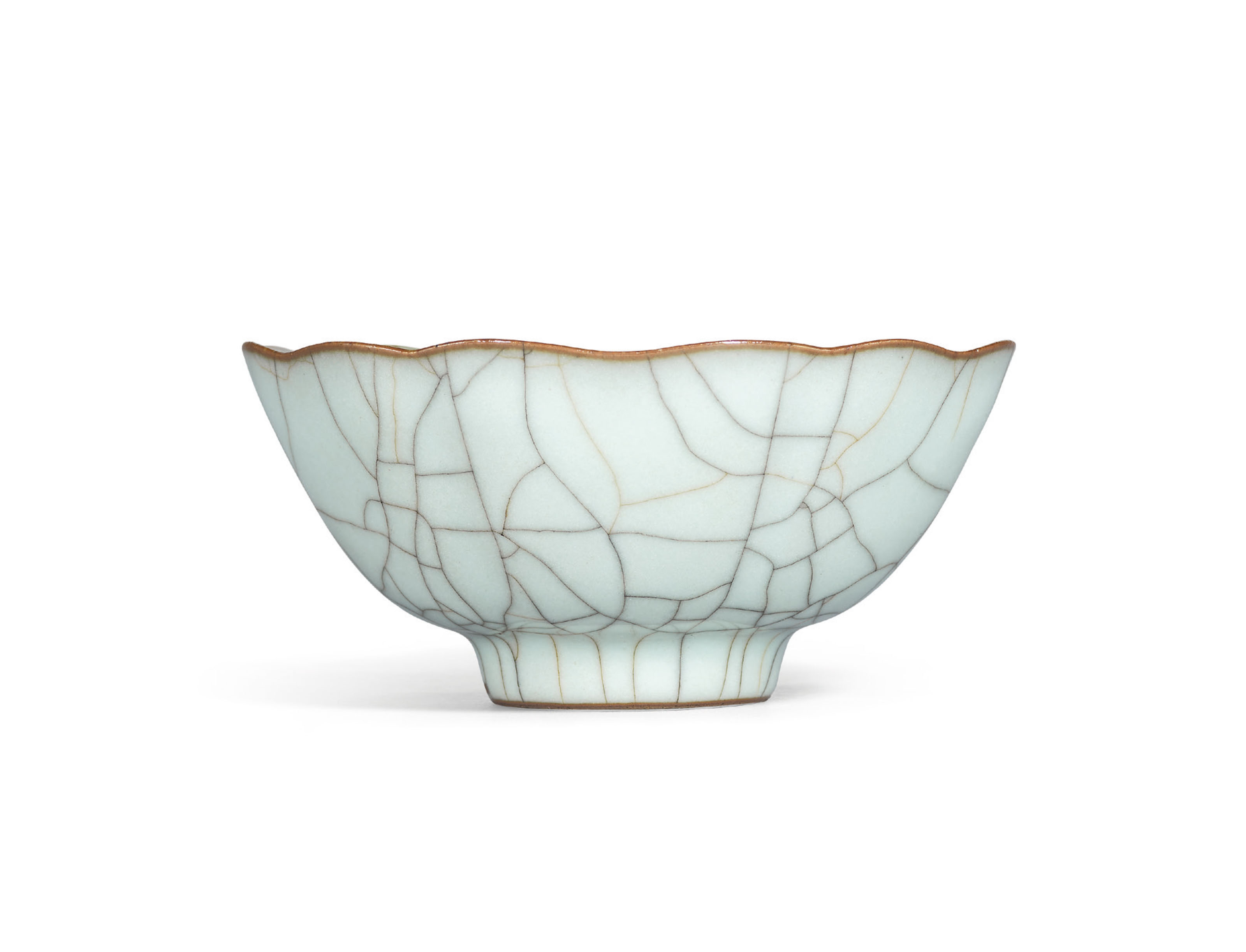
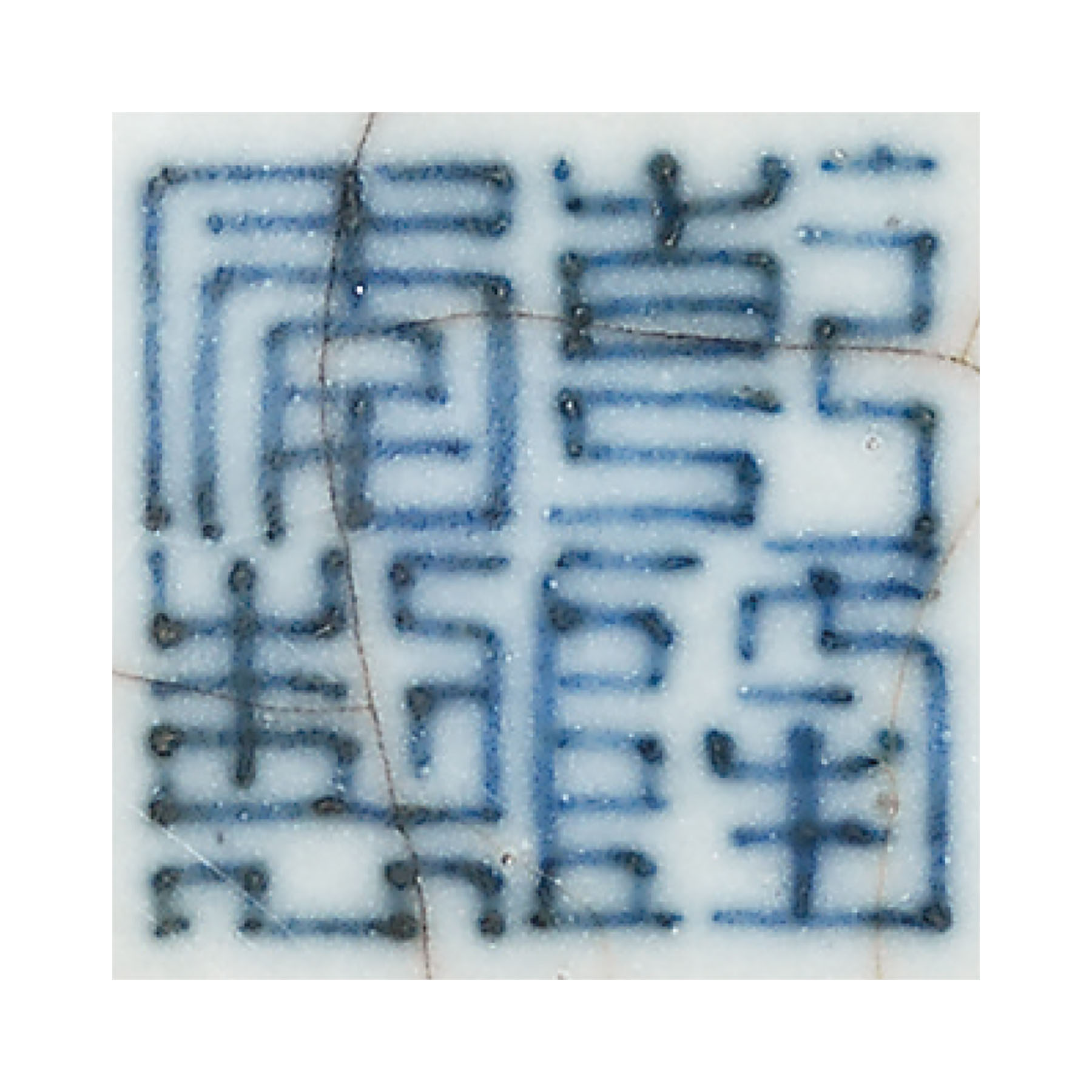
成交總額 HKD 400,000
估價 HKD 180,000 – HKD 250,000
清乾隆 仿官窯盌 四字篆書款
4 ¾ in. (12 cm.) diam., box
來源
香港蘇富比,2008年4月11日,拍品2983號
編製圖錄及詳情
拍品前備註
THE PROPERTY FROM A HONG KONG COLLECTOR
参考:佳士得 拍賣 17836
髹金飾玉 – 歐雲伉儷珍藏晚間拍賣
紐約|2019年3月20日
拍品826|THE FLORENCE AND HERBERT IRVING COLLECTION
清雍正 仿哥釉瓜棱膽式瓶 六字篆書款
CHINA, QING DYNASTY, YONGZHENG SIX-CHARACTER SEAL MARK IN UNDERGLAZE BLUE AND OF THE PERIOD (1723-1735)
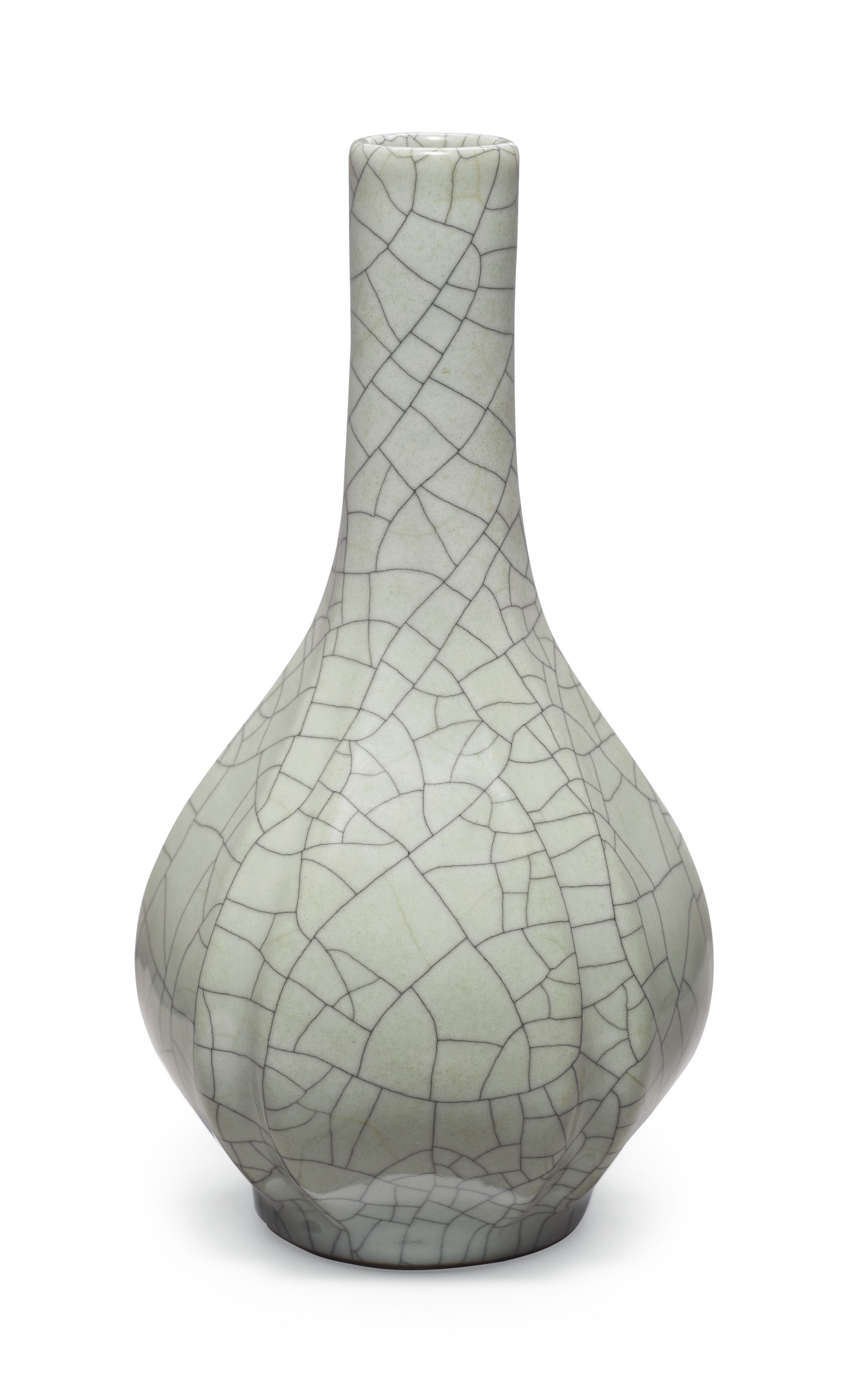
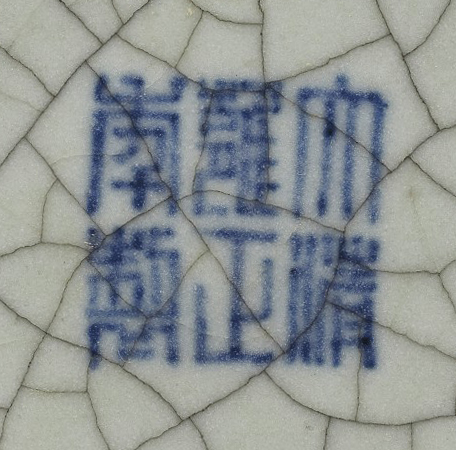
成交總額 USD 915,000
估價 USD 80,000 – USD 120,000
清雍正 仿哥釉瓜棱膽式瓶 六字篆書款
8 ¼ in. (21 cm.) high
來源
龐耐,紐約, 1982年。
歐雲伉儷珍藏,編號713。
拍品專文
雍正皇帝好古博雅,收藏有包括宋哥窯在内的衆多古董。在大英博物館和Victoria and Albert Museum所藏的兩卷雍正《古玩圖》中就能覓得數件哥窯器物,可見雍正皇帝對哥窯的喜愛,見《China-The Three Emperors 1662-1795》,倫敦皇家藝術學院,2005年,頁252-255。雍正皇帝不僅收藏宋代瓷器,更命御窯廠仿燒,督陶官唐英殫精竭慮成功恢復宋五大名窯釉色品種。唐英《陶成紀事碑》中記載有「仿鐵骨哥釉,有米色、粉青二种,俱仿内旧器色泽」,可見雍正哥釉的藍本是宮中所藏的宋代原件。
本件仿哥釉瓶釉質瑩潤,鐵綫密布,金絲隱現,底足露胎処加黑色護胎汁作「鐵骨」狀,是雍正哥釉器中的傑作。故宮博物院藏有一件與本器十分相似的雍正仿哥釉瓜棱膽式瓶,載於《哥瓷雅集-故宮博物院珍藏及出土哥窯瓷器薈萃》,北京,2017年,頁270-271,編號132。
編製圖錄及詳情
拍賣現場通告
Please note that the measurement for this lot should be 8 ¼ in. (21 cm) high.
拍品前備註
THE FLORENCE AND HERBERT IRVING COLLECTION
参考:玄览—重要古董器物专场
保利厦门2018春季拍卖会
Lot 0922 清乾隆 仿官釉三羊尊
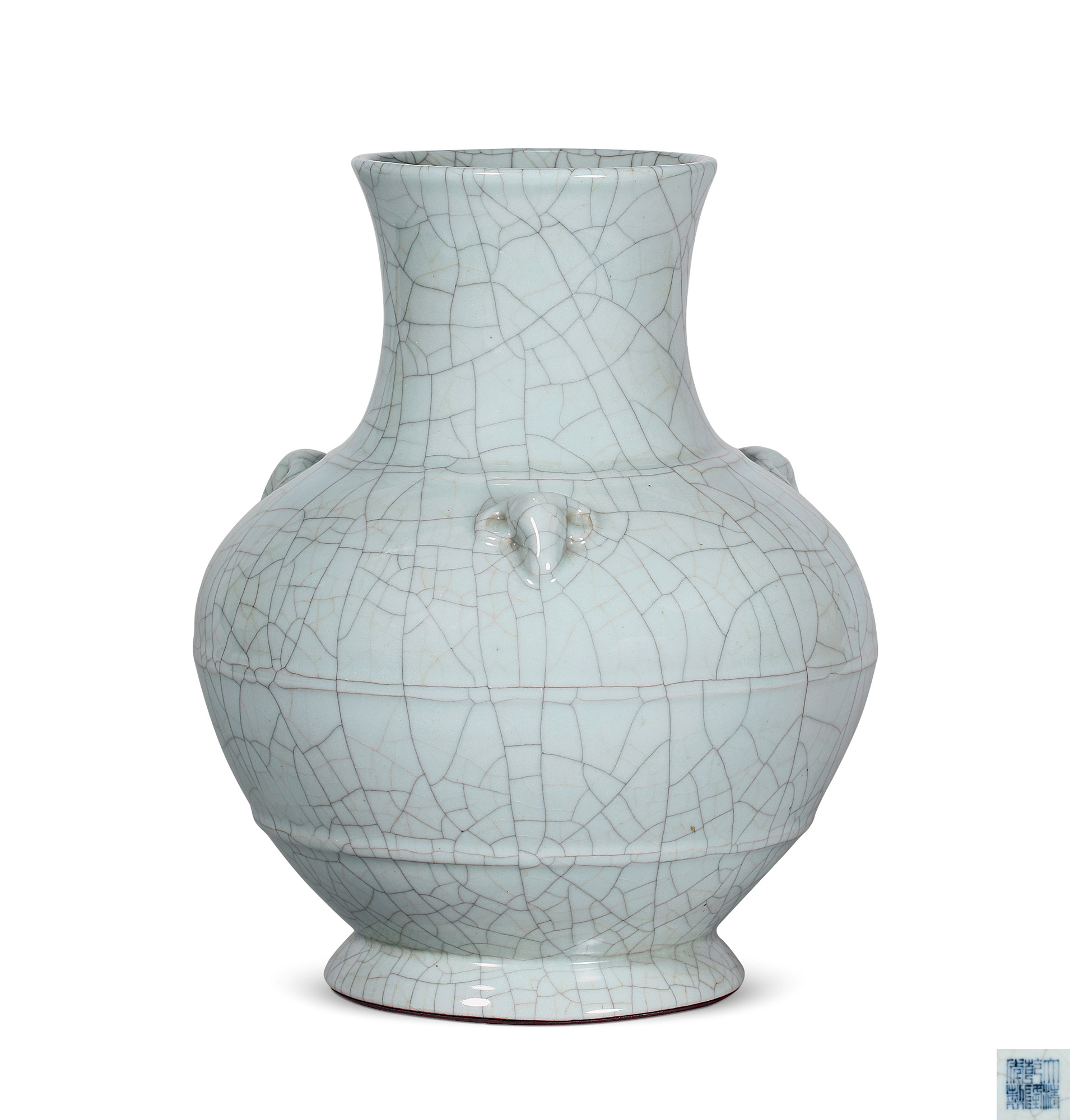
估价:1,200,000-1,800,000 RMB
拍品说明尺寸:高29.5cm
「大清乾隆年制」六字三行篆书款 拍品撇口,束颈,丰肩,鼓腹,圈足外撇。颈部和腹部三组凸起的双弦纹装饰,肩部饰三羊首,寓含三羊启泰之意。通体施仿官釉,上布大小开片,釉面莹润,细腻凝厚。底落「大清乾隆年制」六字三行篆书款,工整古雅。三羊尊摹自周汉铜壶,为雍正后期御窑厂的创新隽品,乾隆初年御窑单色釉瓷器承前朝遗绪,成就斐然,代表乾隆时期单色釉最佳品质,本品是为一例,无论器形、胎釉均与雍正者无异。其造型古朴典雅,釉色静穆温润,肩部饰三羊首,既具古韵,又添新意,寓含三羊启泰之义。颈腹之际各饰双道凸弦纹共三组,令造型富见线条之变化。三羊开泰,因古时「羊」、「阳」通假,亦称「三阳开泰」。《易经》中称∶「十月为坤卦,纯阴之象。十一月为复卦,一阳生于下。十二月为临卦,二阳在下。下月为泰卦,三阳大下。」其意为冬去春来,阴消阳长,万物复苏,因此三阳开泰有吉祥之象。此外,中国宗法社会亦有「君为阳」,「父为阳」的思想,故此纹饰在清代受到皇家大力推崇,而成为官窑瓷器的经典纹样。三羊尊以其古雅敦实的造型深得乾隆皇帝所爱,据乾隆三年六月二十五日《造办处活计清档》记载,乾隆皇帝曾下发「厂官釉三羊尊」让唐英「俱照样烧造送来」,此处所言「厂官釉三羊尊」应是雍正朝之御物,可知雍干二朝均烧造厂官釉的三羊尊。同时乾隆皇帝还将其它色釉装饰三羊尊,文献所知例如《陶雅》「干隆冬青窑变各瓶,有匀配三羊头于肩际者」的记述则表明在晚清时期至少见有冬青釉和窑变釉二种流传于世,目前所见实物除仿官釉之外尚有仿哥釉、窑变釉,见香港钟氏怀海堂之典藏。纵观雍干二朝御瓷之烧造实况,此一器多釉的烧造模式非常流行,往往表明君王对某类器形怀有独特的钟爱。本品隽雅古典,是为唐英榷陶之下的乾隆早期御窑之佳器,至为难得。北京故宫博物院藏一例仿汝釉三羊尊,著录 于《故宫博物院藏清代御窑瓷器》卷一下册,紫禁城出版社,2005年,页379,图175,可资比较。参阅:北京保利,2010年12月5日,编号4694;香港苏富比,2009年10月8日,编号1632;《宫廷珍藏:中国清代官窑瓷器》,上海文化出版社,2003年,330页;《故宫博物院藏清代御窑瓷器》卷一下册,紫禁城出版社,2005年,页378、379,图175;《西藏博物馆藏明清瓷器精品》,中国大百科全书出版社,2004年,页144、145来源东京美术俱乐部;丸ヱ大野商店旧藏
参考:厦门保利春拍
Lot 0951 清雍正 哥釉纸槌瓶
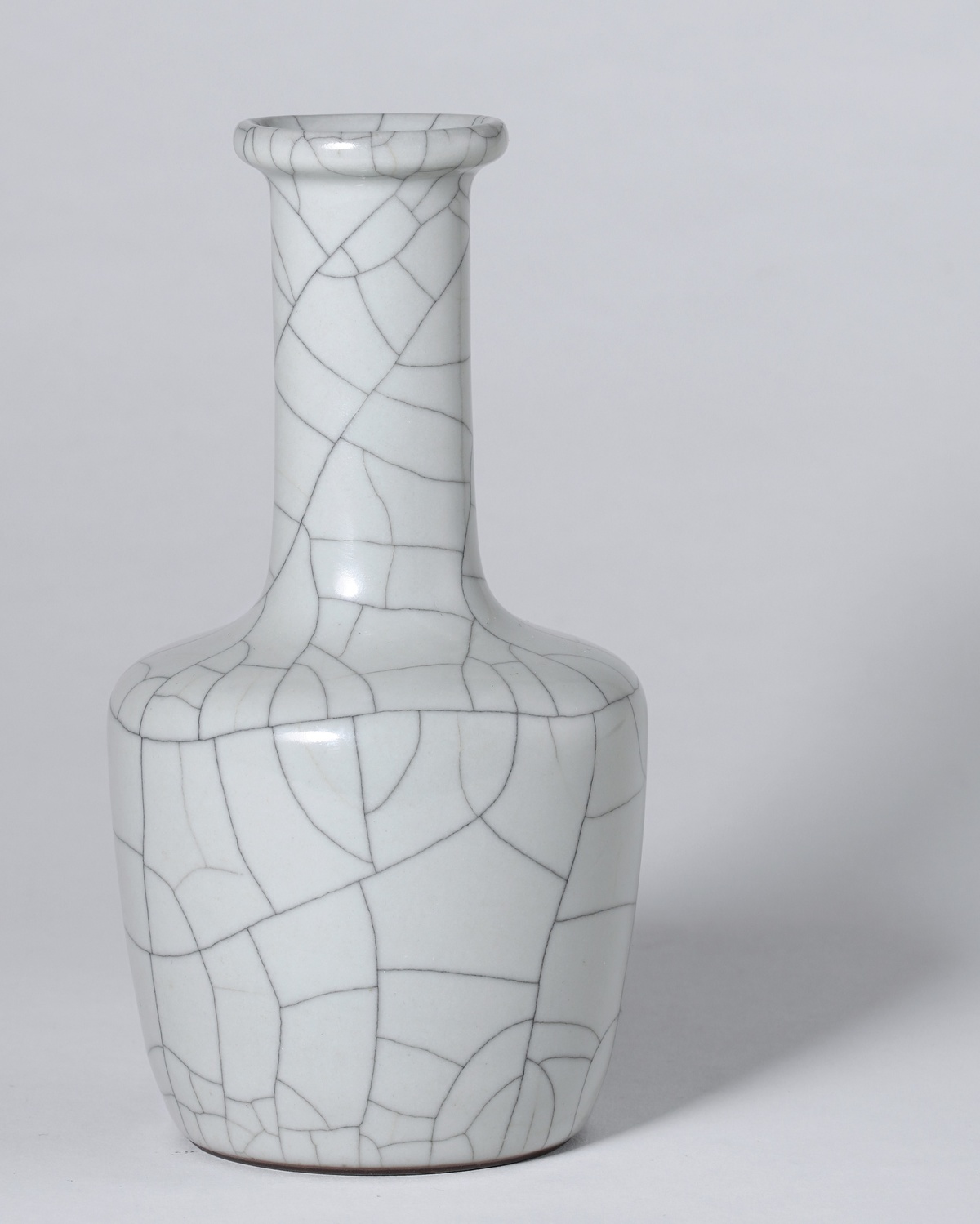
Lot 0951 清雍正 哥釉纸槌瓶
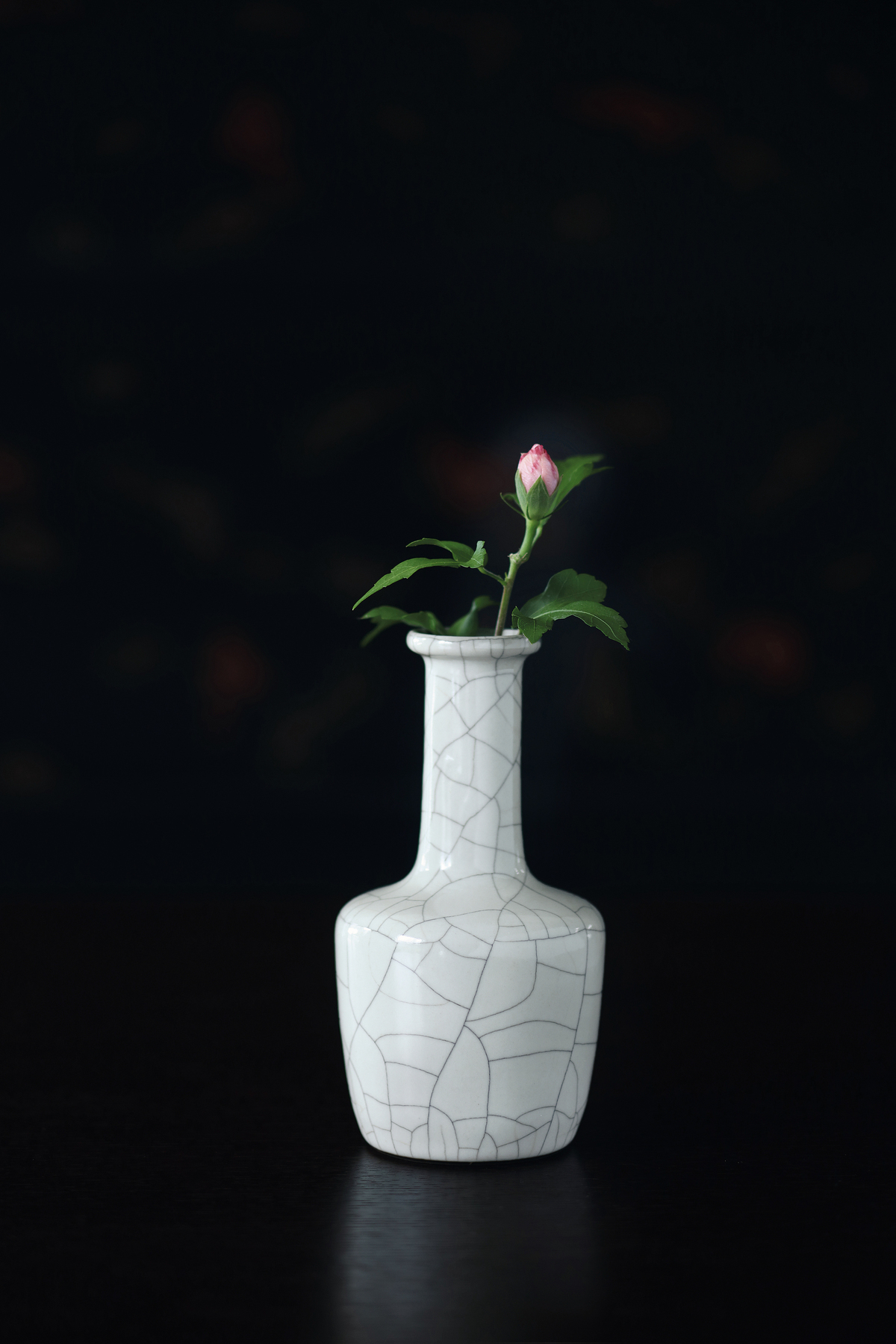
Lot 0951 清雍正 哥釉纸槌瓶
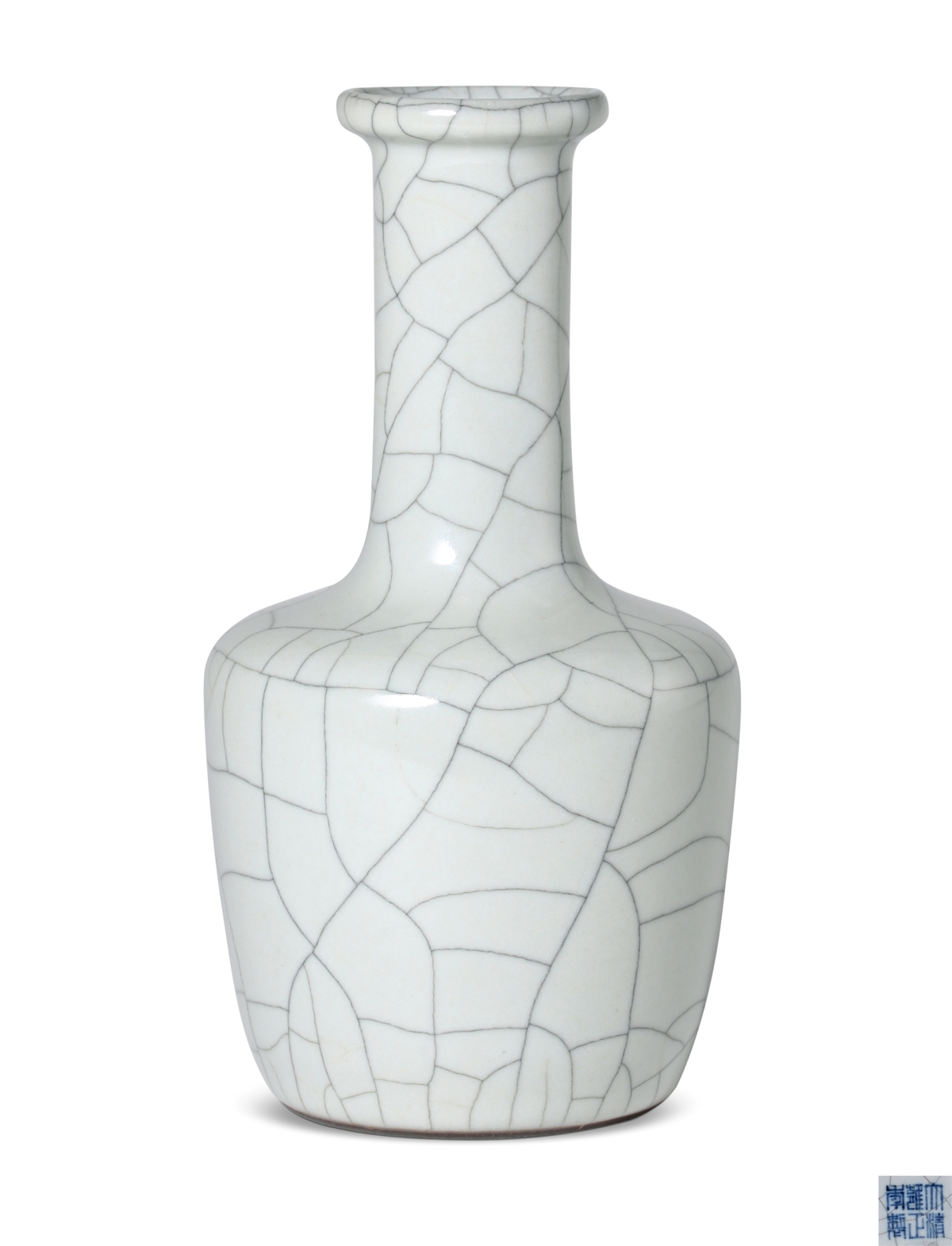
Lot 0951 清雍正 哥釉纸槌瓶
估价:4,800,000-6,800,000 RMB
成交:7,590,000 RMB
拍品说明
尺寸:高16.5cm
清代珍品 -「仿哥釉纸槌瓶」,高16.5cm,底书「大清雍正年制」六字三行篆书款,估价RMB 480万 – 680万。纸槌瓶由来已久,最早可追溯到西元九至十世纪。清帝好古之风尤盛,其中属雍正时期摹烧最得宋器遗韵,不事雕琢,素净逸然。
来源方面,为美国Ralph M.Chait Galleries旧藏,此艺廊已有过百年历史,专营中国古董艺术品。此后该瓶由「玫茵堂」递藏,著录于《玫茵堂中国陶瓷》卷四中,又曾在香港苏富比上拍,来源有序可靠。此瓶终以RMB 660万落槌,连佣RMB 759万成交。
出版《玫茵堂中国陶瓷》,康蕊君,伦敦,1994-2010年,卷四,编号1793 「大清雍正年制」六字三行篆书款 来源Ralph M.Chait Galleries旧藏;香港苏富比,2011年10月5日,Lot.1《玫茵堂中国陶瓷》,康蕊君,伦敦,1994-2010年,卷四,编号1793忆 古纸槌瓶瓶形由来已久,最早可追溯到西元九至十世纪。台北故宫博物院瓷器部部长蔡玫芬于1966年所著《论「定州百瓷器有芝不堪用」句的真确及十二世纪官方瓷器之诸问题》一文中提出推测:纸槌瓶的原型为当时伊朗及埃及的玻璃工艺,其流行于九到十二世纪间。关于此类瓶器的用途,Stefano Carboni猜测为伊朗泥沙布林特的装油或盛酒器,而也有学者认为其与宋代宫廷使用西亚贡入蔷薇水的传统密不可分。《铁围山丛谈》记载:「政和四年……并奉承俱入内藏库……大食国蔷薇水虽贮于玻璃缶中,蜡密封其外,然香犹透彻……洒着人衣袂,经十数日不歇也。」《宋史·大食传》记:「来献蔷薇水二十琉璃瓶」,玻璃纸槌瓶极有可能为诸记载中所言琉璃瓶之一。此外,北宋初年东南亚沉船出土了不少纸槌瓶残器,故猜测海运应为纸槌瓶传入东亚的管道之一。而从中国境内出土的器物可辨,玻璃纸槌瓶最晚于十一世纪初便已进入辽国境内。北宋后琉璃纸槌瓶逐渐被取型用于瓷器烧制,而以瓷器仿制玻璃器的记载可见于《新校本北史·列传》卷九十:「何稠字桂林,……善琢玉。稠年十余……博览古图,多识旧物……时中国久绝琉璃作,匠人无敢错意,稠以绿瓷为之,与真不异。」自此,纸槌瓶成为一种仿西亚玻璃器而来的中国器物类型。迄今为止发现最早的陶瓷纸槌瓶为北宋汝窑所出,台北国立故宫博物院即藏两件个中精品——北宋汝窑青釉纸槌瓶和北宋汝窑青釉奉华纸槌瓶。其形制类似,皆圆口微侈,细长颈,斜宽肩,上丰下敛腹,卧足。薄胎上满施淡灰蓝色釉,釉薄处可见香灰色胎,底部更刻有乾隆御制诗,以证此器流传至清益得珍爱。时至元明,对纸槌瓶的摹制与烧造依旧,而其也由最初的盛装器逐渐演化为花事用具,文人气息渐浓。此举亦可见于诸文献,明代高濂于《瓶花三说》中记载:「(书斋插花)瓶宜短小,以官哥胆瓶、纸槌瓶、鹅颈瓶……具可插花。」明代学者张谦德也在《瓶花谱》中提到纸槌瓶可用于书房中插花,为书室妙品。清帝好古之风尤盛,其中属雍正时期摹烧最得宋器遗韵,不事雕琢,素净逸然,一如拍品所呈,文雅安宁。胤禛对瓷器造型、图案、色彩各方面要求都很高,所有御制瓷器须经御制图样和御批审定方可烧造,最直接的就是要求器出有样,所谓「内廷恭造式样」,拿古器实物作参照样本,这在《养心殿造办处各作成做活计清档》中有多处记载。而唐英成书于雍正十三年的《陶成纪事碑》中所列的五十七种岁例贡御釉水,大凡仿古种类,都特加注明「仿内发宋器色泽」、「仿内发旧器」等。如仿哥釉一条,「一仿铁骨哥釉,有米色、粉青二种,俱仿内发旧器色泽」。至乾隆时期,纸槌瓶之仿烧与装饰则更具本朝特色,如以画珐琅工艺装饰,又如仿明代形制并放大尺寸等,相关烧造记录可在清档中窥得一二:「乾隆三年六月二十五日:七品首领萨木哈,催总白世秀来说太监高玉交:……哥釉收小八方双管瓶一件,哥釉四喜瓶一件,哥釉太极纸槌瓶一件……传旨:交与烧造磁器处唐英,……俱照样烧造送来。烧造完时再将交出原磁器缴回,仍交磁器库。此磁器内有大器皿应画样带去,其小磁器皿俱各带。钦此」又如「乾隆四十年十一月二十八日,太监胡世杰交玻璃胎画珐琅西番(花)渣斗一件……玻璃胎画珐琅喜相逢诗意纸槌瓶一件……传旨:俱配楠木匣盛装,盖上刻字。钦此。」以及(乾隆三年)「六月二十五日七品首领萨木哈,催总白世秀来说太监高玉交宣窑青花有耳盖碗一件……宣窑青花放大纸槌瓶一件……」代代相传,冉冉化裁,纸槌瓶跨越宋、元、明、清,如文人衣袂飘香,款款而来。视 今拍品形制、釉色均仿自宋瓷,形制与台北故宫博物院所藏两件极为相似,盘口,直颈,折肩,直腹下微敛,式样雅致,颇具古风。通体施仿哥釉,其上「金丝铁线」古意盎然,韵致非凡。唐英《陶成纪事碑记》中所载「一仿铁骨哥釉,有米色、粉青两种。俱仿内发旧器色泽」,其中「铁骨哥釉」即为此例。不施复杂曲折的设计,简约质朴中透着「静为依归」的寂寥。底落「大清雍正年制」六字三行篆书款,更添意蕴。此瓶为The Ralph M. Chait Galleries旧藏,美国纽约一家由家族经营的艺廊,专营中国古董艺术品,由Ralph M. Chait于1909年创建,目前该店为其子Allan Chait掌管,其客户面极广,包括艺术家、政治人物、学者、不乏收藏界知名人士,诸如爱德华·索南斯肯、耶鲁·尼兰,之后又增加到总统赫伯特·胡佛在内的政商名流。此后该瓶由玫茵堂递藏,著录 于《玫茵堂中国陶瓷》卷四中。玫茵堂始于20世纪50年代中期,被誉为「当今最重要的古董收藏之一」,其收藏是瑞士Stephen Zuellig与其弟Gilbert两人60年的珍藏,玫茵堂之名是该兄弟瑞士家乡Meienberg的谐音,其意为「玫瑰花丛中的殿堂」,其收藏注重作品的珍稀程度、纹饰的品质以及作品的品相,所藏古董器物上至新石器时代,下迄清代,珍品繁多。纵观拍场,2008年香港苏富比曾以6752万港币拍出一件南宋官窑粉青釉纸槌瓶,与本品形制亦相类,其延续北宋纸槌瓶之形,为当时官窑之中独树一帜的存在。底刻「玉津园」以示该器为宋高宗于临安宫之收藏,且为南宋官窑最早期的制器之一。与拍品相比仅尺寸略大,釉色相异,可资比较。此外,2010年香港苏富比「彩华腾瑞——戴润斋清宫御瓷藏珍」专场所拍乾隆御制珐琅彩「祥云瑞蝠」开光式「四季花卉」图纸槌瓶估价6千万港币,终以天价1.4亿港币落槌,实为拍场上清代纸槌瓶之佼佼者。该器一改纸槌瓶传统的直腹,代之以饱满的鼓腹,外壁以珐琅彩纹饰满布,足见当朝审美特征与创新意识。历朝争相传颂,拍场高价屡现,纸槌瓶以其简约而具意味之美为世人视作瑰宝,以美为名,传承延续。
参考:佳士得拍賣 3433
中國宮廷御製藝術精品
重要中國瓷器及工藝精品
Hong Kong, HKCEC Grand Hall|2015年6月3日
拍品3244
清乾隆 仿哥釉六方瓶 六字篆書款
QIANLONG SIX-CHARACTER SEAL MARK AND OF THE PERIOD (1736-1795)
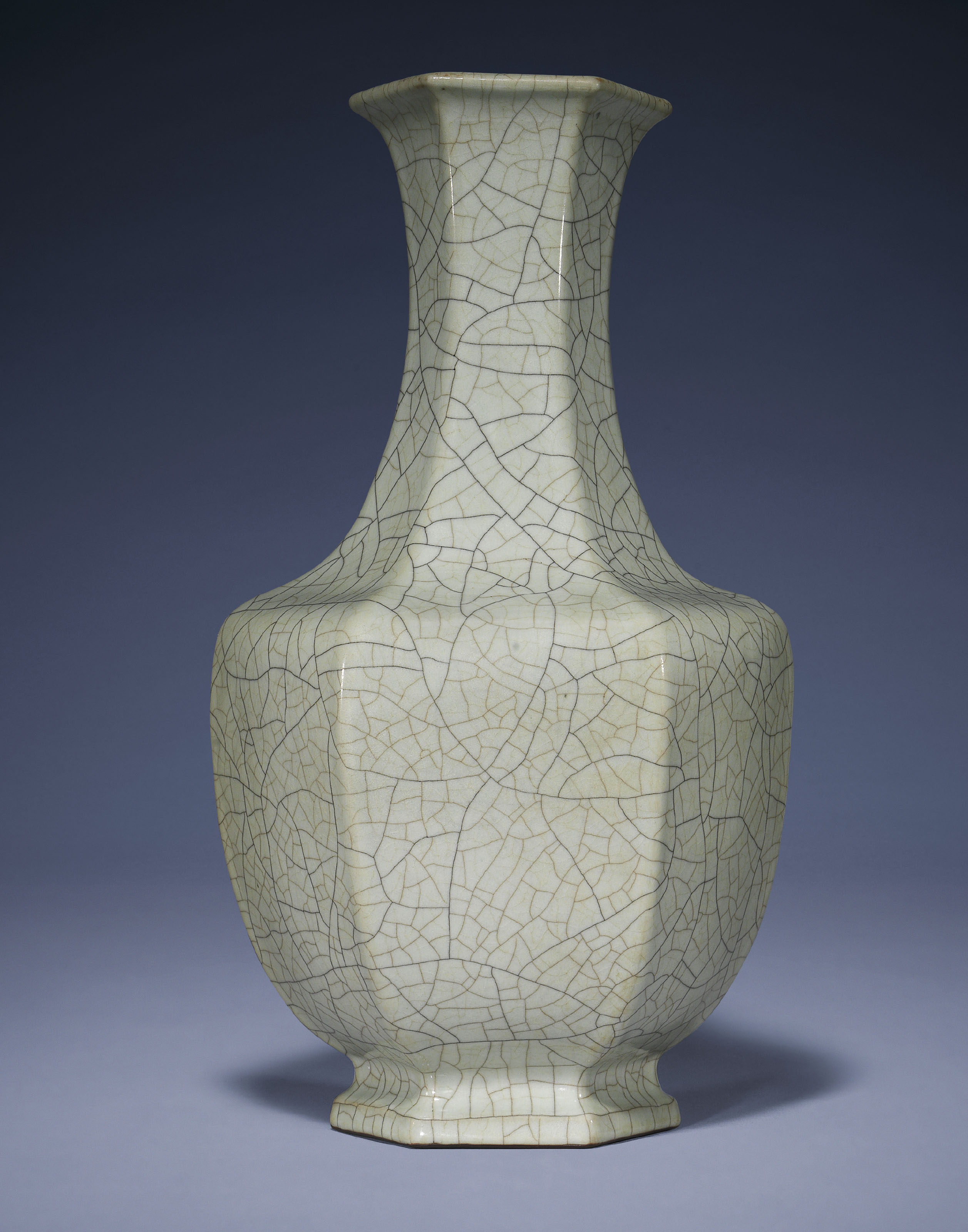
清乾隆 仿哥釉六方瓶 六字篆書款
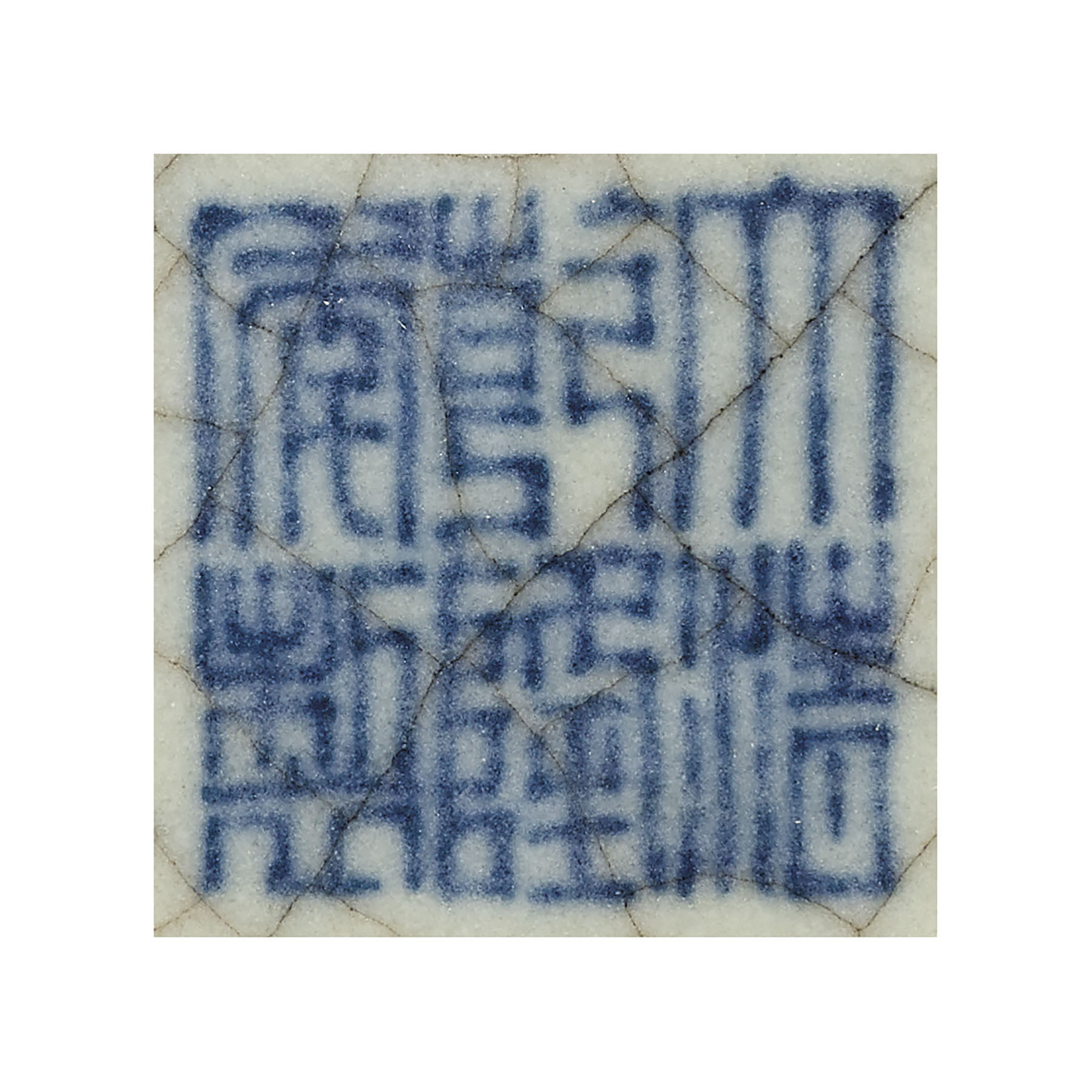
清乾隆 仿哥釉六方瓶 六字篆書款
成交總額 HKD 1,000,000
估價 HKD 800,000 – HKD 1,500,000
清乾隆 仿哥釉六方瓶 六字篆書款
参考:佳士得拍賣 3406
古今 ∣ 佳士得:中國瓷器及工藝精品
22nd Floor|2015年4月6日
拍品208|ANOTHER PROPERTY
清雍正 仿哥釉菊瓣瓶 六字篆書款
YONGZHENG SIX-CHARACTER SEAL MARK IN UNDERGLAZE BLUE AND OF THE PERIOD (1723-1735)
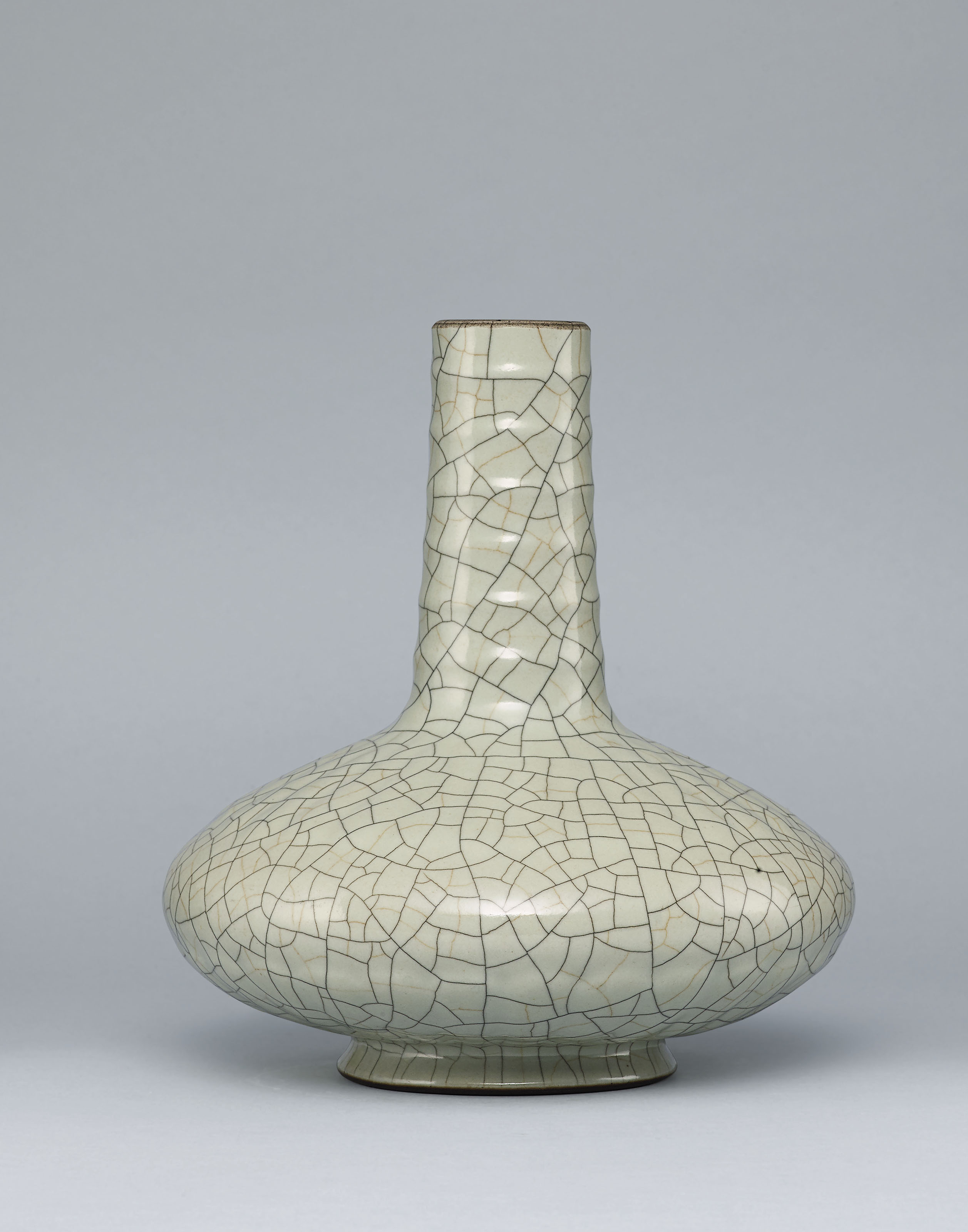
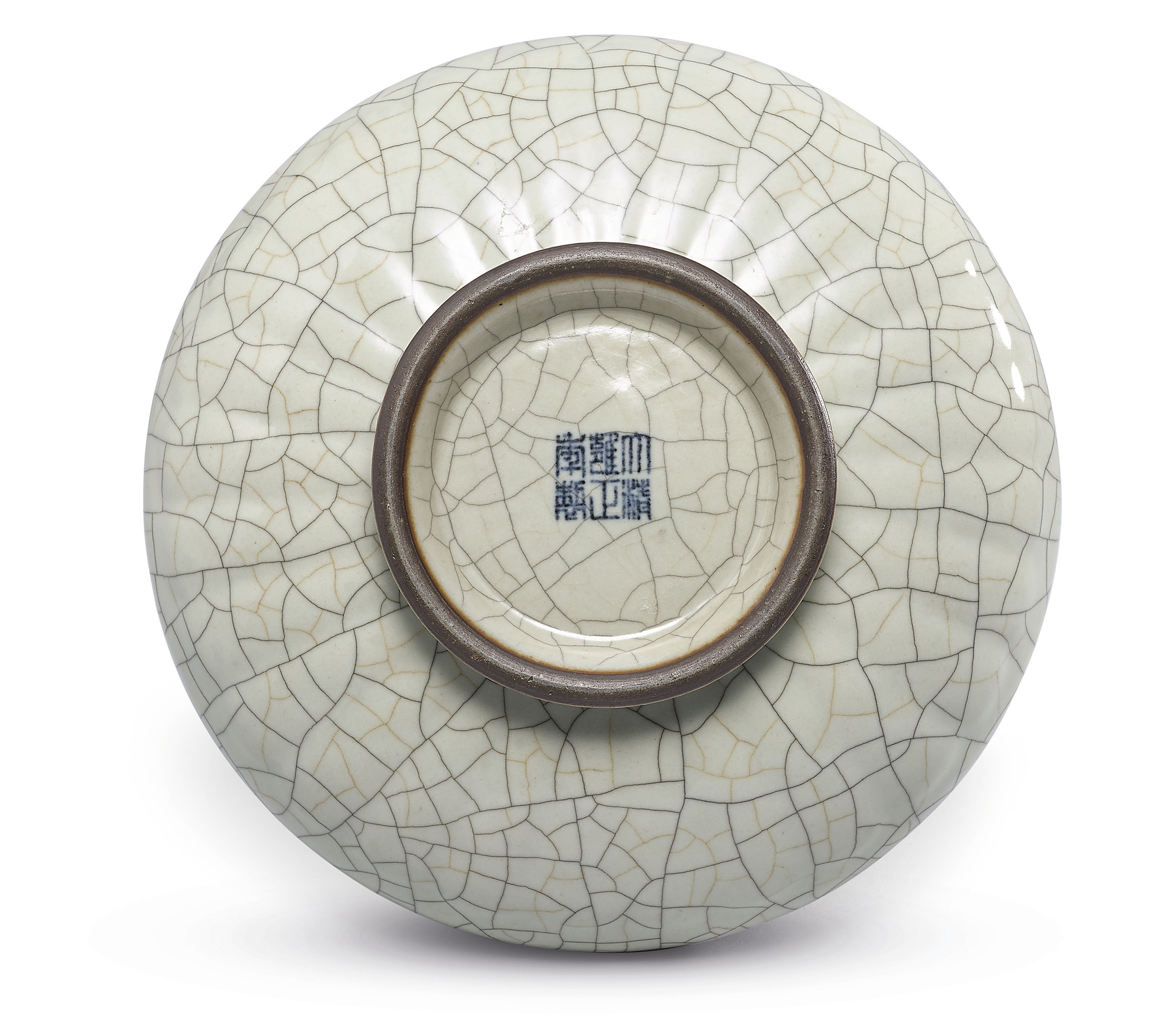
成交總額 HKD 1,120,000
估價 HKD 1,000,000 – HKD 1,500,000
清雍正 仿哥釉菊瓣瓶 六字篆書款
來源
紐約佳士得,2008 年3 月19 日,拍品645 號
参考:佳士得拍賣 3720
重要中國瓷器及工藝精品
紐約|2015年3月15日 – 16日
拍品3243|PROPERTY FROM A DISTINGUISHED PRIVATE COLLECTION
南宋/元 哥窯水丞
SOUTHERN SONG-YUAN DYNASTY (1127-1368)
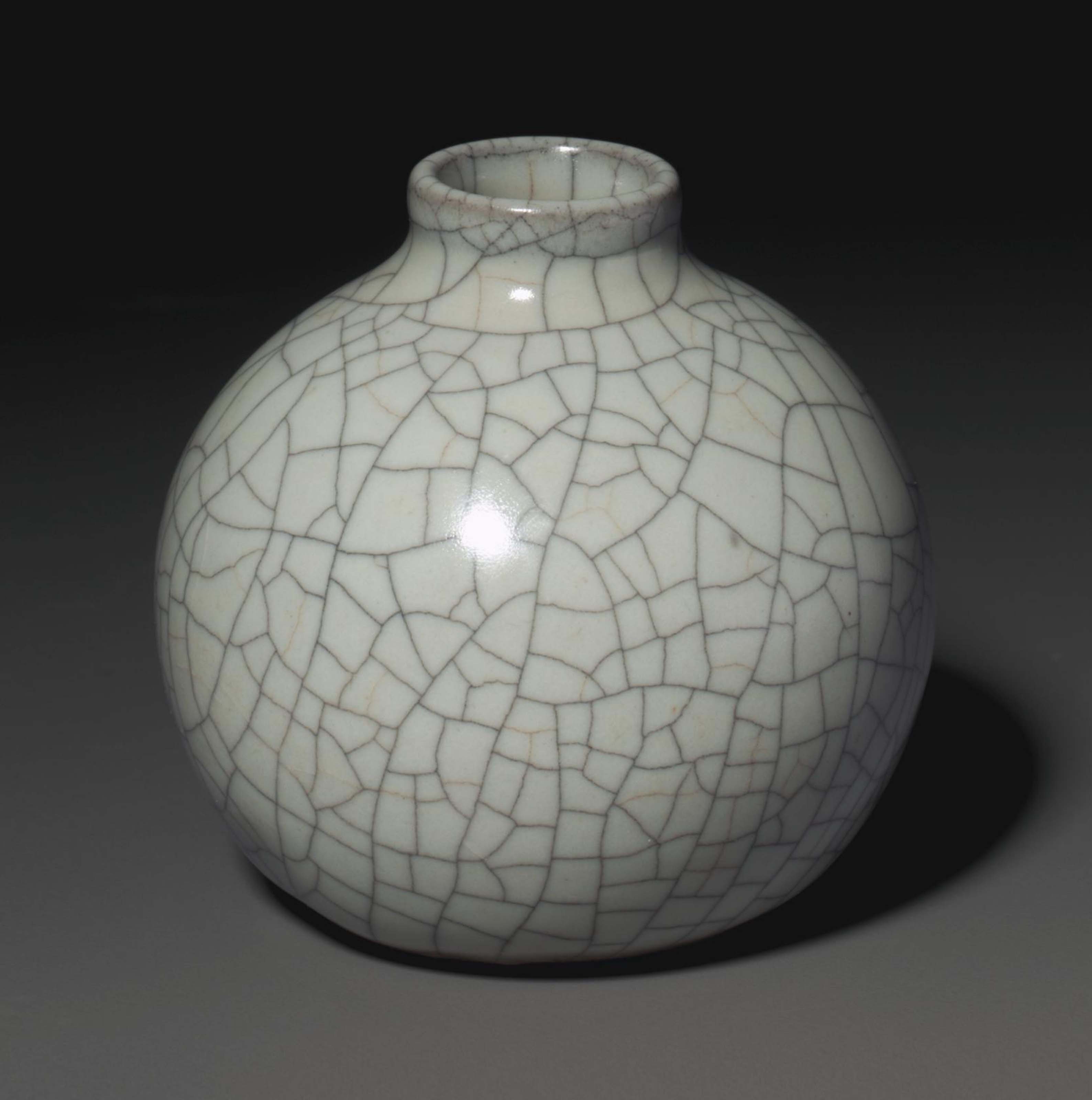
成交總額 USD 1,085,000
估價 USD 1,000,000 – USD 1,500,000
南宋/元 哥窯水丞
來源
Christie’s Hong Kong, 1 November 2004, lot 802.
文獻及展覽
文獻
Christie’s 20 Years in Hong Kong, 1986 – 2006, Chinese Ceramics and Works of Art Highlights, p. 31.
拍品專文
This water pot has an exceptionally well-potted spherical form. Small compressed globular water pots with celadon glazes were made in Zhejiang province as early as the Southern Dynasties period (AD 420-589). One such vessel, excavated from a 5th century tomb in Yongjia county and now in the Wenzhou Museum, is illustrated in Complete Collection of Ceramic Art Unearthed in China, vol. 9, Zhejiang, Beijing, 2008, p. 87. Similar compressed globular water pots, with or without three small feet, were also made at the Ou kilns and the Yue ware kilns in the Tang dynasty. Examples from the Wenzhou Museum and the Cixi Museum are illustrated ibid, pp. 126 and 127 respectively. However, in the Five Dynasties period well-potted spherical water pots can be found amongst vessels from prestigious kilns which found favour with the imperial court. A mise celadon water pot of this spherical form, and of very similar size to the current Ge ware vessel, was excavated in Lin’an county in 1996 from the Kangling Mausoleum (dated AD 939), illustrated ibid., p. 143. A fine 10th-century spherical white-glazed water pot with incised lotus decoration, slightly smaller than the current Ge ware vessel, is in the collection of the Tokyo National Museum. This white water pot, which is illustrated in Sekai toji zenshu, vol. 11, Sui Tang, Tokyo, 1976, pp. 115-6, pls. 92-3, is inscribed on the base with the characters xin guan (new official). Although the Tokyo water pot has no neck or raised mouth rim, a small Ding ware spherical water pot (7.5 cm high) with a very short neck was excavated in 1969 from the foundations of the Jingzhongyuan Temple pagoda, dated AD 995, illustrated by the Idemitsu Museum of Arts in Treasures from the Underground Palaces – Excavated Treasures from Northern Song Pagodas, Dingzhou, Hebei Province, China, Tokyo, 1997, no. 90. A larger spherical Ding ware water pot with longer neck and thickened rim, also from Jingzhongyuan Temple pagoda, is illustrated by Liu Tao in Song Liao Jin jinian ciqi, Beijing, 2004, p. 5, fig. 1-29. Thus, by the early Northern Song dynasty, late 10th century, the spherical form for small water pots was already established as desirable amongst the Chinese elite.
A Guan-type water pot of similar size to the current vessel, with a spherical body, but standing on three short, splayed legs, is illustrated in Mayuyama Seventy Years, vol. 1, Tokyo, 1976, p. 161, no. 467. A Guan or Ge ware spherical water pot, also of similar size to the current vessel, was sold by Christie’s Hong Kong on 13 January 1987, lot 570. A water pot with Guan-type glaze, of slightly smaller size compared to the current vessel, and of compressed globular form, is illustrated in Chinese Ceramics, Song and Yuan Dynasty, Taipei, 1988, p. 515. A slightly larger 13th century spherical celadon-glazed water pot from the Longquan kilns, with floral surface decoration, is in the collection of Sir Percival David (illustrated in Illustrated Catalogue of Celadon Wares in the Percival David Foundation of Chinese Art, revised edition, 1997, pp. 29-30, no. 232), and was exhibited in Arts de la Chine Ancienne at the Musée de l’Orangerie, Paris, in 1937, exhibit no. 447. Nevertheless, few examples of similar vessels from any of the classic kilns of the 10th-13th century have survived into the present day.
Since the Ming dynasty, Ge wares have been regarded as one of the ‘Five Great Wares of the Song Dynasty’, along with Ru ware, Ding ware, Jun ware, and Guan ware. These wares remain the most revered wares of the Song dynasty (AD 960-1279), a period which Chinese connoisseurs have traditionally admired above all others for the refined beauty of its ceramics – typified by vessels with elegant forms, enhanced with subtly colored monochrome glazes. A variety of such wares were appreciated by members of the Song elite and the imperial court, as well as by later collectors, but texts tell us that these five types were held in particular esteem. Ge ware and Guan ware have been the subjects of extensive research by Chinese scholars and those from other countries in recent years, and they continue to be at the forefront of interest amongst scholars and collectors alike. Both Guan ware and Ge ware are characterized by subtly-colored glazes which were deliberately crackled to achieve a fine network of lines over the surface of the vessel. One of the reasons that these crackle lines were admired was that they were reminiscent of the fissures in jade, the most prized of all natural materials.
The high regard in which such pieces were held by the great Qing dynasty imperial collector, the Qianlong Emperor (1736-1795), for example, is demonstrated by the fact that Ge ware dishes appear in several informal portraits of the emperor. One such portrait is the famous painting entitled ‘One or Two?’, of which there are three versions in the Palace Museum, Beijing. One of these is illustrated in the catalogue of the exhibition, The Qianlong Emperor – Treasures from the Forbidden City, at the National Museums of Scotland, Edinburgh, 2002, p. 112, no. 59. The Qianlong emperor is shown seated on a day-bed in front of a screen on which is hung a portrait of himself, and surrounded by precious objects from his famous collection of antiques. One of these is a small crackled dish, which appears to be Ge ware. The admiration of the Qianlong Emperor for Ge wares can also be seen in the inscriptions that he applied to pieces in his collection. A recent exhibition at the National Palace Museum, Taipei, included eight Ge wares bearing Qianlong inscriptions (illustrated in Obtaining Refined Enjoyment: The Qianlong Emperor’s Taste in Ceramics, Taipei, 2012, nos. 35-7, 40-1, 43, 45, and 93). The same exhibition displayed a page from Qianlong’s hand-painted album Precious Ceramics of Assembled Beauty, which showed a Ge ware dish along with a discussion of the piece and various imperial seals (illustrated ibid., p. 203).
The Palace Museum, Beijing, has in its collection a censer, identified as Ge ware, which bears a Qianlong inscription (illustrated in The Complete Collection of Treasures of the Palace Museum – 33 – Porcelain of the Song Dynasty (II), Hong Kong, 1996, no. 51). The popularity of Ge and Ge-type wares at the courts of the Qing emperors is emphasised by the number of such pieces from the Qing Court Collection which are preserved in the Palace Museum, Beijing. Some 40 examples are published in Porcelain of the Song Dynasty (II), op. cit.
Examination of the Qianlong inscriptions highlights the subject on which there has been considerable debate among scholars and connoisseurs – the difficulty of determining whether a particular piece should be described as Guan ware or Ge ware. Certainly to judge from the Qianlong emperor’s inscriptions, he was inconsistent in his attributions. Traditionally it is said that Ge ware acquired its name from the Chinese term gege, meaning elder brother, since it was believed to have been made by the elder of the two Zhang brothers. Distinguishing between Ge and Guan ware is not greatly aided by the historical texts, which merely say that they looked similar to one another. A symposium held by the Shanghai Museum in October 1992 brought together all the leading Song ceramic scholars from China and abroad to discuss Ge ware and the ways to distinguish it from Guan ware. However, the debate regarding exact period of production and kiln site still rages. In light of the excavations carried out at the Xiuneisi kiln at Laohudong, some Chinese archaeologists now suggest that, like Guan ware, these beautiful and refined Ge wares may have been made at kilns just outside the walls of the Southern Song palace at Hangzhou, while others suggest that they may have been made at kilns nearer to the centre of Longquan production. Undoubtedly Ge wares, like the current water pot, display all the qualities that might be expected of vessels intended for imperial appreciation.
Rosemary Scott
International Academic Director, Asian Art
編製圖錄及詳情
拍品前備註
PROPERTY FROM A DISTINGUISHED PRIVATE COLLECTION
参考:佳士得拍賣 2872中國瓷器及工藝精品
紐約|2014年9月18日 – 19日
拍品746
南宋-元 十二至十三世紀 龍泉仿官釉小瓶
SOUTHERN SONG-YUAN DYNASTY, 12TH-13TH CENTURY
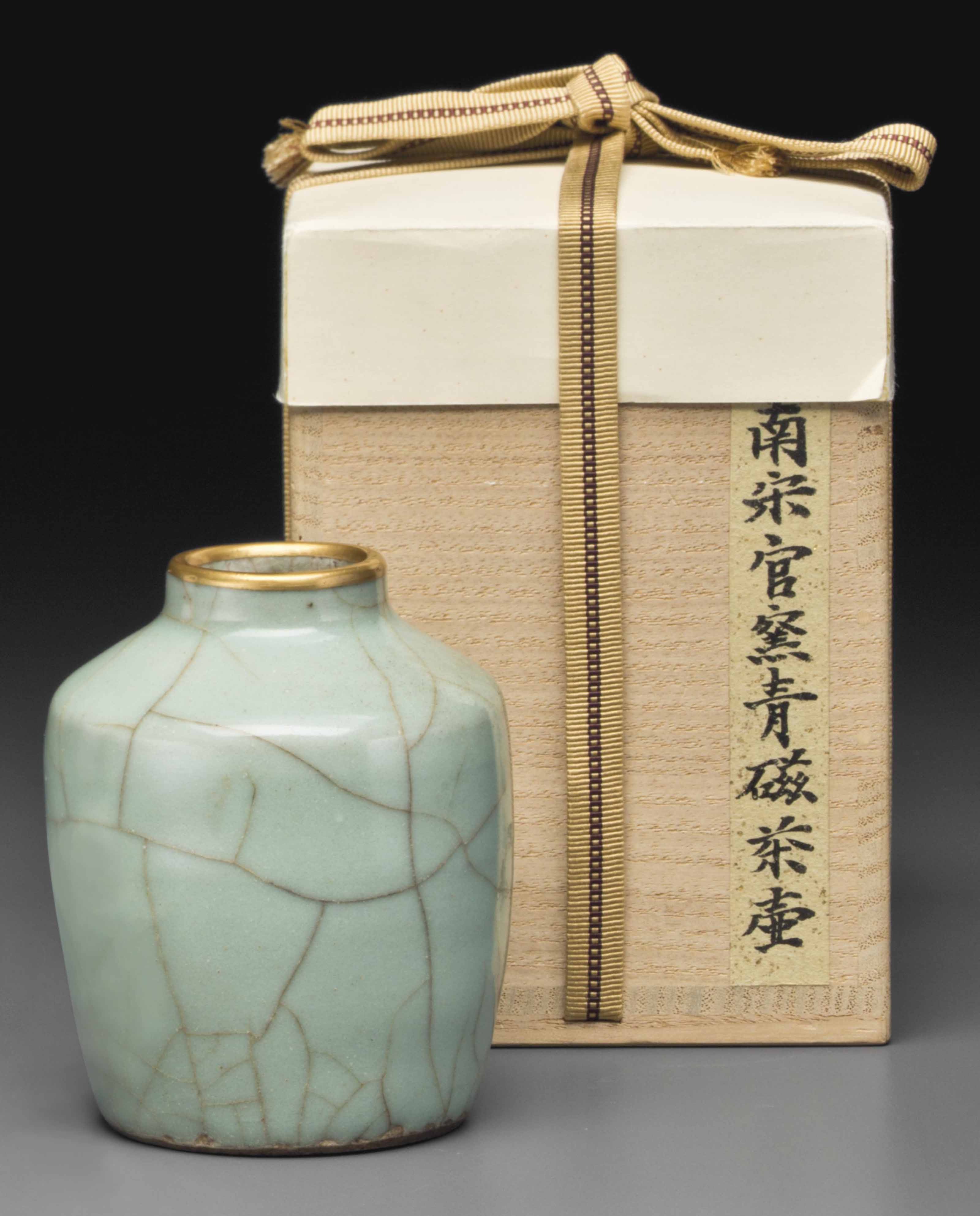
南宋-元 十二至十三世紀 龍泉仿官釉小瓶
成交總額 USD 18,750
估價 USD 3,000 – USD 5,000
南宋-元
十二至十三世紀
龍泉仿官釉小瓶
來源
A Japanese private collection, acquired in the 1990s.
参考:佳士得拍賣 2872
中國瓷器及工藝精品
紐約|2014年9月18日 – 19日
拍品770|PROPERTY FROM THE COLLECTION OF JAMES E. BREECE III
清乾隆 仿哥釉花口盌 四字篆書款
QIANLONG FOUR-CHARACTER SEAL MARK IN UNDERGLAZE BLUE AND OF THE PERIOD (1736-1795)
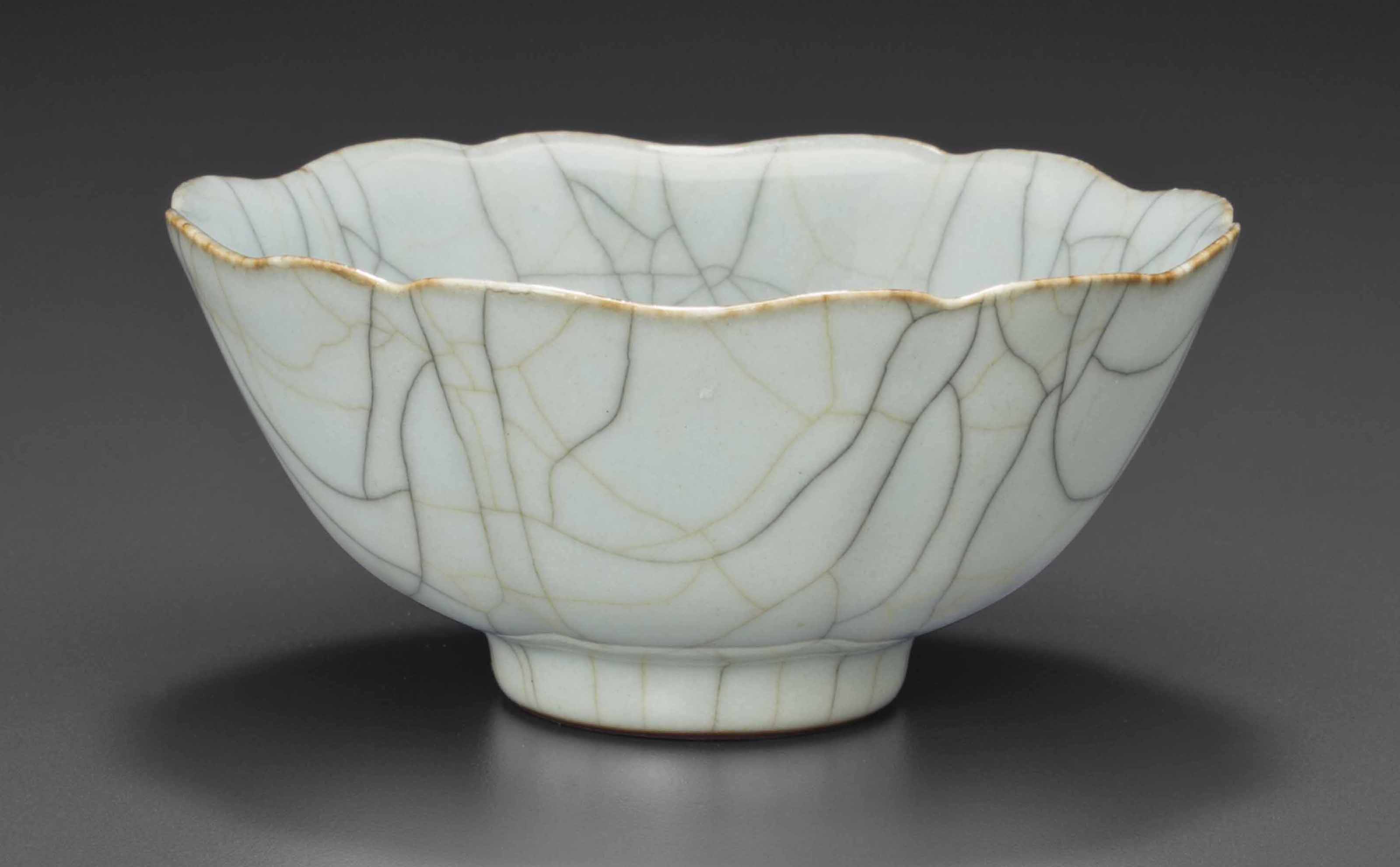
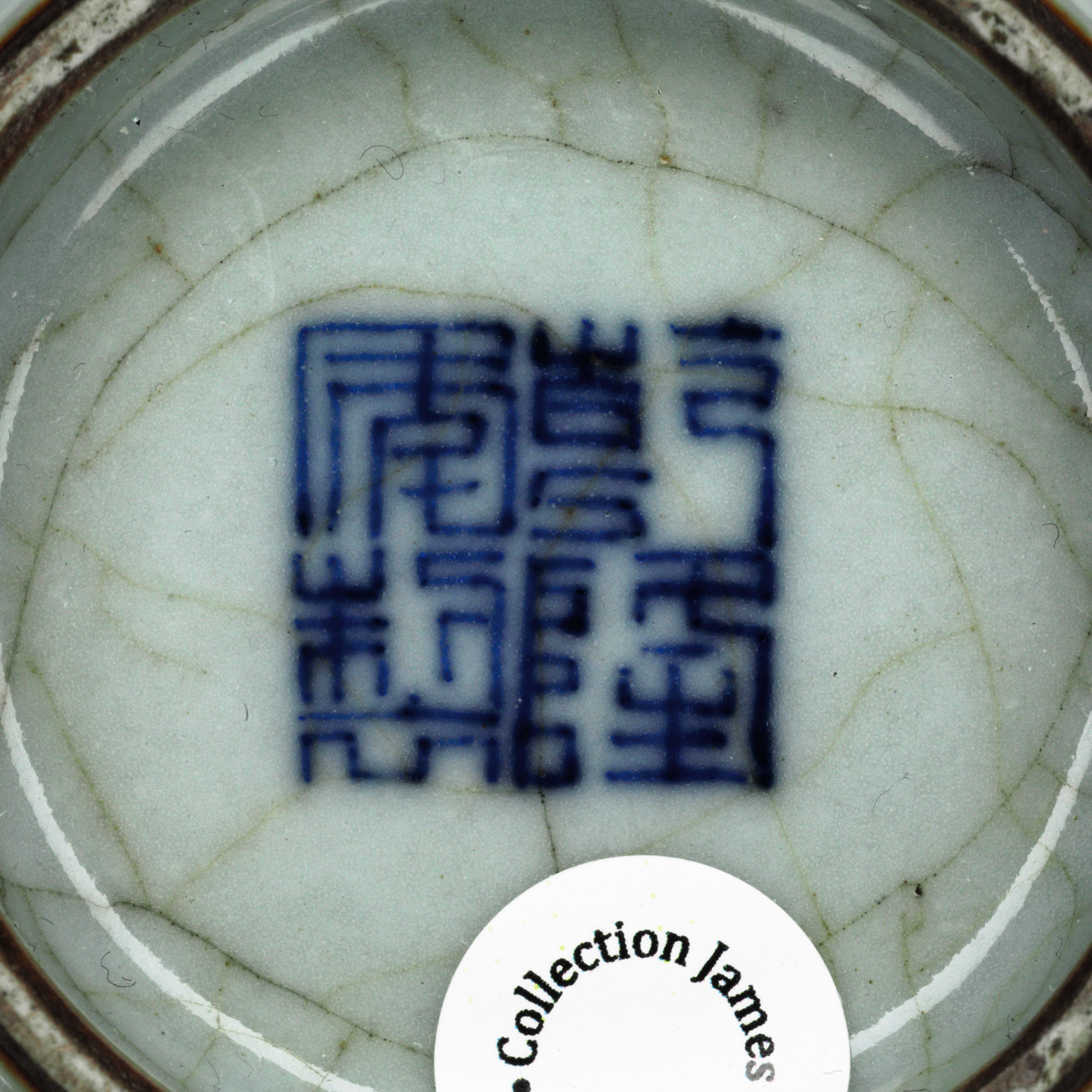
成交總額 USD 45,000
估價 USD 18,000 – USD 25,000
清乾隆
仿哥釉花口盌
四字篆書款
來源
Fong Chow (1923-2012) Collection, New York.
Christie’s New York, 21-22 March 2013, lot 1210.
拍品專文
A pair of similar bowls with Qianlong seal marks is illustrated in Selected Ceramics from the Collection of Mr. & Mrs. J. M. Hu, Shanghai, 1989, p. 110, no. 73. See, also, the pair of similar Qianlong-marked bowls from the collection of Stephen Junkunc, III, sold at Christie’s New York, 19 March 2008, lot 646.
編製圖錄及詳情
拍品前備註
PROPERTY FROM THE COLLECTION OF JAMES E. BREECE III
参考:佳士得拍賣 2689
中國瓷器及工藝精品
紐約|2013年3月21日 – 22日
拍品1210 清乾隆 仿官釉花口盌
QIANLONG FOUR-CHARACTER SEAL MARK IN UNDERGLAZE BLUE AND PROBABLY OF THE PERIOD
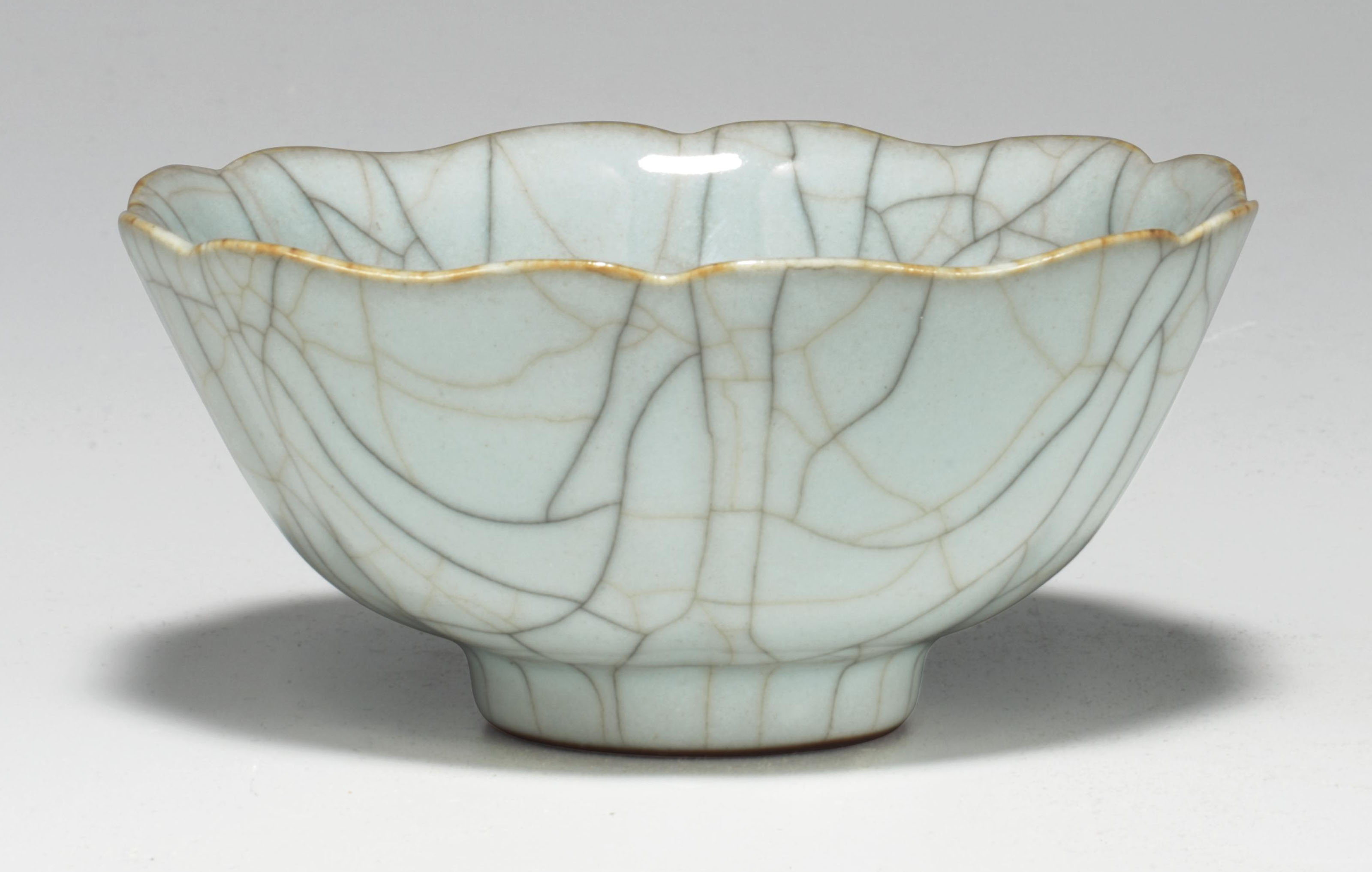
成交總額 USD 25,000
估價 USD 7,000 – USD 9,000
仿官釉花口盌
來源
Fong Chow (1923-2012) Collection, New York.
参考:佳士得拍賣 5305
重要中國瓷器及工藝精品
倫敦|2012年5月15日
拍品348仿官釉梅瓶清十八世紀
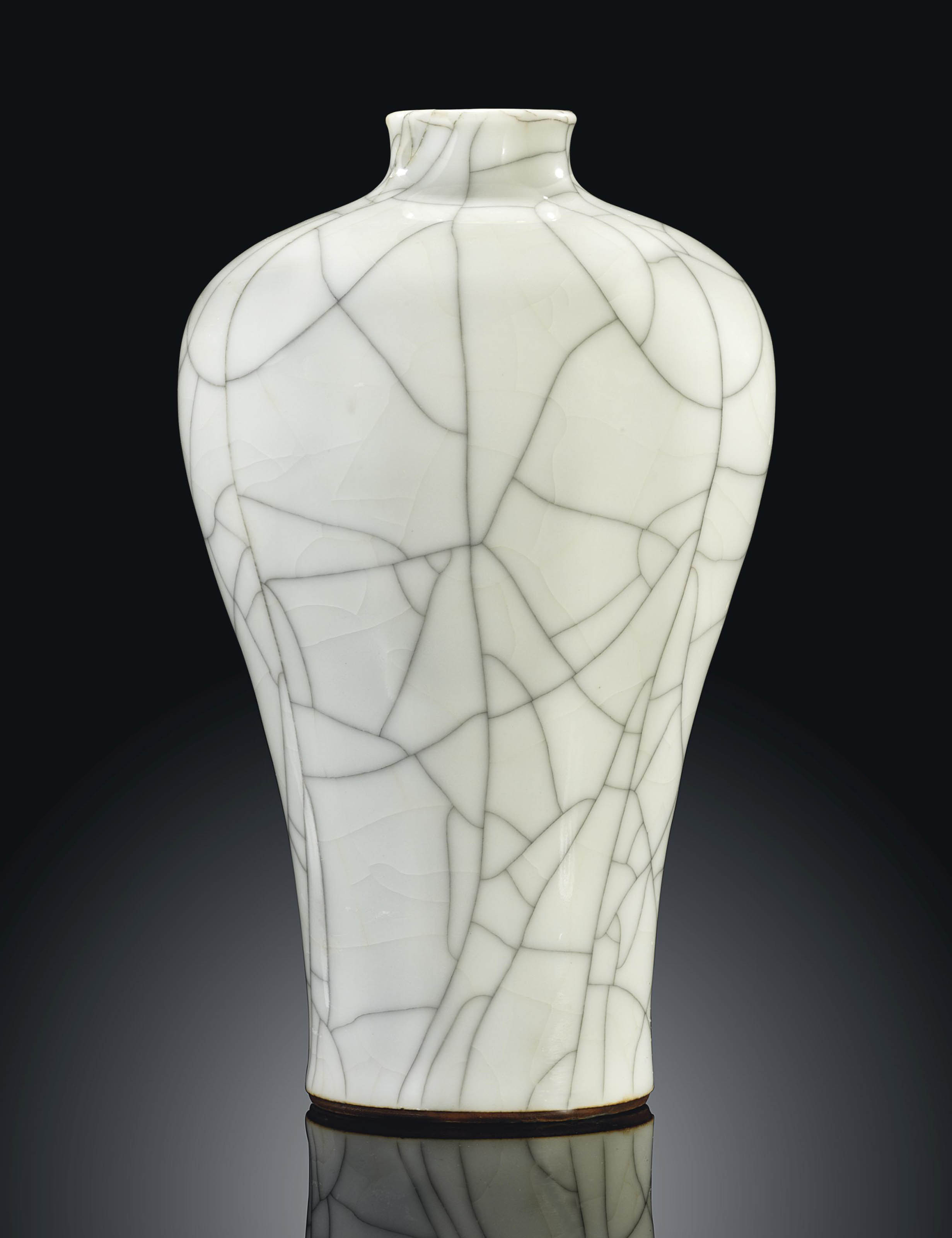
成交總額 GBP 10,000
估價 GBP 8,000 – GBP 12,000
清十八世紀 仿官釉梅瓶
來源
With Messrs. Bluett & Sons, London.
参考:佳士得拍賣 2190
重要中國瓷器及工藝精品
Hong Kong|2005年5月30日
拍品1488 清雍正 仿哥汉壶
A FINE GE-TYPE GLAZED VASE, HU
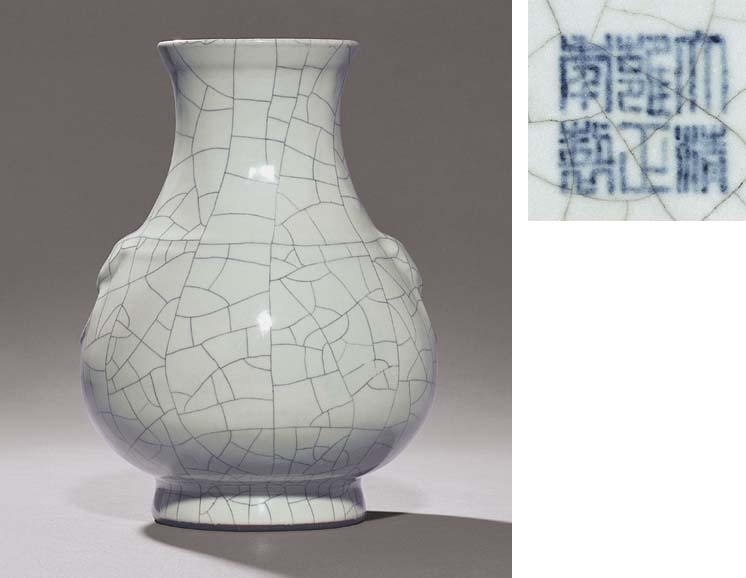
成交總額 HKD 1,680,000
估價 HKD 700,000 – HKD 900,000
A FINE GE-TYPE GLAZED VASE, HU
YONGZHENG SIX-CHARACTER SEALMARK AND OF THE PERIOD (1723-1735)
Modelled after a Han dynasty bronze hu, the pear-shaped vase moulded on the shoulder with a pair of monster masks with mock ring handles, joined by two horizontal ribs, covered overall with a lustrous grey glaze with a network of widely spaced dark brown crackles and paler less distinct crackles in imitation of Song geyao, the foot brown-dressed
10 in. (25.5 cm.) high, box
文獻及展覽
展覽
An Exhibition of Important Chinese Ceramics from the Robert Chang Collection, Christie’s London, 1993, Catalogue, p. 134, no. 61
拍品專文
Previously sold in these Rooms, 29 September 1992, lot 555.
A similar vase was sold in these Rooms, 30 October 2001, lot 833. The theme of archaism is represented two-fold on the present vase and others like it. The form is fairly close to a Han dynasty bronze hu vase, of a type that was no doubt readily available in the Imperial Collections in the 18th century. Likewise, the glaze is a realistic attempt to recapture the spirit of the primary and secondary crackle in the glaze, deliberately created by Southern Song potters for effect. The combination of these two aspects of archaism clearly found favour with the Qing emperors who, during the 18th century, had many items made in archaic forms and in the revered Song glazes.
Compare also with other ge-type glazed hu vases potted with broad shoulders tapering to a slightly narrower foot, such as the one sold in these Rooms, 27 October 2003, lot 706.
参考:佳士得拍賣 2580
重要中國瓷器及工藝精品 (1及2)
紐約|2012年9月13日 – 14日
拍品1542
清雍正 仿哥釉弦紋鋪首銜環耳壺 六字篆書款
YONGZHENG SEAL MARK IN UNDERGLAZE BLUE AND OF THE PERIOD (1723-1735)
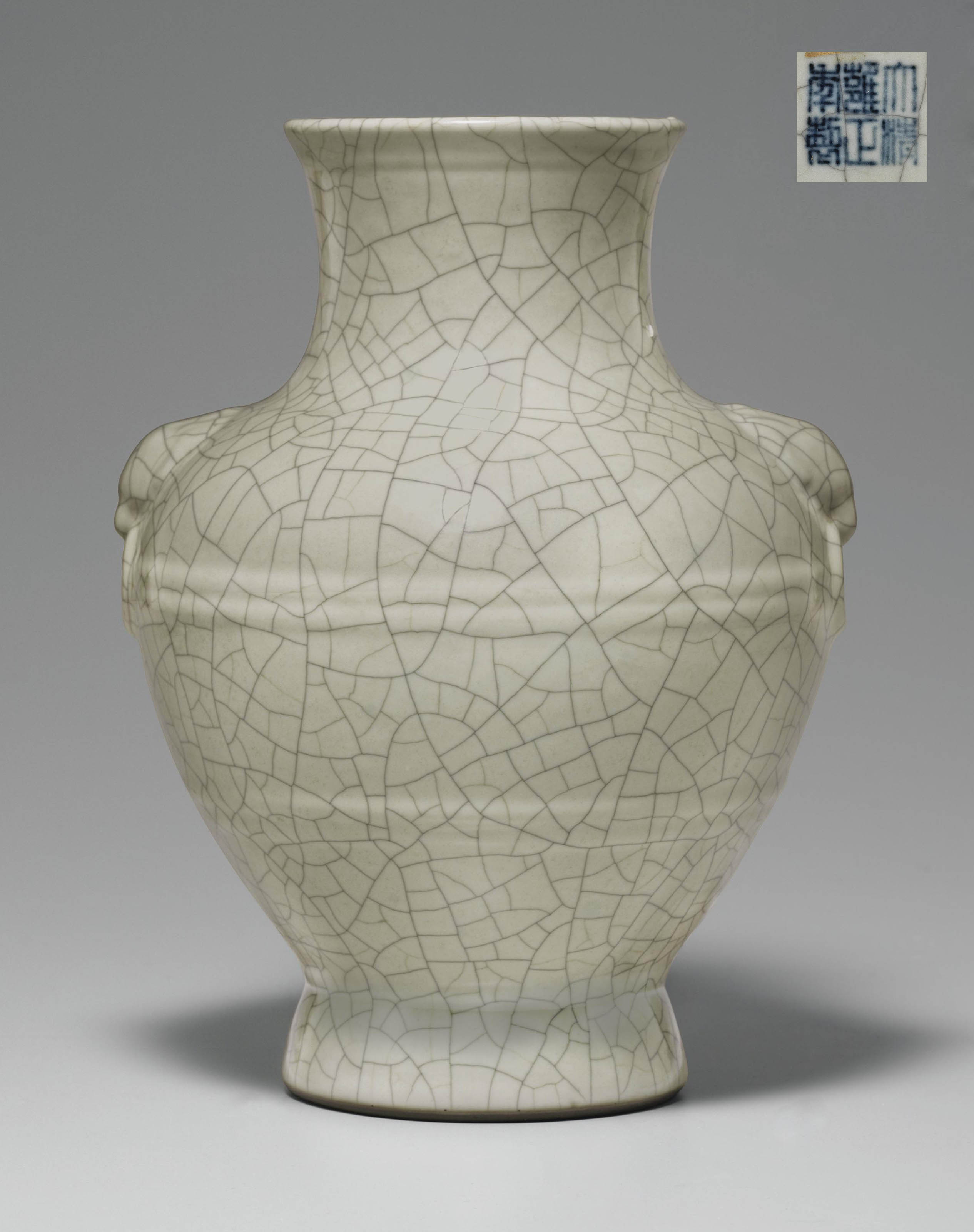
成交總額 USD 506,500
估價 USD 180,000 – USD 250,000
來源
Bluett & Sons (according to label).
拍品專文
The grey glaze suffused with dark grey crackle was inspired by the glazes found on Ge wares of Southern Song and Yuan date; one of the Song dynasty glazes greatly admired by the emperors of the high Qing. During the Yongzheng reign, much research and development was undertaken in order to reproduce the glazes of these wares on porcelains made at the imperial kilns at Jingdezhen. While many of these porcelains also imitate Song shapes, the form of the present hu was probably inspired by an ancient bronze vessel.
A closely related, Ge-type vase, also with a Yongzheng seal mark, and of the period, was sold at Sotheby Parke Bernet (Hong Kong), 21-22 May 1984, lot 180.
参考:佳士得拍賣 3265繽采御瓷:美國精粹收藏珍品香港|2013年11月27日拍品3201|清雍正 仿哥釉紙槌瓶 六字篆書款 YONGZHENG SIX-CHARACTER SEAL MARK AND OF THE PERIOD (1723-1735)
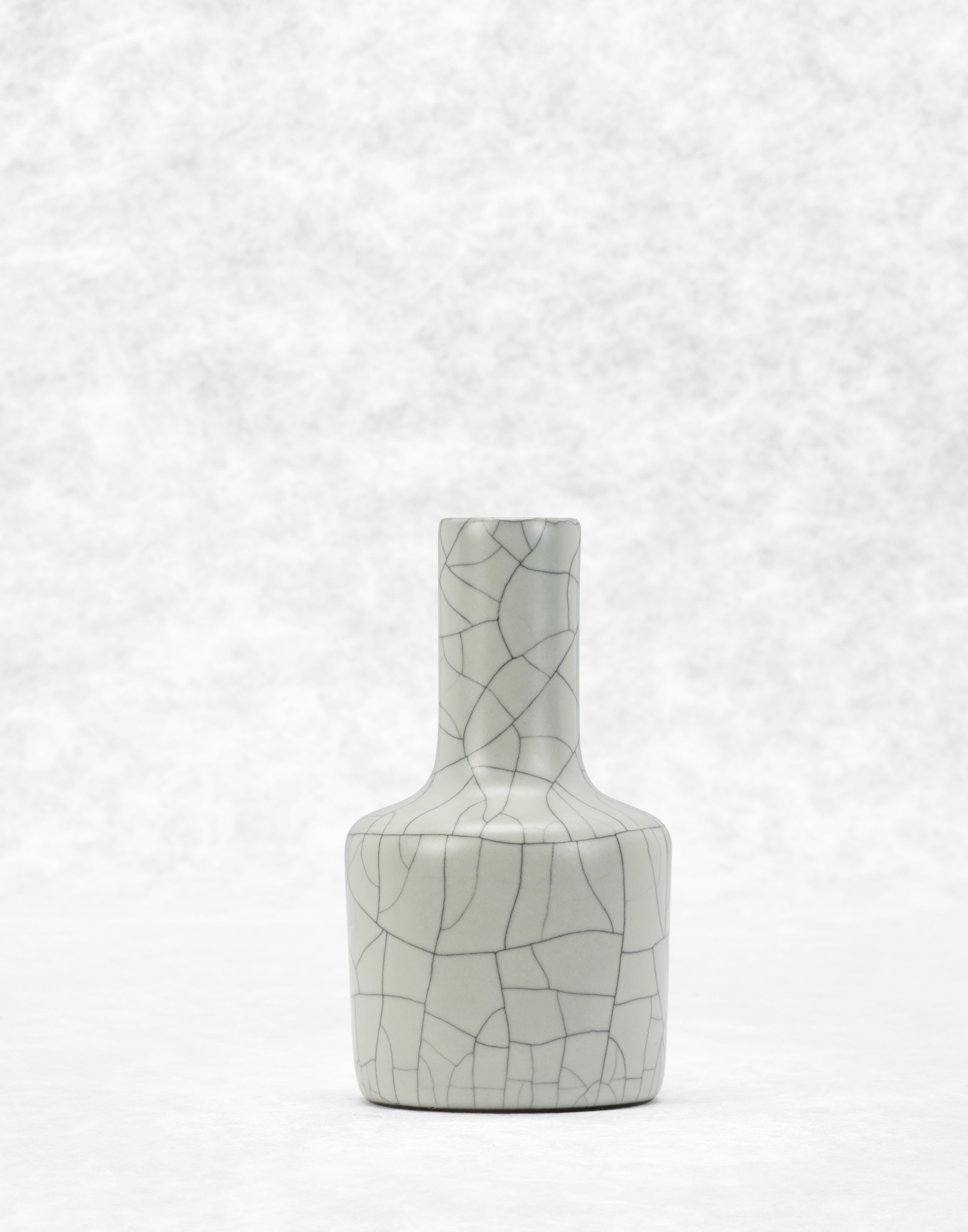
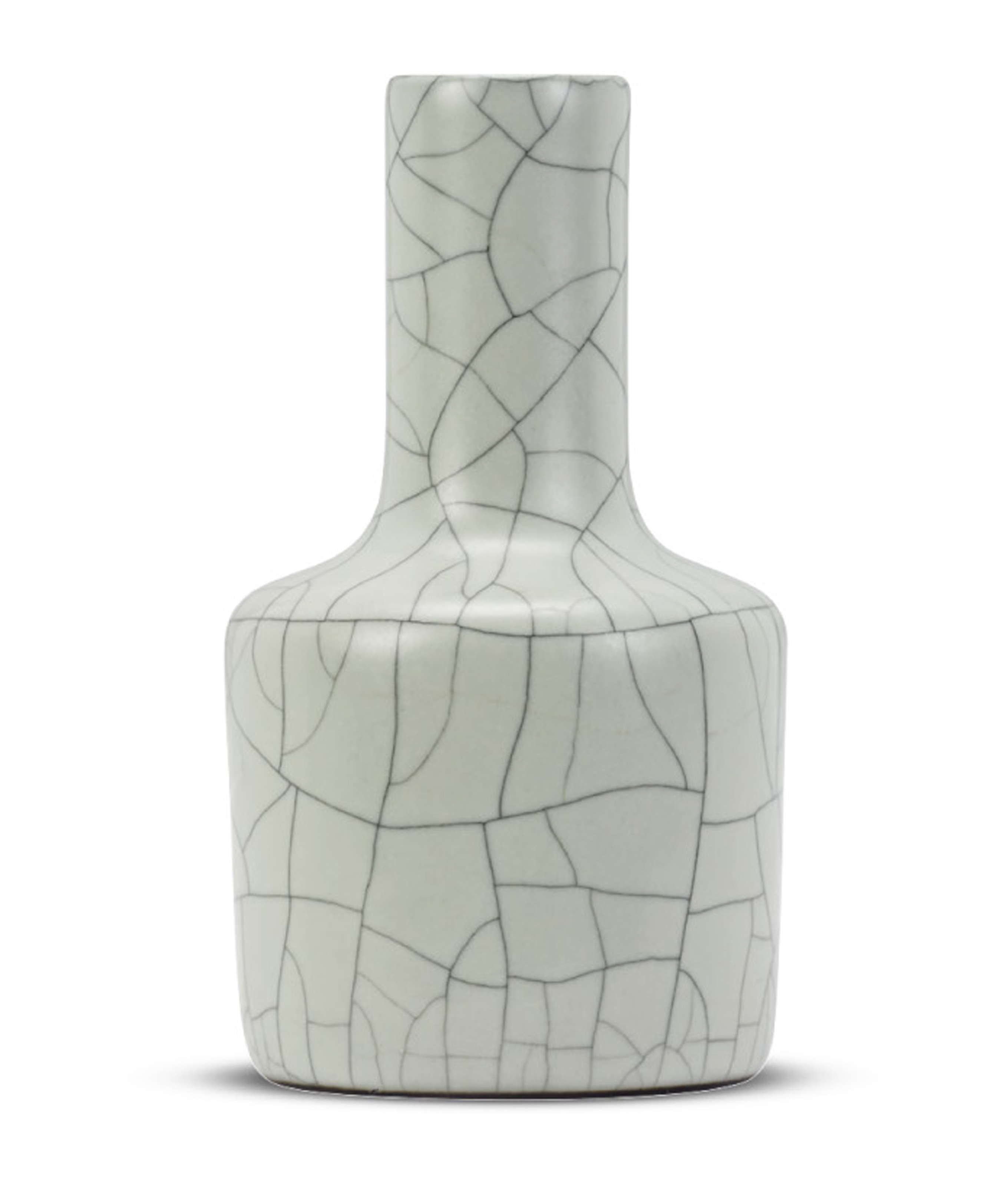
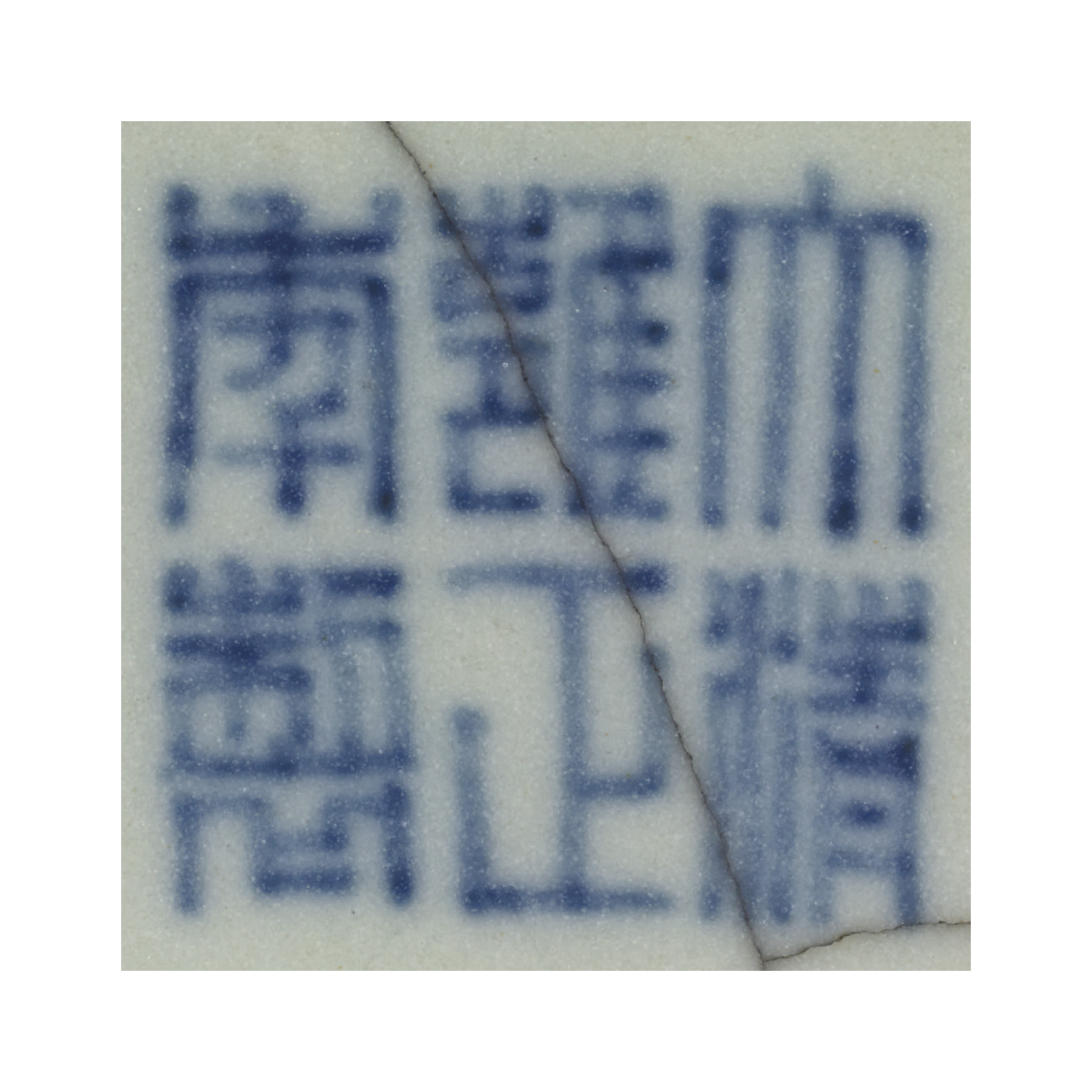
成交總額 HKD 2,440,000
估價 HKD 1,000,000 – HKD 1,500,000
瓶直口,長頸,方肩,筒形腹,臥足。通體施灰青釉,釉面大塊深色片紋。足沿塗醬褐釉,底青花書「大清雍正年製」篆書款。
本瓶無論形制、釉色均仿宋瓷。宋代原型可參考倫敦大維德中國藝術基金會所藏宋代定窰紙槌瓶;以及臺北故宮博物院收藏南宋官窰紙槌小瓶,該瓶刻乾隆御題詩,載於1989 年台北出版《宋官窯特展》,圖版24 號。
仿哥釉器始見於明永樂、宣德窰,至雍正朝發展最成熟,唐英著《陶成紀事碑》中記載:「(俱仿內發舊器色澤)一仿鐵骨哥釉,有米色、粉青二種。」當時的仿品釉色與古器非常相近,本瓶為代表作之一。
瑞典卡爾肯普博士珍藏一件近似例子;另見二例分別於香港蘇富比拍賣,1980年11月26日,拍品368號;1985年11月20日,拍品201號。玫茵堂舊藏一相似例子,有唇口,2011年10月5日於香港蘇富比拍賣,拍品1號。另參考一件雍正仿哥釉獸面耳壺,2007 年4 月8 日於蘇富比拍賣,拍品718 號。
此器2001 年10 月17 日於紐約蘇富比拍賣,拍品162 號。
來源
The Wu Family Collection, sold at Sotheby’s New York, 17 October 2001, lot 162
文獻及展覽
文獻
紛源流嬗:明清御瓷的各種影響 蘇玫瑰 亞洲藝術部資深學術顧問 歷來鑑藏家推崇明清御製瓷器,在於它們工藝卓越、形制及紋飾多元化。本拍賣專集的精品就體現了珍貴御瓷的各種影響因素,尤其於釉色及紋飾方面,它們一些製於明清的盛世年間,一些屬某個時代獨有,一些因應個別皇帝的喜好而特製。明永樂朝可算是御製白瓷的全盛時期,永樂皇帝崇白的品味正好體現於一件甜白釉玉壺春瓶(拍品3211號)。在景德鎮御窰遺址永樂堆積層所出土瓷器,逾90%為白瓷,大部份更是永樂窰特製的甜白瓷。甜白釉由純釉石提煉,不含釉灰,比其他白釉含氧化鈣量較低,含氧化鉀量較高;至於胎體則含氧化鋁較高,燒成溫度亦較高。因此無論胎體或釉色均較其他白瓷潔白,釉面柔滑潤瑩。
(1) 自古白色與佛教及特別祭典相關,永樂皇帝重視藏傳佛教基於外交原因及個人信仰。他身為皇子時已是虔誠的喇嘛教徒,登基後更致力推動藏傳佛教,詔令印製大量佛經。他邀請藏傳高僧到訪南京皇城,包括1407年法王哈立麻替皇考、皇妣主持祭典,並命御窰大規模燒造佛教禮器,以供高僧祭壇上使用。御窰遺址永樂堆積層所出土的大量白瓷,進一步印證出當時皇帝的崇白品味。精美的白瓷質如白玉,因此贏得他的珍賞。據載一次他曾退卻大量貴重貢物,僅留下少數素白玉器。他甚至愛白瓷多於美玉,永樂四年(1406)十月,西域回回國王向明朝進貢一批白玉盌,他命臣賜鈔遣回,並曰:「朕朝夕所用中國磁器,潔素瑩然,甚適於心,不必此也。」 (2) 永樂皇帝還因另一個人理由而鍾愛白色。1382年他還是燕王朱棣時,高僧道衍成為北平慶壽寺住持,(3)一次對談時道衍預言朱棣將獲白帽子加予爵位之上,即於王字上加白成「皇」,登基為帝。永樂皇帝可能因此自覺與白色淵源深厚。當朱棣進駐北平封地時,實際就是居住於元朝舊都,當地仍奉行許多蒙古習俗,蒙文與漢文並用。(4)燕王府邸就是元朝皇城,由蒙古僕人侍奉。他應深受蒙古人尚白的遺風影響。 元代瓷器及晚明文房瓷器往往取材版畫故事,明初御瓷卻出現了植物圖作主題。雖然花卉紋作為陶瓷紋飾由來已久,果枝紋卻延至明初才風行。大型的元代山水圖瓷器常見葡萄及瓜果紋,明代以前卻甚少出現其他種類的果枝紋。永樂御製青花瓷、甜白釉刻花瓷很多以果枝紋裝飾,本玉壺春瓶就是一例。永樂、宣德年間的御瓷無論盌盤或瓶類均普遍飾果枝紋。 這類果枝紋往往在嫩枝末端寫實地折斷,尤如從樹幹掉落,這是明十五世紀初青花瓷紋飾的創新手法,連同其他如花果同枝、植物根部等紋飾,均應取材草藥典藉插圖。早於公元前128年中國的草藥典籍已記載外來植物引入漢朝,宋金時代更大量出版植物學巨著,包括1249年唐慎微及寇宗奭合撰、張存惠重編《重修政和經史證類備用本草》。至明代這些出版物再次大行其道。 御瓷的果實紋,除反映植物學及草藥學的流行外,亦與花卉紋同樣極富象徵意味。本專集永樂玉壺春瓶刻石榴紋,石榴為「三多」之一,寓多子。另一件萬曆青花罐所飾百鶴紋(拍品3212號),則代表平安長壽的祝願,亦是晚明流行的紋飾,自嘉靖朝起常獲御窰採用。鶴諧音「和」,寓意和平;鶴的腿長,象徵崇尚與自然的和諧共生;鶴更寓意長壽,在圖畫中常伴於壽老身旁。早於1112年宋徽宗看到群鶴在皇宮上方盤旋飛舞,認為是太平盛世的徵兆,即揮毫作了著名的《瑞鶴圖》。從此瑞鶴紋成為藝術的流行裝飾。至明嘉靖朝鶴紋等長壽象徵更成為宮廷裝飾藝術的主流,以迎合皇帝渴求長壽的願望。一直以來,帝皇的長生不老夢往往影響藝術的潮流取向,隨後的隆慶及萬曆御瓷亦多見鶴紋,並延續至清代瓷器。傳統的青花地留白裝飾自嘉靖窰復興,至萬曆器仍出現,本罐就是一例。青花地留白的技術所費不菲,既耗用昂貴的鈷藍料,並且工序繁縟。 五爪龍是至尊的皇權象徵,在裝飾藝術方面經常結合代表皇后的鳳凰。帶角的五爪龍威猛尊貴,代表皇帝,常以不同形式出現,裝飾手法亦各異。陶瓷上龍紋可作釉下或釉上裝飾,一對礬紅彩龍鳳紋蓋罐(拍品3213號)就是釉上彩繪例子;另一件康熙豆青釉魚缸(拍品3210號)則以刻劃花裝飾;以及乾隆蘋果綠釉燈籠尊上所刻的凸龍紋(拍品3207號)。中國人視龍為祥瑞之獸,它不但象徵陽剛,並帶來雨水。春分時節蟄龍冬眠後醒來,從海中躍起,帶來雨水滋潤大地榖物。因此瓷器上常見龍騰海水紋,例如本蘋果綠釉燈籠尊。龍亦是四靈之一,青龍代表東方,西方為白虎,南方為朱雀,北方為玄武。鳳凰代表皇后,象徵美麗,本專集的礬紅彩龍鳳紋蓋罐(拍品3213號)就是一例。鳳凰經常結合花卉紋,多為蓮花,代表高貴純潔。古時將鳳凰與朱雀並論,因它亦代表南方,常以太陽襯托。雄為鳳,雌為凰,瓷器上的鳳凰紋往往成對出現,靠尾羽的不同特徵辨別。一對鳳凰就象徵婚姻美滿。 至於清瓷的其他單色釉亦不遑多讓。清代皇帝延續了明初祭祀用瓷的古風,並遵循禮法,以紅祭日,藍祭天,黃祭地,白祭月。雍正十年(1732)二月二十二日曾諭督陶官:「可將霽紅霽青黃色白色高足靶碗每樣燒造些。」雍正及乾隆窰均成功燒造霽藍器,見一件雍正梅瓶(拍品3203號)、一對雍正合盌(拍品3202號)。清御瓷霽藍釉採用最佳的鈷藍料,以最高標準燒成,生產出藍寶石般的釉彩。霽藍釉的呈色劑為鈷,不同地區的鈷礦所含的少量其他元素各有不同,計有鐵、鎂、鎳、銅,對燒成的藍釉產生不同的影響。含高鋁量的鈷料呈現較冷的藍色;含硅量較多則呈色較暖並偏紫,本雍正霽藍釉梅瓶就是一例。 清代御瓷不單仿摹古代單色釉器,成化窰鬥彩器亦是目標之一。鬥彩裝飾自成化朝後較少見,至十八世紀才復興。作法是先於釉下青花勾出輪廓,窰燒後在釉面填色,工序昂貴,因窰燒二次,壞燒的機會倍增,而且在素胎上以青花勾勒並不容許絲毫出錯,否則成品將被廢棄。這應是導致晚明鬥彩器產量銳減的原因。然而明初鬥彩器傳統上為鑑藏家夢寐以求的珍品,亦是清代皇帝諭令恢復的工藝。本專集的一對乾隆鬥彩蓋罐(拍品3209號),風格貼近明初原型。在另一件乾隆鬥彩花卉紋大盆(拍品3214號),則可見增廣的鬥彩色系。 清代琺瑯釉色的擴充有賴皇帝對技術的大力扶植。康熙皇帝對瓷器及琺瑯釉情有獨鍾,他命修建景德鎮御窰,復燒御瓷,更在北京紫禁城內設立造辦處製造各種物料的器物,包括琺瑯釉在內。康熙年間正是琺瑯釉技術突飛猛進的時期。清代五彩(famille verte)一詞最先由法國作家Jacqumart及Le Blanc提出,因這透明色系以綠釉為主。康熙五彩的紋飾繪工精細,更常配合釉下青花,這與明代五彩手法相近,因此亦慣稱五彩。康熙晚期至雍正初年,釉上彩技術長足發展,啟發出粉彩系列的誕生,粉彩(famille rose)一詞是因系列中包括黃金提煉的粉紅釉。粉彩最主要的顏色是白、黃。白釉最重要在於混和其他釉色以產生柔和的深淺效果。黃釉凝聚力強,在器面能形成立體釉點,是描繪花蕊的最佳顏料。粉彩釉色不但比五彩亮實,窰燒時亦不易流釉,適宜作精確描繪。清代發明的釉彩有助窰匠繪出細膩的紋飾,並衍生出更多的不同顏色,本鬥彩盆可算是其中的表表者。 以上概括了御瓷燒製的各種影響因素,計有皇帝個人品味、版畫插圖主題、皇家倡導研製、帝皇慕古之情、傳統紋飾延續、宮廷禮法,加上其他因素,遂產生出各式新穎多彩的明清御瓷。
1 劉新園著「明御廠故址與永、宣官窰遺存的發現」,載於《景德鎮珠山出土永樂宣德官窯瓷器展覽》,香港,1989年,72頁。
2 同上書,73頁。
3 道衍俗名姚廣孝。
4 Shih-Shan Henry Tsai, Perpetual Happiness – The Ming Emperor Yongle, Seattle & London, 2001, p. 33.
拍品專文
The shape of the current vase is inspired by mallet-form vases from the Song dynasty, such as a Ding example in the Percival David Foundation illustrated by S. Pierson and S.F.M. McCausland, Song Ceramics: Objects of Admiration, London, 2003, pp. 20-21, no. 1; and a Guan example in the National Palace Museum, Taipei, illustrated in Catalogue of the Special Exhibition of Sung Dynasty Kuan Ware, Taipei, 1989, p. 66, pl. 24.
A very similar Yongzheng marked example is illustrated by Bo Gyllensvard, Chinese Ceramics in the Carl Kempe Collection, Stockholm, 1964, p. 75, no. 194, later sold at Sotheby’s Paris, 12 June 2008, lot 97. Two further examples were sold at Sotheby’s Hong Kong, 26 November 1980, lot 368; 20 November 1985, lot 201. A similar Yongzheng example with a lipped rim from the Meiyintang Collection was sold at Sotheby’s Hong Kong, 5 October 2011, lot 1. For a Yongzheng hu-shaped example with animal masks, see the example sold at Sotheby’s Hong Kong, 8 April 2007, lot 718.
Compare also to a pair of Yongzheng-marked vases of slightly different form with lipped rims and covered in a Ru-type glaze, included in the exhibition Ethereal Elegance: Porcelain Vases of the Imperial Qing, The Huaihaitang Collection, Art Museum, the Chinese University of Hong Kong, 2007, p. 130, pl. 24.
編製圖錄及詳情
拍品前備註
Some Influences on Imperial Porcelain
Rosemary Scott – International Academic Director, Asian Art
The porcelains made for the Chinese Imperial court during the Ming and Qing dynasties have been prized by connoisseurs for centuries for their high level of artistry and the diversity of their forms and decoration. Research on the pieces in the current sale has stimulated consideration of various influences which shaped that diversity, especially in glazes and decoration. Some of these influences can be seen at work during the apogees of both Ming and Qing dynasties, others were specific to certain periods, and in some cases to the reigns of individual emperors.
The admiration of imperial white-glazed porcelains reached a peak in the reign of the Ming dynasty Yongle Emperor (1403-24), when his admiration for white may have inspired the tianbai or ‘sweet white’ glaze, seen on the pear-shaped vase in the current sale (lot 3211). More than 90 percent of the porcelains excavated from the Yongle strata at the site of the imperial kilns are white wares, and most have the specific type of white glaze known as tianbai or ‘sweet white’, which appears to have been developed during the Yongle reign. This glaze was made almost entirely from glaze stone with little or no glaze ash. The glaze was lower in calcium oxide than previous white glazes, and higher in potassium oxide. The body of tianbai wares had a higher proportion of aluminium oxide than previous wares and required a higher firing temperature. The result was a whiter body covered with a whiter glaze than had previously been achieved, while the glaze had a silky, unctuous texture.
White was a colour linked to Buddhism and specific rituals. Tibetan Buddhism was important to the Yongle emperor for diplomatic reasons, and also for personal devotion. He was an adherent of Lamaism before he ascended the throne, and as emperor his support for Buddhism was evident, for example, in the number of Buddhist texts which were produced under his auspices. Yongle invited important Tibetan hierarch to come to his capital and ordered large quantities of sacrificial vessels to be made at the imperial kilns for the ceremonies conducted by them, particularly those undertaken by Halima in honour of the emperor’s deceased parents in 1407.
The high proportion of white porcelain found in the Yongle strata was also probably a response to the emperor’s personal fondness for white vessels. Fine white porcelain with tianbai glaze bears a notable resemblance to fine white jade and it is possible that this was the intention, since it is recorded that on one occasion the emperor returned all the elaborate and costly gifts presented to him, keeping only those made of plain white jade. However, he may even have preferred white porcelain over jade, since in the 10th month of the 4th year of his reign (AD 1406) Yongle received a tribute of jade bowls from the Muslim ruler of a Western state. The emperor commanded that the tribute should be returned together with a monetary gift, saying: ‘The Chinese porcelain that I use everyday is pure and translucent, and it pleases me greatly. There is no need to use jade bowls.’
There is another reason why he may have been drawn to the colour white. In 1382 Zhu Di, who would later become the Yongle Emperor, met a Buddhist monk called Dao Yan (Dl) who had arrived in Beiping to become abbot of the Qingshou (Celebrating Longevity) monastery. During a discussion Dao Yan predicted that Zhu Di would put a white hat on his rank. This was a play on the composition of Chinese written characters. If the character for white bai is placed on top of the character for prince wang, it forms another character, huang meaning emperor. This was therefore a prediction that Zhu Di would become emperor. It is therefore possible that as emperor Yongle retained a superstitious attachment to white. Finally it is significant that when Zhu Di, as a prince, took up his fiefdom in Beiping, he was essentially entering the old Mongol capital. Many Mongol customs were still prevalent in Beiping, and the Mongol language and script were used alongside Chinese. Zhu Di’s residence was the former Mongol imperial palace with Mongol servants, and since white was an important and greatly favoured colour for the Mongols, and it is probable that Zhu Di absorbed a taste for the colour during his time there.
The influence of illustrated printed books is usually identified on porcelains of the Yuan and on porcelains made for the literati in the later Ming dynasty. However, in the early Ming period certain imperial porcelains reflected an interest in illustrated books on plants. Although flowers had been a popular source of decorative motifs for centuries, the regular inclusion of fruit on the branch was a more recent phenomenon in the early Ming. Melons, grapes and gourds had been included in the landscape element designs on some large Yuan dynasty vessels, but depictions of other fruit on branch or stem were rare on pre-Ming porcelains. However in the Yongle reign both imperial blue and white porcelains, and those monochrome white wares with tianbai glaze bearing incised designs were regularly decorated with fruiting sprays, as is the case on the current pear-shaped vase. Sprays of fruit on the branch became a very popular decorative theme on both open and vertical forms among the imperial wares in both the Yongle and Xuande (1426-35) reigns.
The sprays often have the feature of a naturalistic break at the end of the twig – as if each spray had been torn off the branch. This naturalistic approach was a new one on early 15th century blue and white wares, and it is probable that this and the frequent depiction of both flowers and fruit on the same branch, as well as occasionally details of plant roots, were influenced by the woodblock illustrations in materia medica – pharmaceutical literature dealing with plants for their medicinal properties. The study of plants was well enough established for specific mention to be made of foreign plants being brought into China in records dating to the Han dynasty in about 128 BC, but it was during the Song (960-1279) and Jin (1115-1234) dynasties that there was a huge increase in new and extensive publications on the subject of plants, such as the Chongxiu Zhenghe Jingshi Zhenglei Beiyong Bencao (New Revision of the Classified and Consolidated Armamentarium Pharmocopoeia of the Zhenghe Reign) by Tang Shenwei and Kou Zongshi and revised by Zhang Cunhui, published in 1249. Interest in such publications flourished once again in the Ming dynasty.
As well as any botanical or medicinal interest they might have, the fruit – like the flowers – included in the designs on imperial porcelains would have been chosen with care for their significance and symbolic meaning. The fruit on the Yongle pear-shaped vase are pomegranates, and the pomegranate is one of the san duo or Three Abundances, and represents the wish for abundant progeny or many sons. The importance of iconography can also be seen on the large Wanli (1573-1619) blue and white jar (lot 3212), which bears a design of many cranes flying amongst clouds. Cranes are associated with peace and longevity, and have thus been a particularly popular motif on porcelain – especially during the 16th century. They came to prominence as a decorative motif on imperial porcelain during the reign of the Jiajing Emperor (1522-1566). The Chinese word for crane is he, which is a homophone for the word for harmony, and thus cranes also represent peace. Their long legs were described as resonating with the harmonies of nature and Heaven. Cranes are also known to live for many years and thus have become associated with long life, and indeed are often depicted as the familiars of the Star God of Longevity, Shoulao. As early as the 12th century, the Chinese Emperor Huizong (r. 1101-25) painted a flock of cranes, which were seen flying above the palace in AD 1112, in order to record such an auspicious event, and they have been a popular subject in the arts ever since. Their rise to particular prominence in the Jiajing reign was undoubtedly due to the Emperor’s obsession with long life, which resulted in a plethora of symbols of longevity appearing on items made for his court. However, the long life of the emperor was always an artistic inspiration, and the depiction of cranes on imperial porcelains continued into the reigns of the Longqing Emperor (1567-72) and Wanli Emperor, and, indeed, can be seen on porcelains of the Qing dynasty. Interestingly, the technique of reserving the white motif against a blue ground was also one that was revived in the Jiajing reign and continued into the Wanli period, as can be seen on the current jar. It was an extravagant technique, since it required both more of the expensive cobalt, and also more hours of the decorator’s time.
The most powerful symbol of imperial majesty was the five-clawed dragon, which on the decorative arts was often complemented by the phoenix, symbol of the empress. The powerful five-clawed imperial dragon with horns was the symbol of the emperor, and appears in many forms on the Chinese decorative arts. In ceramics the dragon may be painted under or over the glaze, as on the jars decorated in iron-red enamel in the current sale ((lot 3213), incised, carved, as on the large Kangxi (1662-1722) celadon-glazed fish bowl in the current sale ((lot 3210), or carved, like the creature which writhes over the surface of the Qianlong (1736-1795) green lantern vase in the current sale ((lot 3207). The Chinese dragon, unlike his European counterpart, is a beneficent creature. He is not only the essence of the yang (positive/male) properties, but is also a bringer of rain. The dragon was supposed to rise from winter hibernation among the waves at the Spring Equinox to bring the rain necessary to water the crops, which is why he is so often depicted rising from the waves on ceramics like the green Qianlong vase. The dragon is also one of the si ling – creatures of the four quarters – the green dragon representing the east. The west is represented by the white tiger, the south by the red bird, while the symbol of the north is the so-called dark warrior – usually depicted as a tortoise and snake combined.
The symbol of the empress is the phoenix, which is also a symbol of female beauty, is seen on the iron-red enamelled jars in the current sale (lot 3213). The phoenix is often shown amongst floral scrolls – frequently lotus scrolls. This combines the idea of feminine beauty, represented by the phoenix, with that of purity, which is represented by the lotus. In early times the phoenix was also associated with the red bird, which, because it represents the south, is seen as having an auspicious alignment with the sun.
Interestingly, in the same way that the characters for phoenix in Chinese combine the characters for male and female phoenix (fenghuang), when two phoenixes are depicted on materials such as porcelain, they are usually shown as a male and a female, distinguished by their different tail feathers . A pair of phoenixes was also believed to symbolize happiness in marriage.
One of the first glazes to receive imperial approbation in China was a celadon green glaze on Yue stonewares, which found favour with the ruling houses of the Tang dynasty (AD 618-907). The popularity of this glaze laid the foundations for the appreciation of celadon glazes in succeeding dynasties. In the 18th century the Jingdezhen imperial kilns devoted considerable research and development to the production of celadon glazes applied to a white porcelain body. Although the Longquan kilns continued to produce fine celadon-glazed wares into the Ming dynasty, and celadon-type glazes, coloured with small quantities of iron, applied to a porcelain body were produced at Jingdezhen in the early Ming period, it was the Qing dynasty potters of the Kangxi reign who perfected a particularly delicate version applied to very white body, as on the fine Kangxi celadon fish jar in the current sale ((lot 3210). The delicate celadon glaze was coloured using only about half the amount of iron found in typical Longquan celadons, and was further modified in the Yongzheng period (1723-1735) to produce an even more finely textured and slightly bluer pale celadon glaze, like that seen on the exquisite Yongzheng bowl in the current sale ((lot 3208). These celadons and the others created with minute variations in tone and texture have been much admired by Chinese connoisseurs and have been given names such as douqing (bean green) and dongqing (eastern green) in the Kangxi reign, dongqing (winter green) and fenqing (soft green) in the Yongzheng reign.
In addition to the new celadon glazes, deliberate copies of Song crackled glazes were also developed at the Qing imperial kilns in response to the emperors’ admiration for these early wares. The three great Qing emperors Kangxi, Yongzheng and Qianlong were all keen antiquarians, who collected and studied material from earlier dynasties. Copies of Song dynasty crackled wares had been made at the imperial kilns of the 15th century, but the Qing examples are even more impressive in the accuracy with which they reproduce the appearance of the Song dynasty stoneware glazes on Jingdezhen white porcelain. The Yongzheng emperor is recorded to have specifically required that good copies of Song glazes be produced at Jingdezhen, and fortunately the successful copying of these Song dynasty stoneware glazes on Qing dynasty imperial porcelains was something for which the famous kiln director Tang Ying became well known. The current sale includes two vessels which demonstrate the success of the Yongzheng kilns in fulfilling the emperor’s wishes – a mallet vase with Ge-type glaze (lot 3201) and a large jar with a Ru-type glaze ((lot 3204).
An added spur to the production of monochrome-glazed porcelains was the fact that the Qing dynasty emperors continued the tradition, first formulated in the early Ming period, of using porcelains for imperial sacrifices and ascribing certain colours to particular altars – red for the Altar of the Sun; blue for the Altar of Heaven; yellow for the Altar of Earth; and white for the Altar of the Moon. On the 22nd day of the 2nd month of the 10th year of Yongzheng (1732), the emperor sent an order to the imperial kiln director commanding him to: ‘Make a number of stem cups in each of the following colours: sacrificial red, sacrificial blue, yellow and white.’ Spectacular cobalt blue monochromes were made in the Yongzheng and Qianlong reigns, as can be seen from the Yongzheng meiping ((lot 3203) and pair of Yongzheng bowls ((lot 3202) in the current sale. These glazes benefited from having the best quality cobalt, prepared to the highest standard, which enabled the potters to produce glazes of jewel-like brilliance. The main colourant in all these glazes is cobalt, but it is worth noting that cobalt ores found in different locations contained small amounts of different elements such as iron, manganese, nickel or copper, which affected the final colour of the glaze. In addition glazes where the pigments were high in alumina tended to develop cobalt aluminates in firing and produce cooler blues, while those containing more silica produced cobalt silicates which gave warmer, more purplish, blues, like that seen on the Yongzheng meiping.
It was not only in monochrome wares that the imperial porcelains of the Qing dynasty reflected court interest in ceramics from earlier periods. Doucai was a decorative technique which flourished during the Chenghua (1465-1487) reign of the Ming dynasty, but which was little used thereafter, until its revival in the 18th century. In the doucai (abutted colours) technique the outlines of the design were painted in underglaze blue, and the enamel colours applied over the fired glaze within the blue outlines. It was a technique which would have been expensive, since not only did the pieces have to be fired twice – doubling the risk of losses in the kiln – but the painting of underglaze blue outlines (as opposed to whole motifs) on an unfired porous body left no room for error. Any mistakes would have resulted in the vessel being discarded. It is not surprising, therefore, that few doucai wares were produced in the later Ming dynasty reigns. However, the early Ming dynasty doucai porcelains were traditionally highly esteemed and the great Qing emperors demanded a revival of the technique. In some cases, such as the two Qianlong lidded jars in the current sale ((lot 3209) the potters kept largely to the earlier Ming dynasty style, however, in other cases they made full use of new technological developments, as can be seen in the expanded colour palette of the Qianlong basin in this sale ((lot 3214).
This expanded colour palette was itself developed as a result of imperial patronage. The Kangxi emperor had a particular interest in porcelain and in enamels. He commissioned the rebuilding of the kiln complex at Jingdezhen for the production of imperial porcelain, and he also established imperial ateliers within the Imperial Palace in Beijing to work in a range of different media, including enamels. It was during his reign that the Qing dynasty enamel palette was expanded and refined. The Qing dynasty so-called famille verte palette – named by two French writers, Jacqumart and Le Blanc, in 1862, because of the dominance of green in this palette – contained primarily transparent enamel colours. In the Kangxi reign enamels in this famille verte palette were painted with great refinement, and often combined with underglaze blue using a similar decorative technique to the earlier wucai – indeed they are sometimes described as wucai. At the end of the Kangxi reign and beginning of the Yongzheng reign there were further developments in overglaze enamels, which lead to the establishment of the palette, which became known in Europe as famille rose. The enamel colour that gave the palette its name is a rose pink which was produced using colloidal gold. Two other colours were key to the painting styles which developed in this palette – these were an opaque white enamel and an opaque yellow enamel. The opaque white enamel was especially important in that it could be mixed with other colours to create pastel shades. The opaque yellow enamel was of a consistency that it could be used in small dots which stood slightly proud of the surface of a vessel, and was particularly effective for painting the anthers in the centre of blossoms. Not only were most of the enamels of the famille rose palette more opaque than their wucai equivalents, they also had the advantage to the ceramic decorator that they did not flow when fired, and could therefore be used with extreme precision. The precision allowed by the new enamels, as well as the much greater range of colours available to the decorator, enabled the Qing dynasty ceramic decorators to produce more detailed and more varied designs in the doucai technique, as displayed on the Qianlong basin.
Thus it can be seen that many different influences were brought to bear on imperial porcelains, including the personal tastes of emperors; illustrations from printed books; the imperial patronage of technological development; imperial fascination with antiques; the importance of traditional iconography; and court ritual usage. These influences, and others, combined to ensure that the imperial porcelains of the Ming and Qing dynasties were as diverse and technologically refined as they were beautiful.
参考:佳士得
拍卖 17741 私人珍藏重要中国瓷器
香港|2019年11月27日
拍品2901 清雍正 仿哥釉紙槌瓶 六字篆書款
A FINE AND RARE GE-TYPE GLAZED MALLET-FORM VASE
YONGZHENG SIX-CHARACTER SEAL MARK IN UNDERGLAZE BLUE AND OF THE PERIOD (1723-1735)
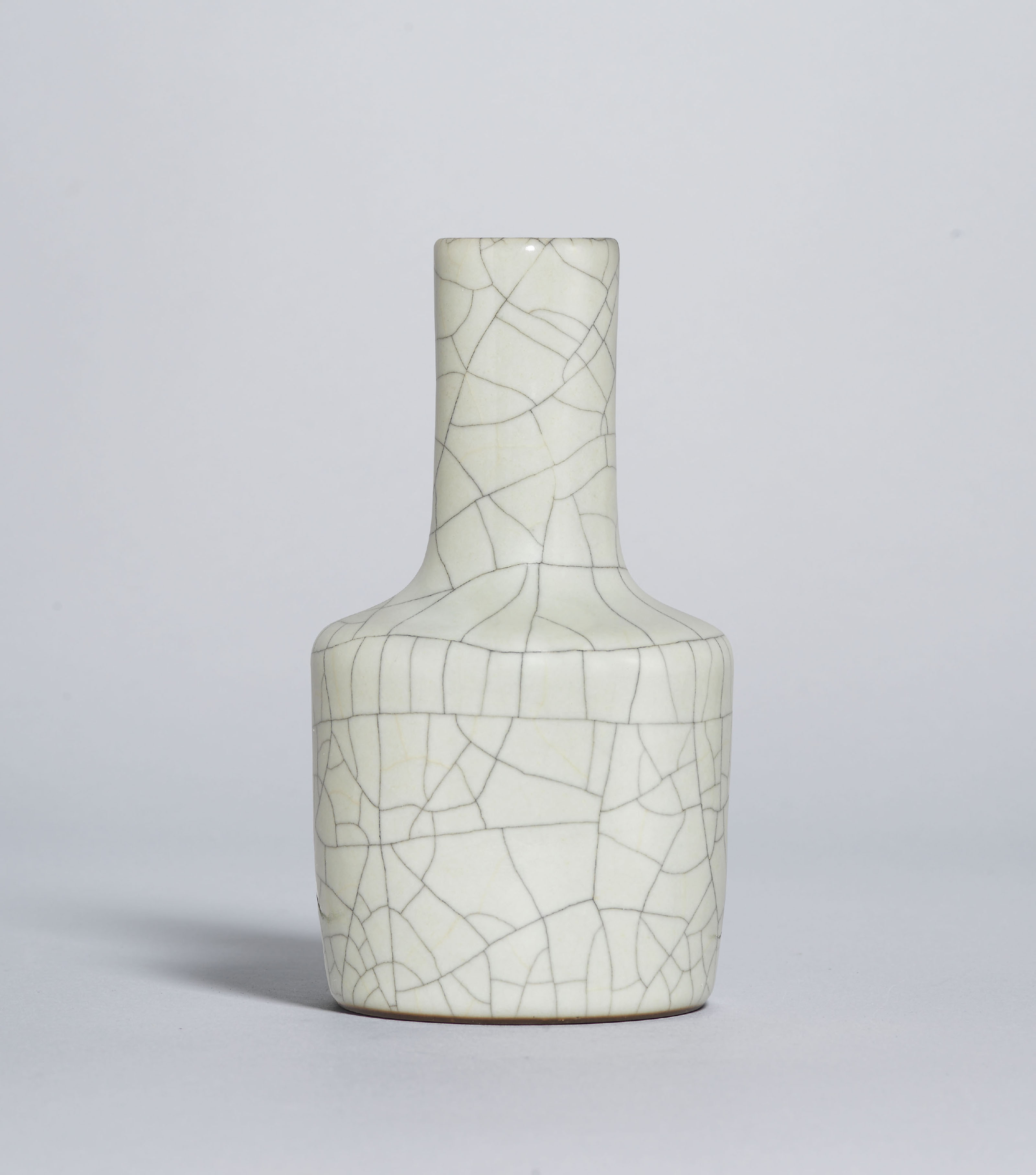
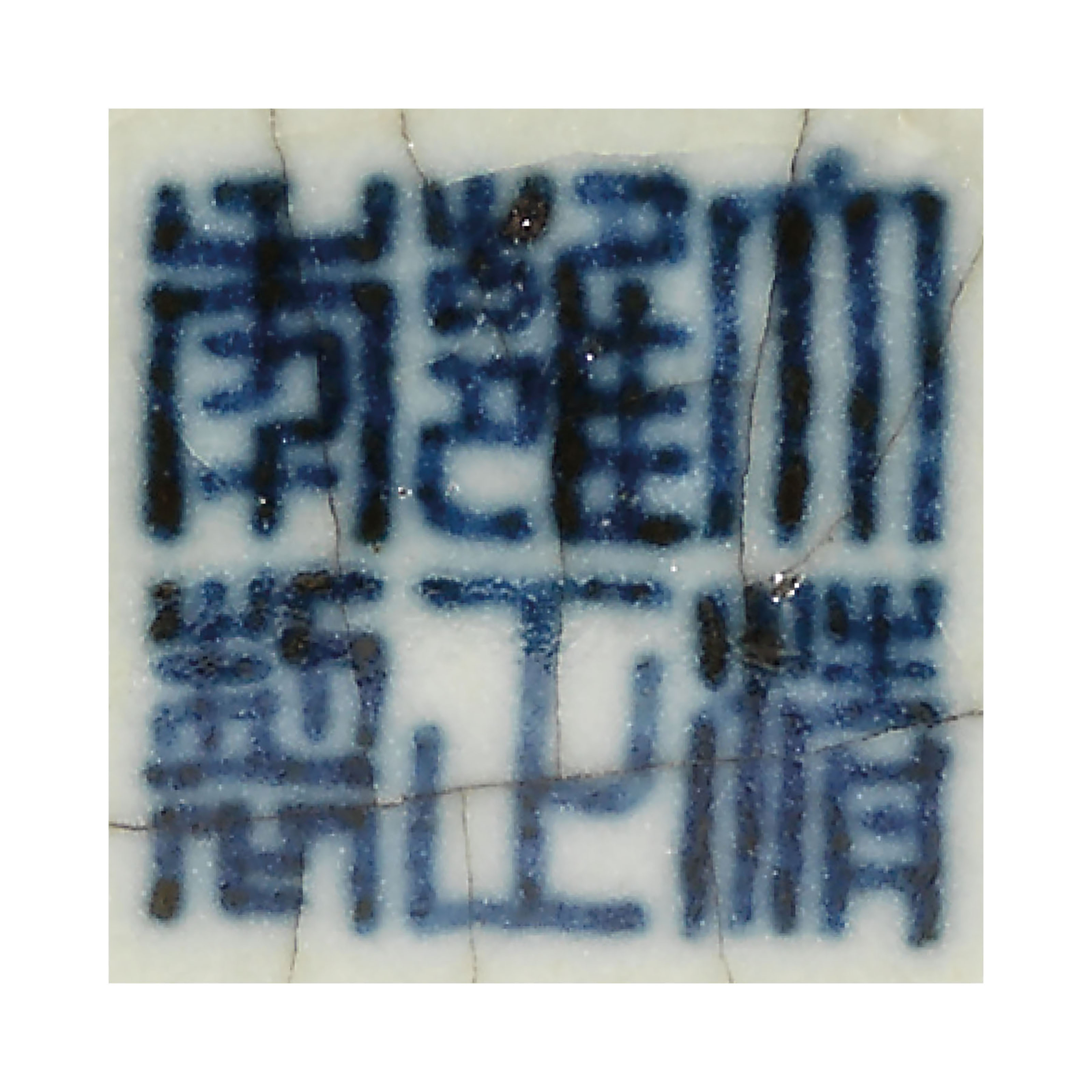
成交價 HKD 3,965,000
估價 HKD 1,000,000 – HKD 1,500,000
清雍正 仿哥釉紙槌瓶 六字篆書款
瓶直口,長頸,方肩,筒形腹,臥足。通體施灰青釉,釉面大塊深色片紋。足沿塗醬褐釉,底青花書「大清雍正年製」篆書款。
6 ½ in. (16.5 cm.) high, box
來源
香港蘇富比,1998年4月28日,拍品755號
狀況報告
謹請注意,所有拍品均按「現狀」拍賣,閣下或閣下的專業顧問應於拍賣前親自查看拍品以評鑑拍品之狀況。
-整體品相良好
拍品專文
本瓶無論形制、釉色均仿宋瓷。宋代原型可參考倫敦大維德中國藝術基金會所藏宋代定窯紙槌瓶;以及臺北故宮博物院收藏南宋官窯紙槌小瓶,該瓶刻乾隆御題詩,載於1989 年台北出版《宋官窯特展》,圖版24 號。
仿哥釉器始見於明永樂、宣德窯,至雍正朝發展最成熟,唐英著《陶成紀事碑》中記載:「(俱仿內發舊器色澤)一仿鐵骨哥釉,有米色、粉青二種。」當時的仿品釉色與古器非常相近,本瓶為代表作之一。
瑞典卡爾肯普博士珍藏一件近似例子,2008年6月12日於巴黎蘇富比拍賣,拍品97號;另見一例於香港佳士得拍賣,2013年11月27日,拍品3201號。另二例分別於香港蘇富比拍賣,1980年11月26日,拍品368號;1985年11月20日,拍品201號。玫茵堂舊藏一相似例子,有唇口,2011年10月5日於香港蘇富比拍賣,拍品1號。
A FINE AND RARE GE-TYPE GLAZED MALLET-FORM VASE
YONGZHENG SIX-CHARACTER SEAL MARK IN UNDERGLAZE BLUE AND OF THE PERIOD (1723-1735)
The vase is finely potted with angled shoulders rising to a cylindrical neck, covered overall with a thick pale grey glaze suffused with dark crackles, stopping neatly above the foot rim applied with a dark-brown dressing.
6 ½ in. (16.5 cm.) high, box
来源
Sold at Sotheby’s Hong Kong, 28 April 1998, lot 755
拍品专文
The shape of the current vase is inspired by mallet-form vases from the Song dynasty, such as a Ding example in the Percival David Foundation illustrated by S. Pierson and S.F.M. McCausland, Song Ceramics: Objects of Admiration, London, 2003, pp. 20-21, no. 1; and a Guan example in the National Palace Museum, Taipei, illustrated in Catalogue of the Special Exhibition of Sung Dynasty Kuan Ware, Taipei, 1989, p. 66, pl. 24.
A very similar Yongzheng-marked example was sold at Christie’s Hong Kong, 27 November 2013, lot 3201. Further examples include one illustrated by Bo Gyllensvard, Chinese Ceramics in the Carl Kempe Collection, Stockholm, 1964, p. 75, no. 194, later sold at Sotheby’s Paris, 12 June 2008, lot 97; one sold at Sotheby’s Hong Kong, 26 November 1980, lot 368; and one sold at Sotheby’s Hong Kong, 20 November 1985, lot 201. A similar Yongzheng example with a lipped rim from the Meiyintang Collection was sold at Sotheby’s Hong Kong, 5 October 2011, lot 1. For a Yongzheng hu-shaped example with animal masks, see the example sold at Sotheby’s Hong Kong, 8 April 2007, lot 718.
参考:纽约大都会博物馆
清 康熙 仿哥釉盘口尊
Vase
China

Object Details
Period:Qing dynasty (1644–1911), Kangxi period (1622–1722)
Culture:China
Medium:Porcelain
Dimensions:H. 8 1/4 in. (21 cm)
Classification:Ceramics
Credit Line:Bequest of Benjamin Altman, 1913
Accession Number:14.40.6
Signatures, Inscriptions, and Markings
Marking: None
Provenance
Benjamin Altman , New York (until d. 1913; bequeathed to MMA)
Timeline of Art History
Timelines
Central and North Asia, 1600-1800 A.D.
China, 1600-1800 A.D.
参考: 拍卖结果 > 保利厦门2017秋季拍卖会 > 玄览—重要古董器物专场 > 清乾隆 仿哥釉螭耳尊
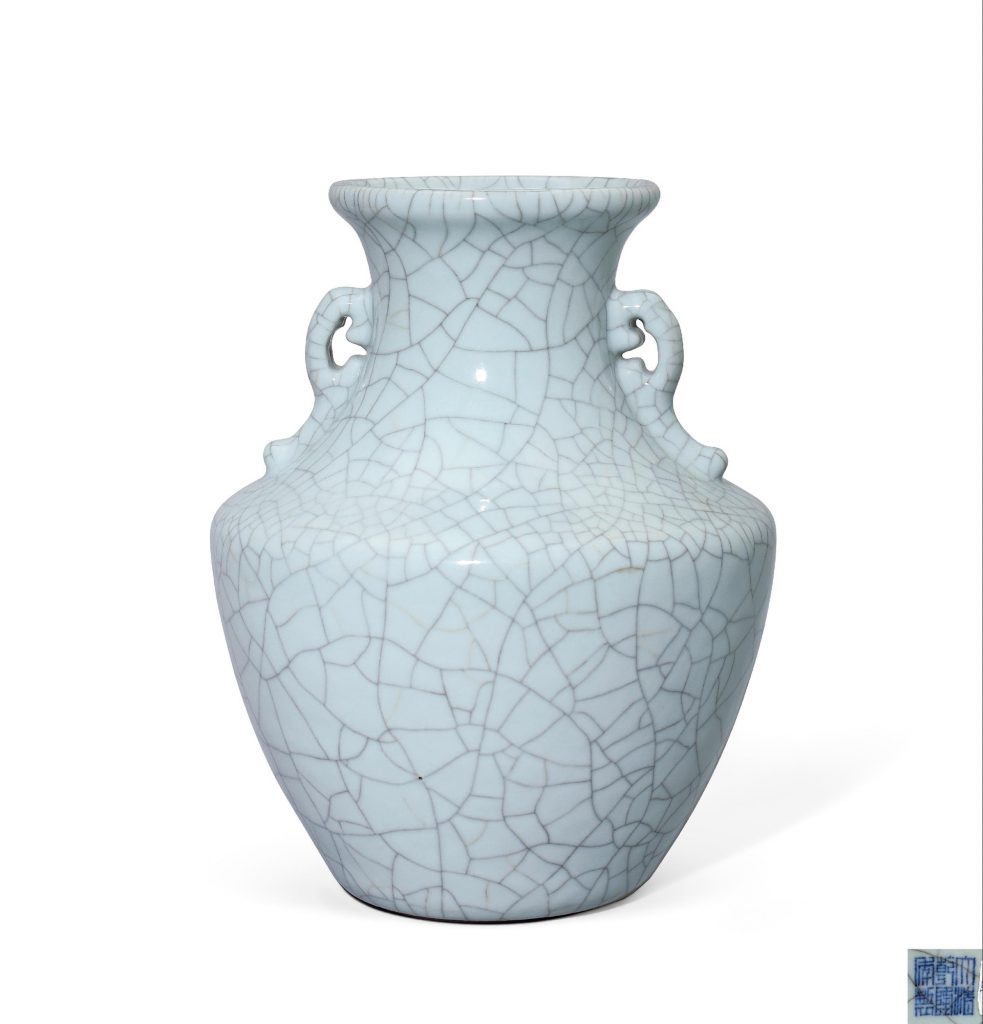
拍卖信息
Lot 0939 清乾隆 仿哥釉螭耳尊
估价:1,200,000-1,800,000 RMB
成交价: 3,565,000 RMB (含买家佣金)
尺寸: 高22.8cm
拍品说明:
著录《玫茵堂中国陶瓷》,康蕊君,伦敦,1994-2010年,卷2,编号877,218页,图877 「大清乾隆年制」六字三行篆书款 本尊属于乾隆仿古创新之作,彰显了弘历钟情于哥窑的文人性情。尊撇口,收颈,垂腹,下承圈足,短颈处饰双螭耳,玲珑曲折,为器身平添起伏婉转之美,实收点睛之妙,内外皆施仿哥釉,釉质肥润,形成错落有致的大小开片,底落「大清乾隆年制」青花篆书款,贴有「MEIYINTANG」底签,来源清晰。整器端庄典雅,静穆而高贵。检阅清宫内务府造办处活计档之记载,乾隆早年,每一次仿烧前代瓷器名品的单目中,哥釉一项数量甚多,比如,「乾隆三年六月二十五日:七品首领萨木哈,催总白世秀来说太监高玉交:……哥釉收小八方双管瓶一件,哥釉四喜瓶一件,哥釉太极纸槌瓶一件,哥釉放大天盘口大汉尊一件,哥釉六方双管尊一件,哥釉莲座蒜头瓶一件,哥釉葵瓣笔洗一件,哥窑腰元罐一件,传旨:交与烧造磁器处唐英,……俱照样烧造送来。烧造完时再将交出原磁器缴回,仍交瓷器库。此磁器内有大器皿应画样带去其小瓷器皿俱各带。钦此。」(见于乾隆朝《内务府造办处各作成做活计清档・江西烧造磁器处》)更有甚者,如乾隆十年(1745)《乾隆记事录》所载,「二月初七日:旨令唐英按渣斗木样烧造哥窑瓷瓶一件,仿旧做不要款,如仿得旧更好」。可见乾隆皇帝对哥釉瓷器仿古的重视。参阅:《明清瓷器鉴定》,紫禁城出版社,1993年,页268,图457-17来源玫茵堂旧藏
参考:拍卖结果 > 保利厦门2018春季拍卖会 > 玄览—重要古董器物专场 > 清雍正 哥釉纸槌瓶
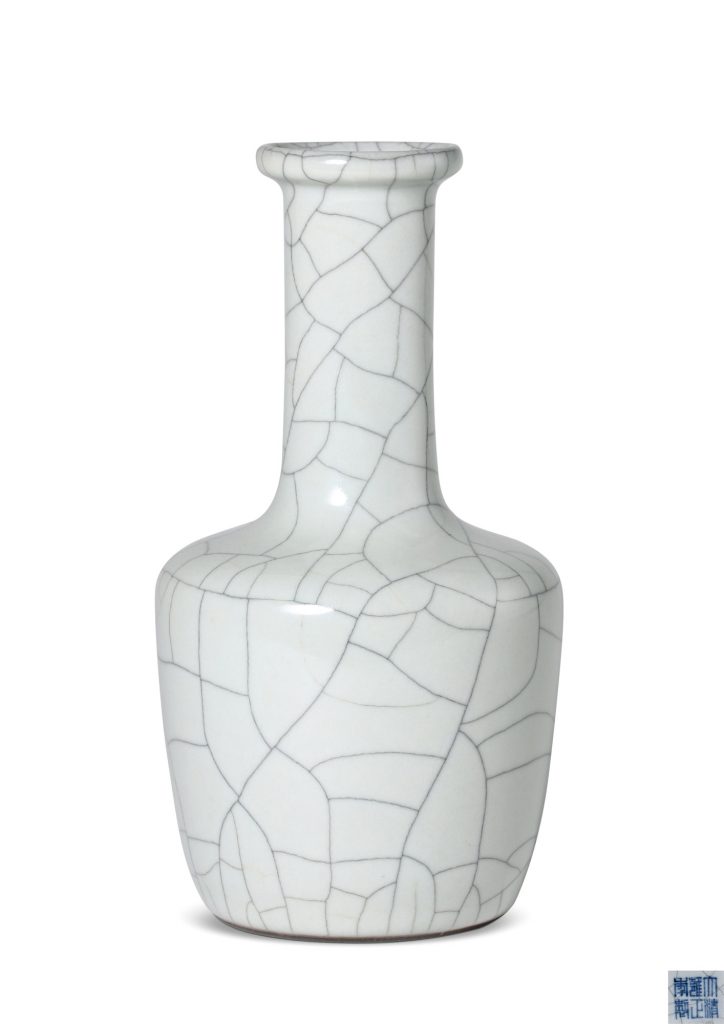
拍卖信息
Lot 0951 清雍正 哥釉纸槌瓶
估价:4,800,000-6,800,000 RMB
暂无数据
尺寸: 高16.5cm
拍品说明:
出版《玫茵堂中国陶瓷》,康蕊君,伦敦,1994-2010年,卷四,编号1793 「大清雍正年制」六字三行篆书款 来源Ralph M.Chait Galleries旧藏;香港苏富比,2011年10月5日,Lot.1《玫茵堂中国陶瓷》,康蕊君,伦敦,1994-2010年,卷四,编号1793忆 古纸槌瓶瓶形由来已久,最早可追溯到西元九至十世纪。台北故宫博物院瓷器部部长蔡玫芬于1966年所著《论「定州百瓷器有芝不堪用」句的真确及十二世纪官方瓷器之诸问题》一文中提出推测:纸槌瓶的原型为当时伊朗及埃及的玻璃工艺,其流行于九到十二世纪间。关于此类瓶器的用途,Stefano Carboni猜测为伊朗泥沙布林特的装油或盛酒器,而也有学者认为其与宋代宫廷使用西亚贡入蔷薇水的传统密不可分。《铁围山丛谈》记载:「政和四年……并奉承俱入内藏库……大食国蔷薇水虽贮于玻璃缶中,蜡密封其外,然香犹透彻……洒着人衣袂,经十数日不歇也。」《宋史·大食传》记:「来献蔷薇水二十琉璃瓶」,玻璃纸槌瓶极有可能为诸记载中所言琉璃瓶之一。此外,北宋初年东南亚沉船出土了不少纸槌瓶残器,故猜测海运应为纸槌瓶传入东亚的管道之一。而从中国境内出土的器物可辨,玻璃纸槌瓶最晚于十一世纪初便已进入辽国境内。北宋后琉璃纸槌瓶逐渐被取型用于瓷器烧制,而以瓷器仿制玻璃器的记载可见于《新校本北史·列传》卷九十:「何稠字桂林,……善琢玉。稠年十余……博览古图,多识旧物……时中国久绝琉璃作,匠人无敢错意,稠以绿瓷为之,与真不异。」自此,纸槌瓶成为一种仿西亚玻璃器而来的中国器物类型。迄今为止发现最早的陶瓷纸槌瓶为北宋汝窑所出,台北国立故宫博物院即藏两件个中精品——北宋汝窑青釉纸槌瓶和北宋汝窑青釉奉华纸槌瓶。其形制类似,皆圆口微侈,细长颈,斜宽肩,上丰下敛腹,卧足。薄胎上满施淡灰蓝色釉,釉薄处可见香灰色胎,底部更刻有乾隆御制诗,以证此器流传至清益得珍爱。时至元明,对纸槌瓶的摹制与烧造依旧,而其也由最初的盛装器逐渐演化为花事用具,文人气息渐浓。此举亦可见于诸文献,明代高濂于《瓶花三说》中记载:「(书斋插花)瓶宜短小,以官哥胆瓶、纸槌瓶、鹅颈瓶……具可插花。」明代学者张谦德也在《瓶花谱》中提到纸槌瓶可用于书房中插花,为书室妙品。清帝好古之风尤盛,其中属雍正时期摹烧最得宋器遗韵,不事雕琢,素净逸然,一如拍品所呈,文雅安宁。胤禛对瓷器造型、图案、色彩各方面要求都很高,所有御制瓷器须经御制图样和御批审定方可烧造,最直接的就是要求器出有样,所谓「内廷恭造式样」,拿古器实物作参照样本,这在《养心殿造办处各作成做活计清档》中有多处记载。而唐英成书于雍正十三年的《陶成纪事碑》中所列的五十七种岁例贡御釉水,大凡仿古种类,都特加注明「仿内发宋器色泽」、「仿内发旧器」等。如仿哥釉一条,「一仿铁骨哥釉,有米色、粉青二种,俱仿内发旧器色泽」。至乾隆时期,纸槌瓶之仿烧与装饰则更具本朝特色,如以画珐琅工艺装饰,又如仿明代形制并放大尺寸等,相关烧造记录可在清档中窥得一二:「乾隆三年六月二十五日:七品首领萨木哈,催总白世秀来说太监高玉交:……哥釉收小八方双管瓶一件,哥釉四喜瓶一件,哥釉太极纸槌瓶一件……传旨:交与烧造磁器处唐英,……俱照样烧造送来。烧造完时再将交出原磁器缴回,仍交磁器库。此磁器内有大器皿应画样带去,其小磁器皿俱各带。钦此」又如「乾隆四十年十一月二十八日,太监胡世杰交玻璃胎画珐琅西番(花)渣斗一件……玻璃胎画珐琅喜相逢诗意纸槌瓶一件……传旨:俱配楠木匣盛装,盖上刻字。钦此。」以及(乾隆三年)「六月二十五日七品首领萨木哈,催总白世秀来说太监高玉交宣窑青花有耳盖碗一件……宣窑青花放大纸槌瓶一件……」代代相传,冉冉化裁,纸槌瓶跨越宋、元、明、清,如文人衣袂飘香,款款而来。视 今拍品形制、釉色均仿自宋瓷,形制与台北故宫博物院所藏两件极为相似,盘口,直颈,折肩,直腹下微敛,式样雅致,颇具古风。通体施仿哥釉,其上「金丝铁线」古意盎然,韵致非凡。唐英《陶成纪事碑记》中所载「一仿铁骨哥釉,有米色、粉青两种。俱仿内发旧器色泽」,其中「铁骨哥釉」即为此例。不施复杂曲折的设计,简约质朴中透着「静为依归」的寂寥。底落「大清雍正年制」六字三行篆书款,更添意蕴。此瓶为The Ralph M. Chait Galleries旧藏,美国纽约一家由家族经营的艺廊,专营中国古董艺术品,由Ralph M. Chait于1909年创建,目前该店为其子Allan Chait掌管,其客户面极广,包括艺术家、政治人物、学者、不乏收藏界知名人士,诸如爱德华·索南斯肯、耶鲁·尼兰,之后又增加到总统赫伯特·胡佛在内的政商名流。此后该瓶由玫茵堂递藏,著录 于《玫茵堂中国陶瓷》卷四中。玫茵堂始于20世纪50年代中期,被誉为「当今最重要的古董收藏之一」,其收藏是瑞士Stephen Zuellig与其弟Gilbert两人60年的珍藏,玫茵堂之名是该兄弟瑞士家乡Meienberg的谐音,其意为「玫瑰花丛中的殿堂」,其收藏注重作品的珍稀程度、纹饰的品质以及作品的品相,所藏古董器物上至新石器时代,下迄清代,珍品繁多。纵观拍场,2008年香港苏富比曾以6752万港币拍出一件南宋官窑粉青釉纸槌瓶,与本品形制亦相类,其延续北宋纸槌瓶之形,为当时官窑之中独树一帜的存在。底刻「玉津园」以示该器为宋高宗于临安宫之收藏,且为南宋官窑最早期的制器之一。与拍品相比仅尺寸略大,釉色相异,可资比较。此外,2010年香港苏富比「彩华腾瑞——戴润斋清宫御瓷藏珍」专场所拍乾隆御制珐琅彩「祥云瑞蝠」开光式「四季花卉」图纸槌瓶估价6千万港币,终以天价1.4亿港币落槌,实为拍场上清代纸槌瓶之佼佼者。该器一改纸槌瓶传统的直腹,代之以饱满的鼓腹,外壁以珐琅彩纹饰满布,足见当朝审美特征与创新意识。历朝争相传颂,拍场高价屡现,纸槌瓶以其简约而具意味之美为世人视作瑰宝,以美为名,传承延续。
参考:保利厦门2018春季拍卖会
玄览—重要古董器物专场
清乾隆 仿官釉三羊尊
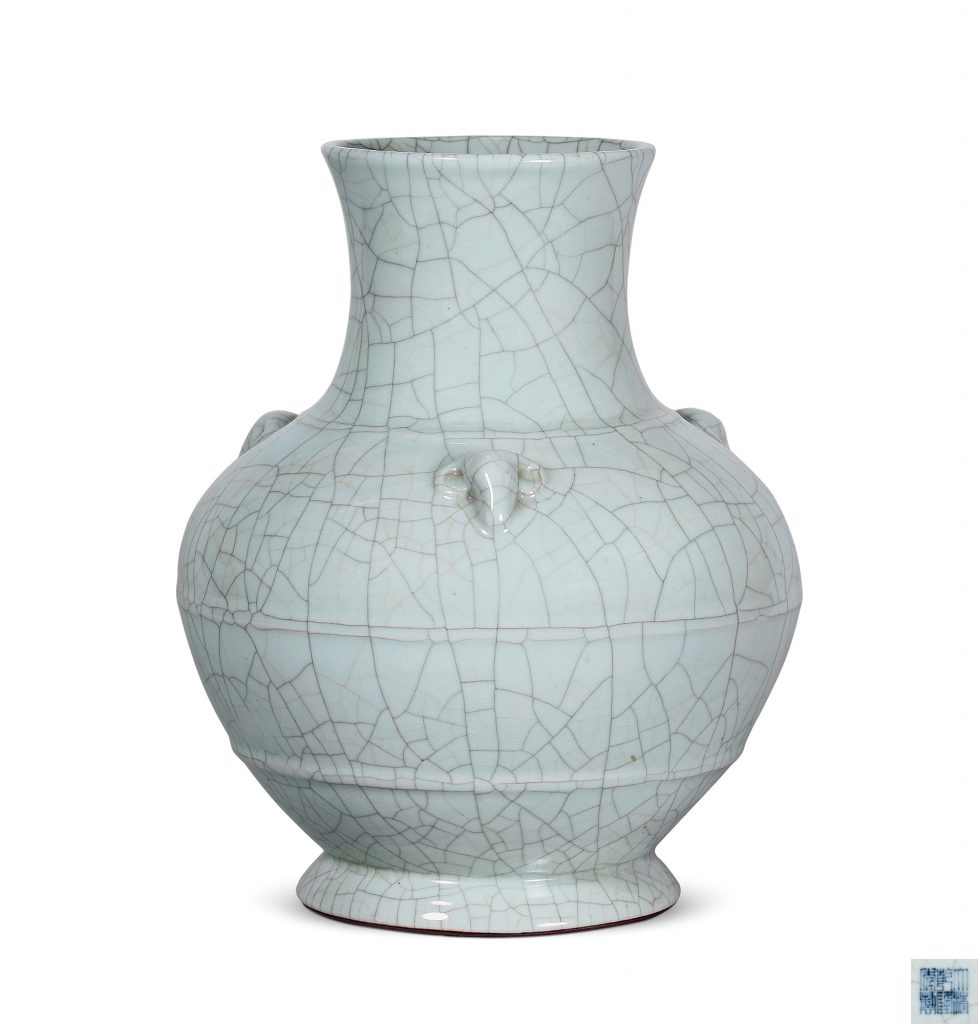
拍卖信息
Lot 0922 清乾隆 仿官釉三羊尊
估价:1,200,000-1,800,000 RMB
暂无数据
尺寸:高29.5cm
拍品说明:
「大清乾隆年制」六字三行篆书款 拍品撇口,束颈,丰肩,鼓腹,圈足外撇。颈部和腹部三组凸起的双弦纹装饰,肩部饰三羊首,寓含三羊启泰之意。通体施仿官釉,上布大小开片,釉面莹润,细腻凝厚。底落「大清乾隆年制」六字三行篆书款,工整古雅。三羊尊摹自周汉铜壶,为雍正后期御窑厂的创新隽品,乾隆初年御窑单色釉瓷器承前朝遗绪,成就斐然,代表乾隆时期单色釉最佳品质,本品是为一例,无论器形、胎釉均与雍正者无异。其造型古朴典雅,釉色静穆温润,肩部饰三羊首,既具古韵,又添新意,寓含三羊启泰之义。颈腹之际各饰双道凸弦纹共三组,令造型富见线条之变化。三羊开泰,因古时「羊」、「阳」通假,亦称「三阳开泰」。《易经》中称∶「十月为坤卦,纯阴之象。十一月为复卦,一阳生于下。十二月为临卦,二阳在下。下月为泰卦,三阳大下。」其意为冬去春来,阴消阳长,万物复苏,因此三阳开泰有吉祥之象。此外,中国宗法社会亦有「君为阳」,「父为阳」的思想,故此纹饰在清代受到皇家大力推崇,而成为官窑瓷器的经典纹样。三羊尊以其古雅敦实的造型深得乾隆皇帝所爱,据乾隆三年六月二十五日《造办处活计清档》记载,乾隆皇帝曾下发「厂官釉三羊尊」让唐英「俱照样烧造送来」,此处所言「厂官釉三羊尊」应是雍正朝之御物,可知雍干二朝均烧造厂官釉的三羊尊。同时乾隆皇帝还将其它色釉装饰三羊尊,文献所知例如《陶雅》「干隆冬青窑变各瓶,有匀配三羊头于肩际者」的记述则表明在晚清时期至少见有冬青釉和窑变釉二种流传于世,目前所见实物除仿官釉之外尚有仿哥釉、窑变釉,见香港钟氏怀海堂之典藏。纵观雍干二朝御瓷之烧造实况,此一器多釉的烧造模式非常流行,往往表明君王对某类器形怀有独特的钟爱。本品隽雅古典,是为唐英榷陶之下的乾隆早期御窑之佳器,至为难得。北京故宫博物院藏一例仿汝釉三羊尊,著录 于《故宫博物院藏清代御窑瓷器》卷一下册,紫禁城出版社,2005年,页379,图175,可资比较。参阅:北京保利,2010年12月5日,编号4694;香港苏富比,2009年10月8日,编号1632;《宫廷珍藏:中国清代官窑瓷器》,上海文化出版社,2003年,330页;《故宫博物院藏清代御窑瓷器》卷一下册,紫禁城出版社,2005年,页378、379,图175;《西藏博物馆藏明清瓷器精品》,中国大百科全书出版社,2004年,页144、145来源东京美术俱乐部;丸ヱ大野商店旧藏
参考:保利厦门2017秋季拍卖会
玄览—重要古董器物专场
清雍正 仿官釉铺首尊
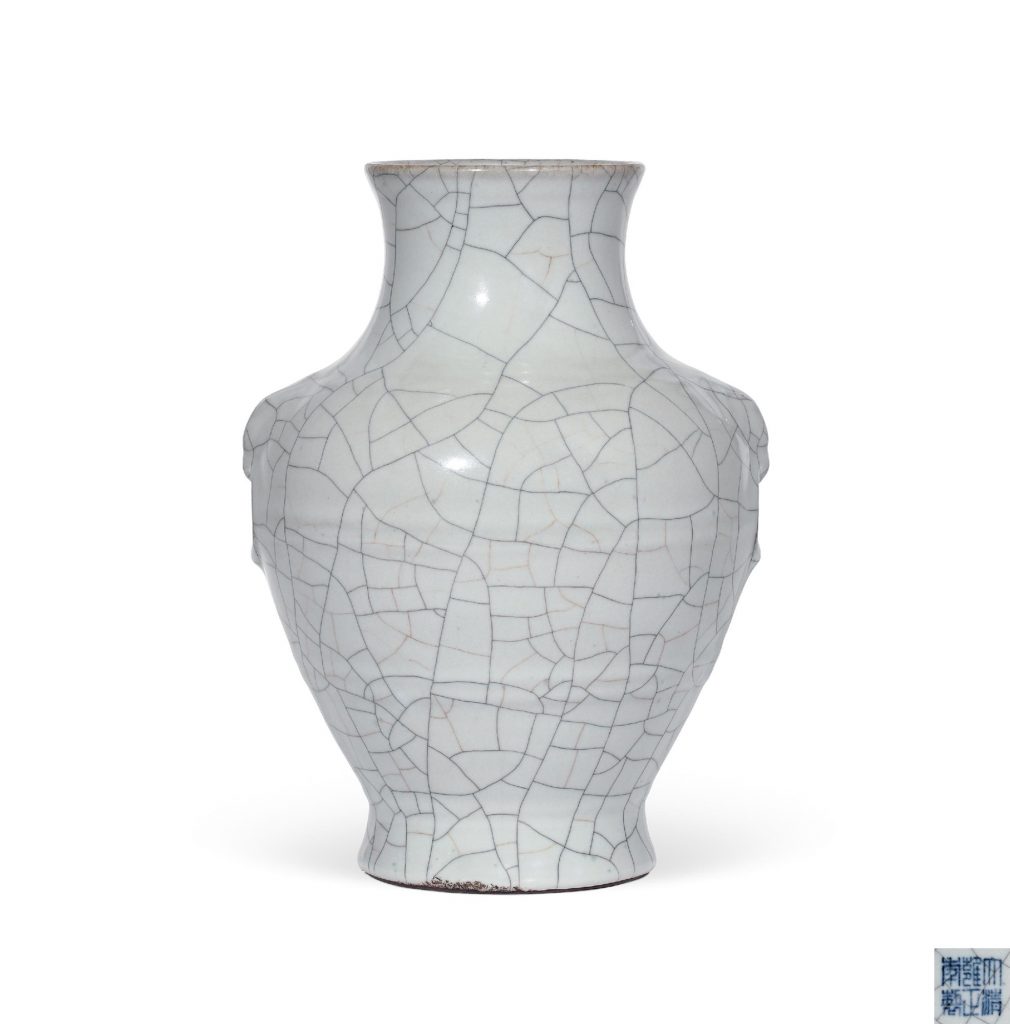
拍卖信息
Lot 0910 清雍正 仿官釉铺首尊
估价:1,200,000-1,800,000 RMB
撤拍
尺寸:高25.5cm
拍品说明:
「大清雍正年制」六字三行篆书款 雍乾二帝尤慕古风,富于文人趣味,尤其是对宋器颇为钟情,以宋人审美为自身品味追求的标准。宋官窑为宋器之精粹,千百年来以古朴典雅之气质折服无数钦慕者,为文人雅士首推之佳器,明张谦德《瓶花谱》中赞曰:「尚古莫如铜器,窑则柴、汝最贵而世绝无之,官、哥、宣、定为当今第一珍品。」故雍乾御窑对摹造官窑瓷器尤为重视,由《陶成纪事碑记》中可见一斑。雍正十三年乙卯冬月,唐英总结雍正一朝瓷业成就所作的《陶成纪事碑》将仿官釉置于五十七种重要供御瓷器品类之首,可见宫廷上下对其之厚爱与尊崇。本品正是此番摹古热潮下的杰出代表,成功地以后仿之器诠释宋人崇尚一色纯净之美学理念。其造型仿西周青铜器,制作规范,古朴凝重,腹部两侧有铺首一对,庄重大气,古风荡荡,器身凸起两道弦纹,平添动感。通体施青灰仿官釉,釉水凝润,金丝开片遍布器身,疏朗有致,气势非凡,虽曰人工,宛若天成,宋人意趣,尽在其中,与清代古瓷鉴定家蓝浦所云「古哥窑器好者类官,亦号百圾碎」(载《景德镇陶录》)正相符。圈足涂饰铁褐之色,底内施釉,书「大清雍正年制」青花六字篆书款,篆法精到,端庄规整。参阅:《怀海堂藏清代御窑瓷器》香港中文大学文物馆 2007年11月 P177来源香港佳士得,2003年10月27日,Lot.706香港苏富比,2011年10月5日,Lot.1987
参考:保利厦门2017秋季拍卖会
玄览—重要古董器物专场
清乾隆 哥釉弦纹梅瓶
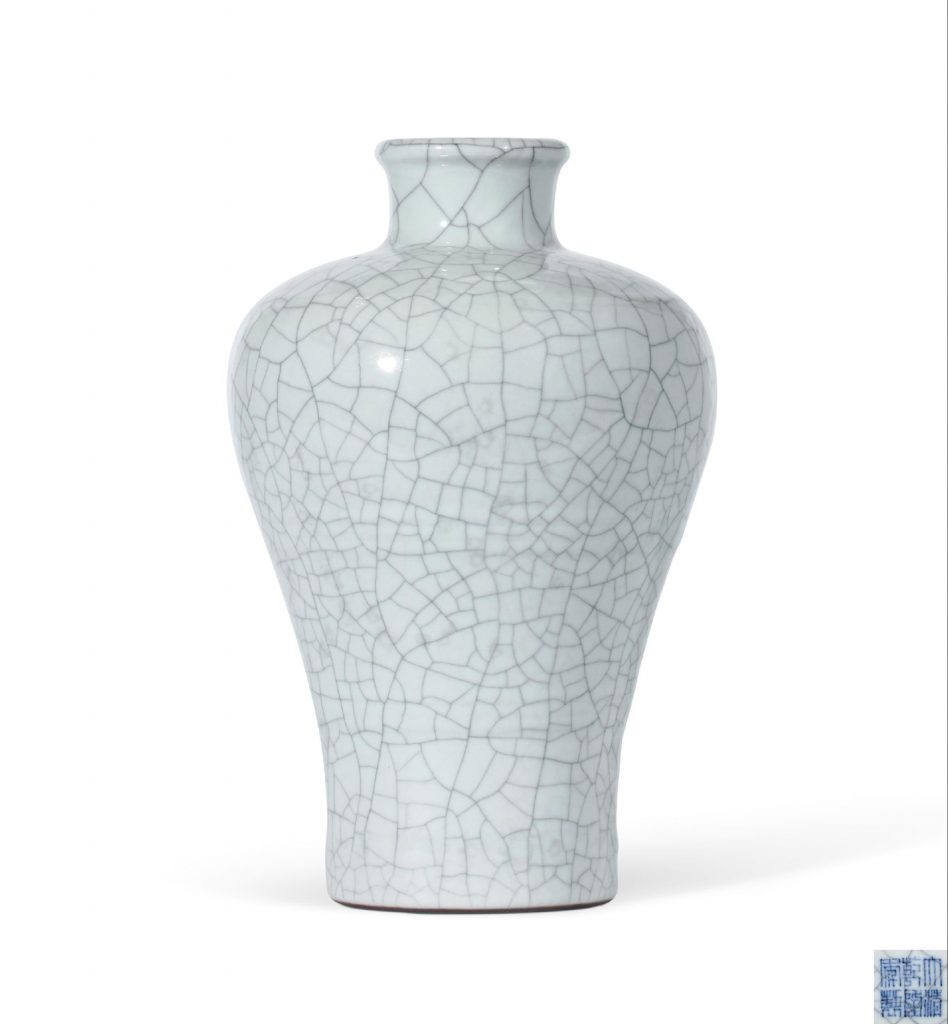
估价:500,000-700,000 RMB
成交价: 1,495,000 RMB (含买家佣金)
尺寸:高22cm
拍品说明:
「大清乾隆年制」六字三行篆书款 梅瓶器形小巧,古雅隽美。瓶唇口,短颈,丰肩,圆腹下敛,圈足,通体施仿哥釉,釉质肥厚滋润,釉面开有金丝铁线,纵横交错敦实厚重,器身起弦纹九道,平均饰于肩部、腹部与胫部,掩于厚釉之下,更显雅致之姿。底部落「大清乾隆年制」六字篆书款。弦纹装饰最早出现在汉代器物上,从宋代始,弦纹装饰开始融入瓷器造型,清代雍正乾隆两朝皇帝追慕宋瓷之雅,下旨烧造了大量以宋代瓷器器形、釉色为原型并加以创新的品种,弦纹成为此类仿宋瓷器的重要装饰元素。故宫博物院藏清乾隆仿官釉三羊梅瓶与本拍品器形相近,惟肩部不饰三羊;其颈部较高,不同于常见的乾隆朝梅瓶,而与雍正时期弦纹三系瓶相似,当由此一品种变化而来。雍正帝对于宋代五大名窑瓷器情有独锺,在位十三年中烧制了大量水平极高的仿古瓷器,而在各式仿古单色釉之中,哥釉的烧造数量仅次于官釉。乾隆皇帝在《清高宗御制诗集》一百九十九首咏陶诗中,赞咏哥窑就有二十首。乾隆十二年以前内务府造办处活记档中,有多处烧造哥釉器的记载,其质量丝毫不逊前朝。许之衡《饮流斋说瓷》记有哥窑「器小而开大片,器大而开小片,皆足贵也。」其胎色有黑、深灰、浅灰及土黄多种,其釉均为失透的乳浊釉,釉色以灰青为主。常见器物有炉、瓶、碗、盘、洗等,均质地优良,做工精细,全为宫廷用瓷的式样,与民窑瓷器大相径庭。传世哥窑瓷器不见于宋墓出土,其窑址也未发现,故研究者普遍认为传世哥窑属于宋代官办瓷窑。旧有「千金易得,宋瓷难求」之说,形容宋瓷的珍贵,故后世多有仿制,明代宣德时期,景德镇开始仿哥釉瓷,一直延续到清代晚期都有烧制,以清代雍正、乾隆的仿哥窑艺术成就最高。雍乾二帝除了对仿古釉色的喜爱之外,皆有插花雅好。因其哥釉器端庄的器形,淡雅的釉色,为衬托娇艳鲜花的绝佳容器,雍乾时期幅画作中可看到以梅瓶插花的例子,如《故宫博物院藏文物珍品大系—清代宫廷绘画》。郎世宁所绘《午瑞图轴》中亦有类似品种,然传世所见较少,尤显难得。参阅:诚轩,2016年11月12日,Lot.848《故宫博物院藏文物珍品大系—颜色釉》,商务印书馆(香港)有限公司、上海科学技术出版社,1999年,页230,图208《故宫博物院藏清代御窑瓷器》卷一下册,紫禁城出版社,2005年,页336、337,图154来源北京匡时,2006年11月23日,Lot.1529
参考:六合和熙-重要私人珍藏
105 南宋至元 官窰海棠式花盆
估價 15,000,000 — 20,000,000 港幣
拍品已售 38,514,000 港幣 成交價 (含買家佣金)
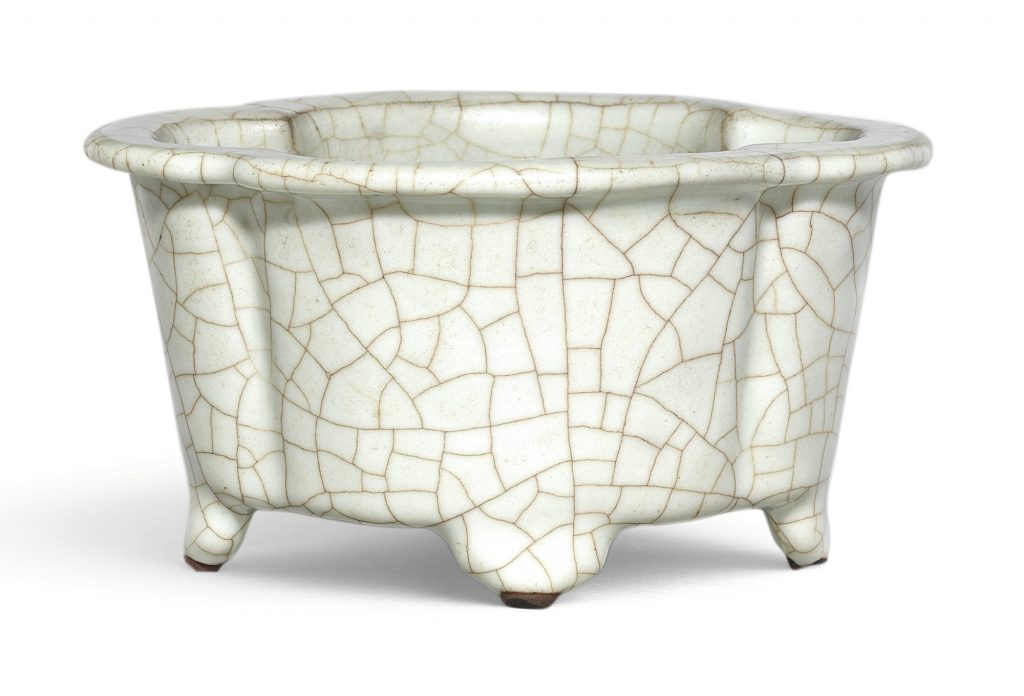
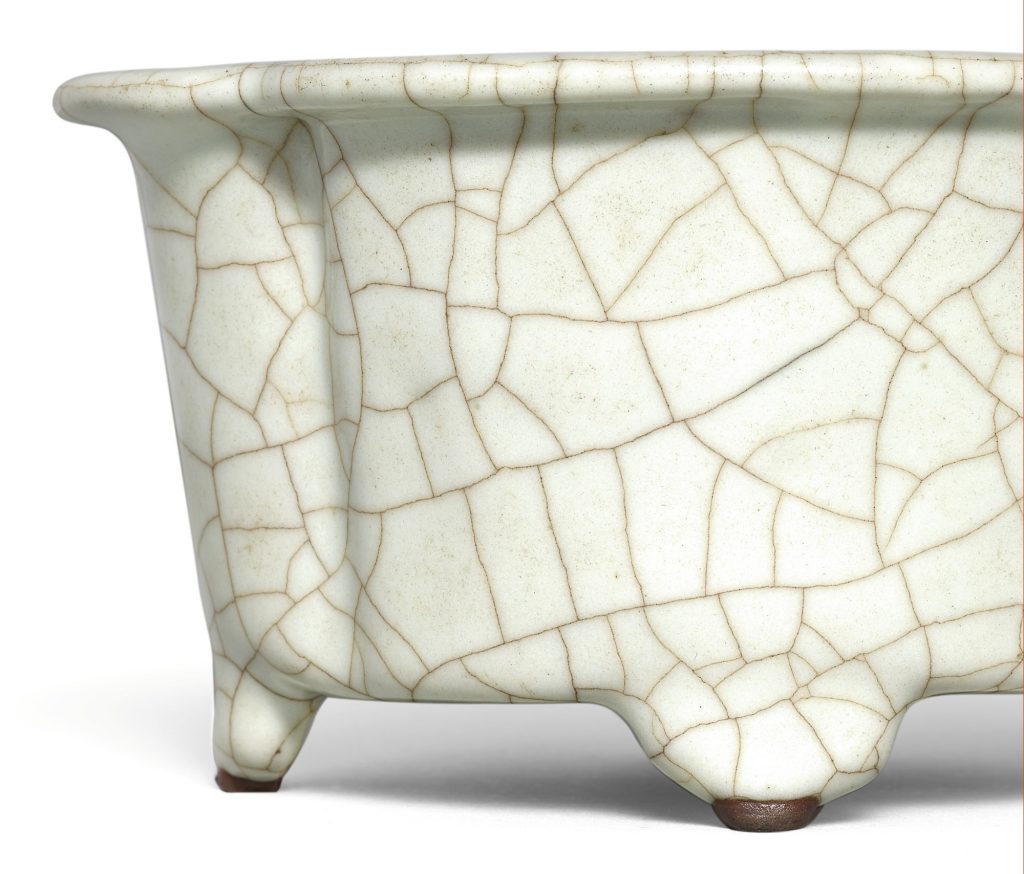
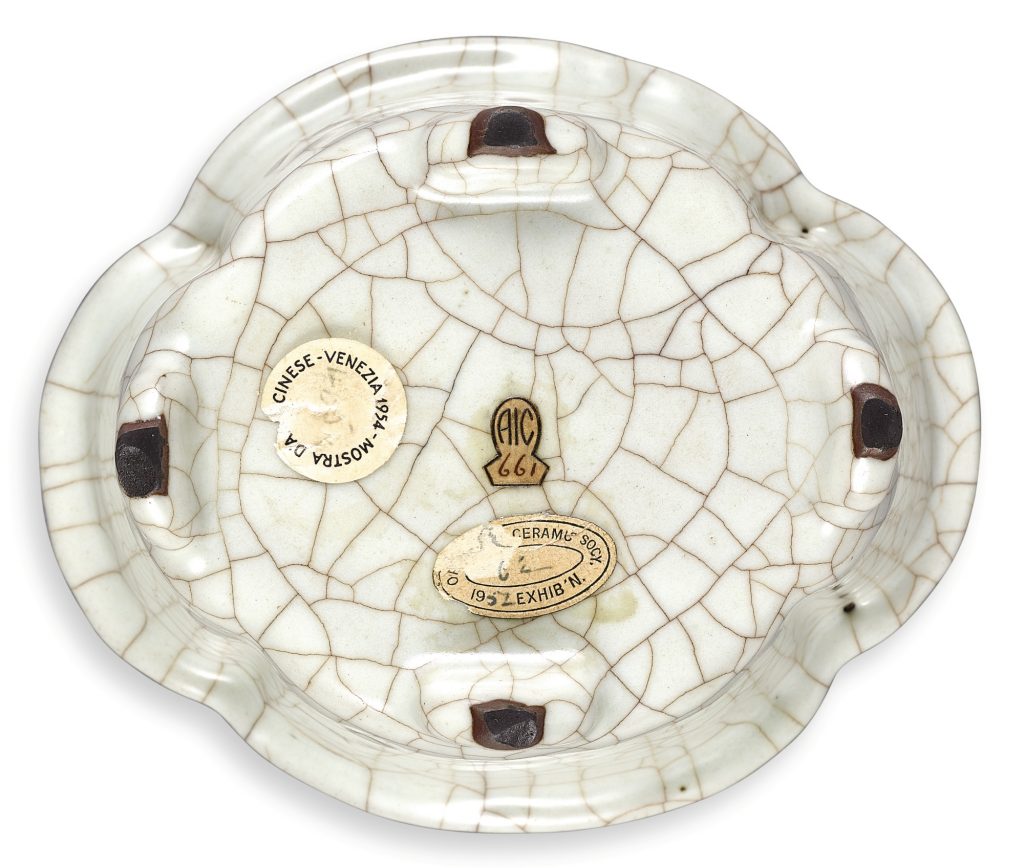
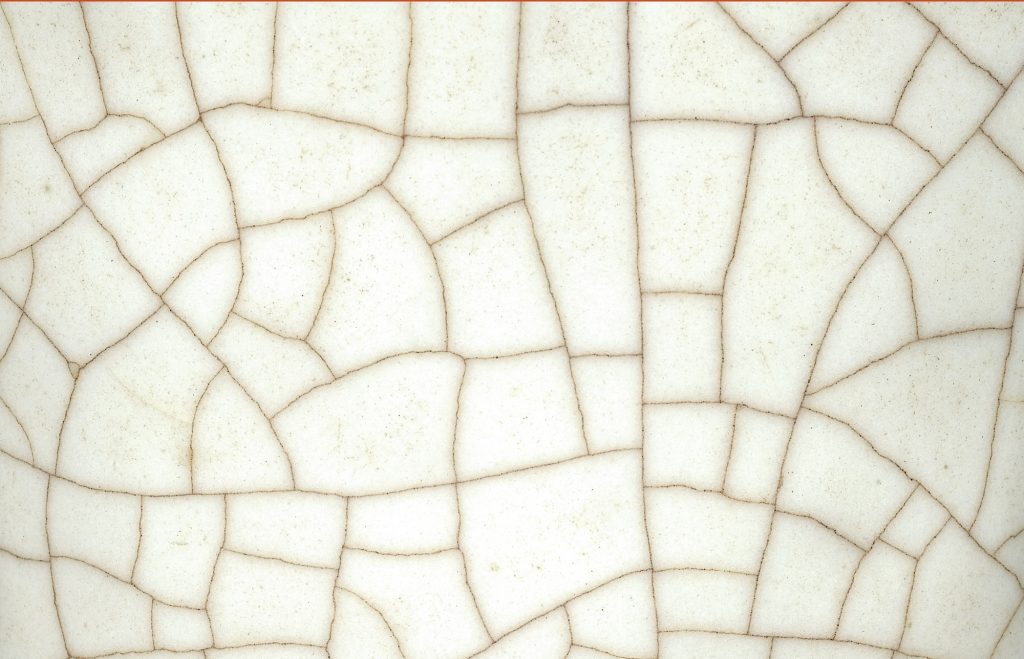
南宋至元 官窰海棠式花盆
15 公分,5 7/8 英寸
來源
艾弗瑞.克拉克夫人(1890-1976年)收藏,編號661
Dr Lin 收藏,售於倫敦蘇富比1975年3月25日,編號102
2003年購自坂本五郎(1923-2016年)
展覽
《Exhibition of Chinese Art for Chinese Medical Relief》,倫敦,1938年(標籤)
《The Oriental Ceramic Society Exhibition of Ju and Kuan Wares: Imperial Wares of the Sung Dynasty, Related Wares and Derivatives of Later Date》,倫敦,1952年,編號62
《Mostra d’Arte Cinese》,多奇宮,威尼斯,1954年,編號465
出版
大維德爵士,《Chinese Connoisseurship: The Ko Ku Yao Lun. The Essential Criteria of Antiquities》,紐約,1971年,圖版22d
相關資料
寥若晨星:官窰海棠式盆
薛好佩博士
此官窰海棠式盆素淨端麗,其釉色青灰,瑩澈溫潤,片紋層疊,疏密有致,製於南宋至元朝年間(十二至十三世紀),為中華瓷海之明珠,熠熠生輝,甚為後世所珍。本品釉厚若堆脂,觸之凝滑如絲,觀之賞心悅目。將其置於放大鏡下,可見釉層滿佈氣泡,細入毫芒,古稱「聚沬攢珠」。氣泡經散射而晶亮通透,使器表隱現酥光寶暈,宛若和田美玉。釉上又以開裂綴襯,素有「金絲鐵線」之述。此般開片雖因窰溫差異自然形成,然瓷匠為求佳器,於施釉、柴燒工序間之往復探求及摸索,自不必多言。官窰胎土色深,於底足及器心支釘痕露胚處可窺一二,蓋因富鐵元素所致。故而,清時景德鎮窰工仿官,先於白胎上罩醬色化妝土,而後施釉,以擬「紫口鐵足」之視效。本器採四瓣花口,雅雋倩秀,恰似垂絲海棠悄然盛開,故以「海棠」命名。海棠葳蕤,白中透粉,甚適於心,又「堂」指家室,與「棠」同音,故海棠被賦予「富貴滿堂」之吉祥寓意而多應用於器,本例便如是。取形海棠,或另暗示其為院庭花器;宋人風雅,時興置盆景(日本稱盆栽)於案之藝事,此器盈盈可握,嬌小玲瓏,亦或正是製作盆景之嘉材。有關盆景及其歷史之詳盡論述,可參考本場拍品編號104。
官釉佳瓷窰火天成,雖世間難覓全然相同之器,然與本品造型相仿者有二,其一現存北京故宮博物院,稱為「修內司窰海棠式花盆」,圖刊於李炳輝編,《宋代官窰瓷器》,北京,2013年,圖版53(圖一);其二貯台北故宮博物院,收入該院展覽《貴似晨星—清宮傳世十二至十四世紀青瓷特展》,台北,2016年,編號IV-11(圖二),據院內學者研究,其乃南宋至元製品,模印成形,支釘墊燒。江西省樟樹市劉公廟鎮南宋開禧元年墓(1205年)出土一相類官釉海棠式盆(圖三),據其可推,前述三例之燒成年代可上溯至十三世紀初。此書同錄一青釉海棠式花盆(編號IV-12),體量稍大,口沿嵌銅扣,底承四足。台北故宮專家比較本院館藏元代鈞窰器,發現相同器型之海棠式盆亦在元鈞之列,故為其斷代提供依據(下文詳述)。
南宋官窰歷來彌足珍罕,乾隆帝曾賦詩嘆慨,憾之存世甚微,還著人將其所作詩文刻於清宮典藏之官窰器底部,此器保留至今,現存倫敦大英博物館。全詩如下:
官窰名始宋南渡,後苑製效政和故;成章提擧惟御用,臣庶弗敢過而顧。
即今六百有餘載,晨星一二猶或遇;鬻從市廟供人玩,誰誠當年法令固。
不啻斯矣堪慨歎,即是殷周相鑒處。
乾隆丁酉春御題。1
高宗在詩中把後苑用瓷歸入修內司窰瓷之列。修內司為南宋官署名,執掌宮殿修繕事宜,其於京都臨安(今浙江杭州)按舊制開設窰場,專燒御品以供宮廷,史稱修內司窰,位於現今老虎洞窰址。靖康二年(1127年)金人揮兵南下,攻陷汴梁,宋室倉皇南渡,建新都於臨安。南宋百廢待興,故承北宋御窰舊制,燒造「新」官以為用。南宋文人葉寘《坦齋筆衡》詳錄之本朝官窰創燒始末,或為最早之相關論述:
京師自置窰燒造,名曰官窰。中興渡江,有邵成章提舉後苑,號邵局,襲故京遺制,置窰於修內司,造青器名內窰,澄泥為範,極其精緻,釉色瑩徹,為世所珍。後郊壇下別立新窰,比舊窰大不侔矣。2
葉氏有關修內司官窰之論述,多為後世因襲,乾隆皇帝之御題,亦參其所言也未可知。邵成章乃宋高宗時內侍省掌事太監,主持修內司窰務,督造御瓷,專供宮廷。此外,「澄泥為範,極其精緻,釉色澄徹,為世所珍」十六字乃讚官窰質美之經典,可曉其為仿北宋官汝而生,卻仍秀逸絕世,甚得上心。除卻修內司窰,葉氏所載郊壇下窰,亦於臨安城內,所出與修內司窰相若,然質稍遜。近期考古資料證實,南宋臨安城內確存官窰遺址二處,分別為皇城南側之烏龜山,以及皇城北牆內之老虎洞(前文已述)。依其窰址分佈及所產瓷片質量,可斷前者當為郊壇下窰舊址,而後者側屬修內司。
河南禹州鈞窰(也稱鈞台窰)多燒海棠式盆,與本品器形相似,享負盛名。這類器底刻有數字之鈞瓷花盆,釉質及發色與宋鈞相類,然造型精絕獨到,多為花口,美艷俊秀,加上數字款識,尤為特別。北京故宮藏「七」字款及「四」字款鈞釉海棠式花盆,可資比較,圖見《鈞窰雅集-故宮博物院珍藏及出土鈞窰瓷器薈萃》,北京,2013年,圖版63、64。大維德爵士於1952年東方陶瓷學會展覽介紹中,提及此官窰花盆時,指相較而言,鈞窰海棠式花盆及配套盆奩之存世量頗豐,弗利爾美術館所藏鈞瓷便為當中佳例。
此件官窰花盆來源顯赫,不但屬皇家御用之器,並經艾弗瑞.克拉克夫人及坂本五郎二位名家遞藏,非同凡品。艾弗瑞.克拉克為英籍美國人,乃當時唱片及影視業先驅,身居HMV及百代唱片公司要職。夫婦二人致力蒐集中國藝術瑰寶,均是東方陶瓷學會成員,並於1934-48年間擔任學會顧問,乃二十世紀初西方收藏界之翹楚。克拉克夫婦為協籌展覽,多次慷慨借出所藏珍品,如倫敦皇家藝術學院1935-36年中國藝術品展,及1952年東方陶瓷學會中國瓷器展。經大維德爵士夫人回憶,克拉克伉儷賞瓷「品味高遠、精湛」,其以陶瓷點裝居室,終日與藝為陪,於小閣樓擺放宋瓷,情趣純雅,不落俗套。日本收藏家、鑑賞家及著名骨蕫商坂本五郎先生,也是世界中國藝術品收藏之傳奇。先生藝涯橫跨近七十載,廣知博見,使其獨具慧眼,明辨善鑑,聞說能與物相通,可望其氣息,堪為業界權威,享譽國際。
1 見大英博物館網站:https://www.britishmuseum.org/research/collection_online/collection_object_details.aspx?objectId=3180074&partId=1&people=162439&sortBy=imageName&page=1 (登錄日期:2019年3月2日)。
2 《輟耕錄通鑑》,北京,1950年。
3 見中國社會科學院考古所編,《南宋官窰》,北京,1996年;杜正賢編,《杭州老虎洞窰址瓷器精選》,北京,2002年;以及張振常編,《南宋官窰文集》,北京,2004年。
4 大維德爵士,〈序〉,見《The Oriental Ceramic Society Exhibition of Ju and Kuan Wares: Imperial Wares of the Sung Dynasty, Related Wares and Derivatives of Later Date》,倫敦,1952年,頁4。
5 畢宗陶,《Collectors, Collections and Museums: The Field of Chinese Ceramics in Britain, 1560-1960》,牛津及紐約,2007年,頁171-2。
6 Jeffey Hantover,〈坂本五郎與「目利」之藝〉,《藝海觀濤:坂本五郎珍藏藝術.陶瓷》,2015年3月,頁12。
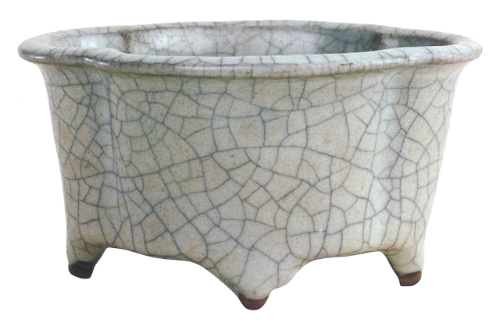
南宋 修內司窰海棠式花盆
© 北京故宮博物院藏品
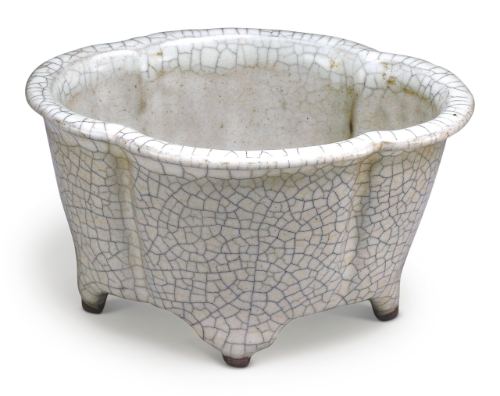
南宋至元 官窰青瓷海棠式花盆
© 台北國立故宮博物院藏品
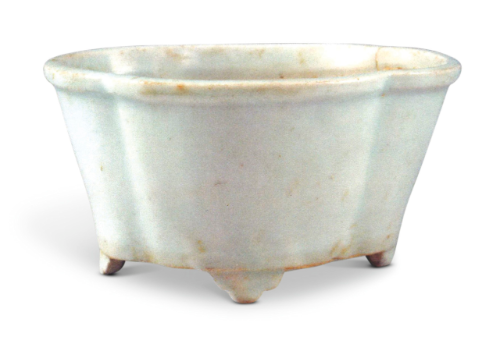
南宋 青白釉海棠式爐 江西省樟樹市劉公廟南宋開禧元年 (1205年)墓出土
圖片鳴謝:樟樹市博物館
参考:六合和熙-重要私人珍藏
104 南宋至元 官窰六方花盆
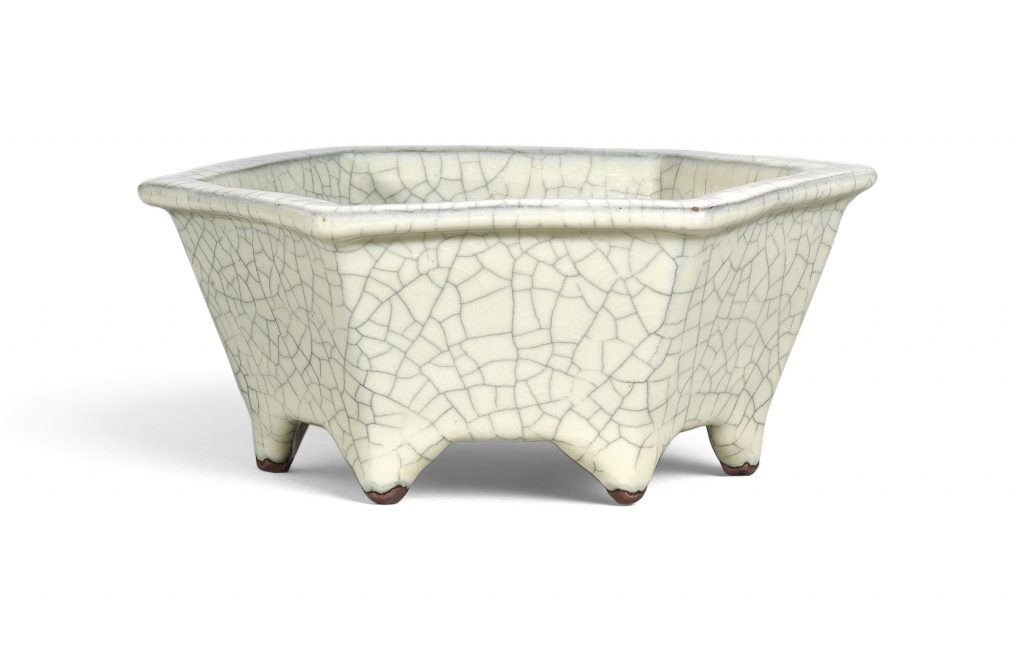
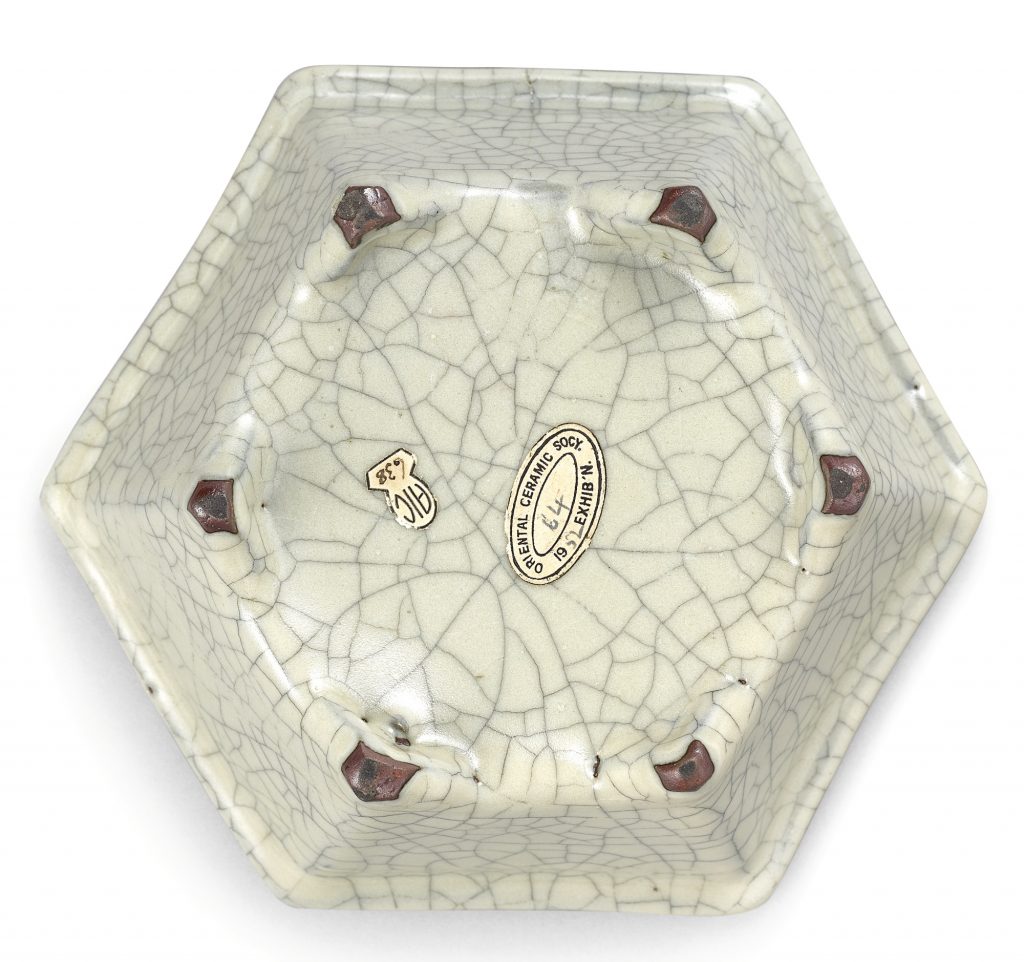
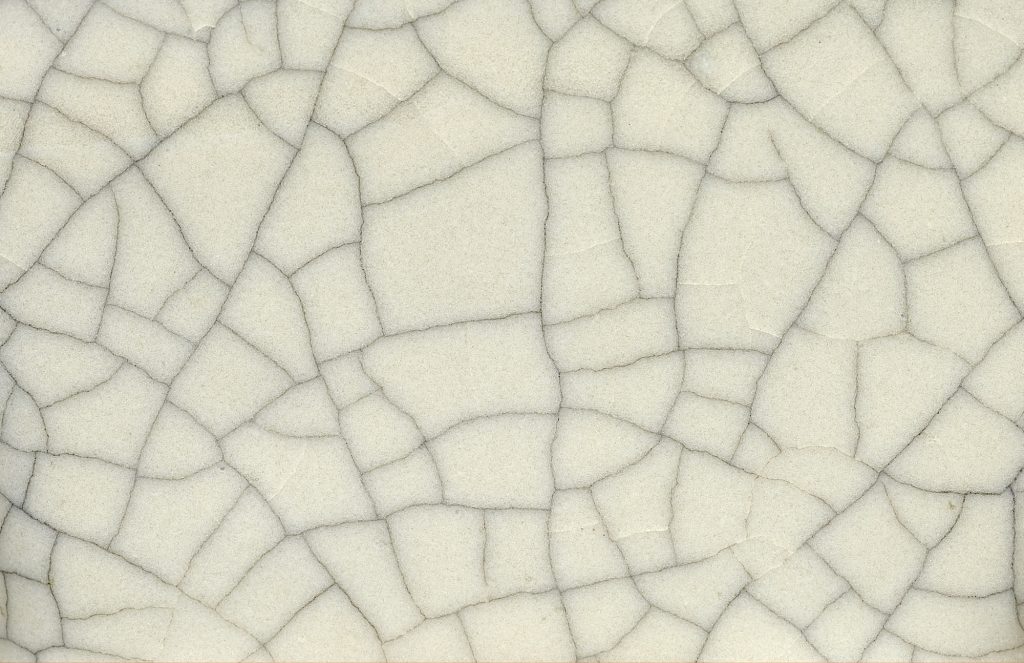
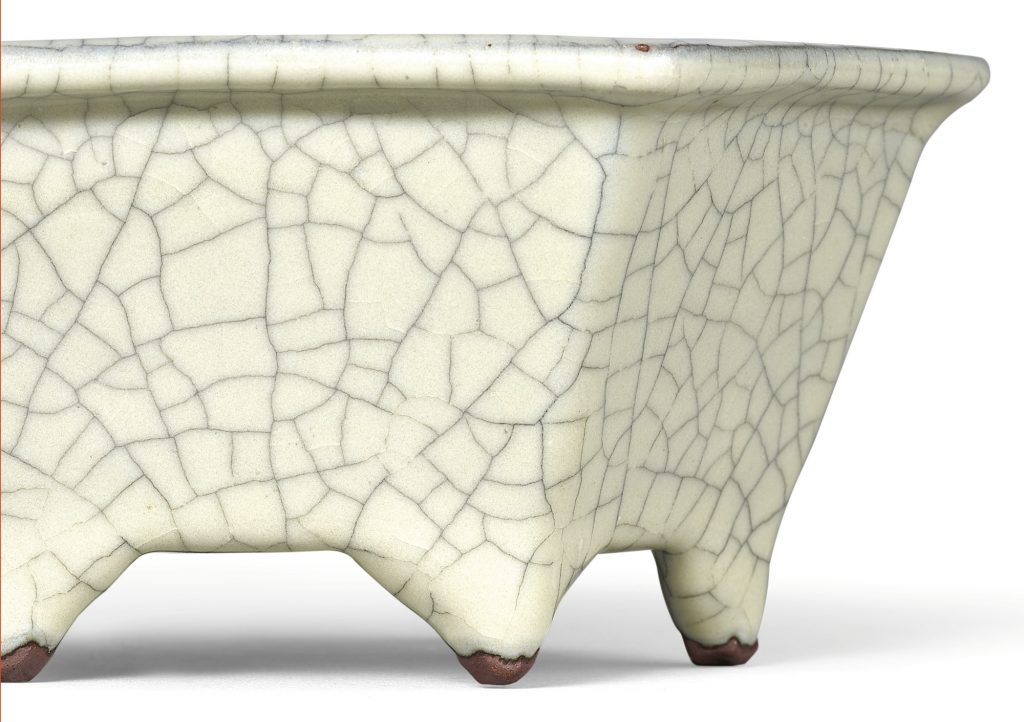
估價 10,000,000 — 15,000,000 港幣
拍品已售 12,175,000 港幣 成交價 (含買家佣金)
南宋至元 官窰六方花盆
16.5 公分,6 1/2 英寸
來源
艾弗瑞.克拉克夫人(1890-1976年)收藏,編號638
倫敦蘇富比1975年3月25日,編號112
2003年購自坂本五郎(1923-2016年)
展覽
《The Oriental Ceramic Society Exhibition of Ju and Kuan Wares: Imperial Wares of the Sung Dynasty, Related Wares and Derivatives of Later Date》,倫敦,1952年,編號64
相關資料
天人共賞:官窰六方小盆
薛好佩博士
此六方小盆所屬之類備受南宋宮廷青睞,殊為珍罕。先見其釉,稠厚緻密,呈淺灰色,亦見其胎,稍露於足,呈黑褐色。側壁平坦微斜,平添趣味,更顯六方形制之雅。此器乃南宋官瓷佳例,釉面瑩滑,片紋端勻,匠心之巧、技藝之高、氣韻之卓,盡覽無遺。
觀其特質,可知此器為修內司所造,浙江杭州市郊老虎洞窰址出。修內司設於南宋皇城內,奉詔燒製官瓷,專供宮廷。1127年,北宋瓦解,皇室自汴州(今開封)南遷,定都杭州,乃開修內司。本圖錄拍品編號105所附文章就修內司及御製官瓷另有詳述。
鑑藏中國瓷器之泰山北斗大維德爵士,寶蓄舉世無雙,現已入藏大英博物館,他對官瓷推崇有加,稱其脩美、稀貴。1952年東方陶瓷學會倫敦辦展,陳列汝、官窰,展覽引言中,大維德爵士曾言及此六方小盆與諸展品:
明末有士論汝、官、哥窰,直抒胸臆云『後此又不知凋謝如何。故餘每得一睹,心目爽朗,神魂為之飛動,頓令腹飽。豈果耽玩痼僻使然?』其後數世紀,此言一語成讖,珍稀之器或損毀或散佚,愈演愈烈。存世之量或已寥寥,時人之心或已不古,然親臨是次展覽者,悅目怡情之餘,不論愛之深淺,亦得感同身受。1
行文中,大維德爵士強調,存世官窰寥若晨星,後人盡為之傾倒。憑藉智識與慧眼,大維德爵士又對此盆深入探討,指出釉、型方面可見宋代陶匠著力仿效,官、鈞花盆之間尤多借鑒(稍後再述)。
此盆形為六方,不甚多見,同類之器多形狀有別,可比一四方官窰盆,尺寸相當,貯北京故宮博物院,刊於《官窰瓷器》,北京,2016年,圖版32(圖一)。著錄、研究故宮院藏花器之學者稱,此類小盆乃貢皇家,以盛「盆景」之用,西方則多依日文「盆栽」一詞。學者又稱,該類官窰小盆初依鈞窰形制,鈞窰小盆存量或略多。2 由此觀之,此類花盆頗受重用,尺寸小於尋常亦有其因。唐高宗(649-683年間在位)第六子章懷太子(654-684年)墓中有一繪於706年之壁畫,畫中一名僕侍,身著宮衣,手捧盆景,盆內盛有山石草木。3
早在唐代,盆景便已發展為高雅藝術,受皇室及文人垂愛。而至宋代,蘇軾(1037-1101年)、陸游(1125-1209年)等文人墨客賦詩以頌盆景之樂,將其拔至新高。陸游有詩,名曰《菖蒲》:
雁山菖蒲崑山石,陳叟持來慰幽寂。
寸根蹙密九節瘦,一拳突兀千金直。
清泉碧缶相發揮,高僧野人動顏色。
盆山蒼然日在眼,此物一來俱掃迹。
根蟠葉茂看愈好,向來恨不相從早。
所嗟我亦飽風霜,養氣無功日衰槁。4
陸游之詩,既詠盆景微縮山水,又言其器功不可沒,讚碧缶釉色青藍,慕盆中景觀蒼然。天作山水與人造盆缶彼此發揮,共得天人合一之境,備受其時雅士稱頌。不難推知,盆景所用之器,或個別燒製,或小批量產,蓋因器型需隨所盛景觀各有變化。
梁悅美撰文探討盆景藝術,指出宋代盆景所用之器多為汝瓷或鈞瓷,且不乏存例,現藏台北故宮博物院。5 比較二件鈞窰六方花盆,帶數字款,錄於《故宮藏瓷大系.鈞窰之部》,台北,1999年,圖版47、48,均刻「七」字及「養心殿明窗用」。明窗位於養心殿東,每逢新歲,皇帝於此處開筆題詞,祈祝吉祥,是為「明窗開筆典」。故知上述二例原奉養心殿明窗,其功用蘊含寓意。
此類鈞窰刻數字款花盆多為模製,底款數字由一至十,各示大小,究其意義,可參考李寶平,〈Numbered Jun Wares: Controversies and New Kiln Site Discoveries〉,《東方陶瓷學會彙刊》,卷71,2006-7年,頁65-77。其文討論此類花盆斷代之爭,觀點分為兩派,一派持北宋末年論,另一派斷代較晚,此六方小盆或與後者更符。然則,此類器之官家背景毋庸置疑。近來,有北京故宮博物院學者印證,將其歸結為「陳設類官鈞」。6 至此,已有研究確認,御用官、鈞花盆皆屬此類。
此官窰小盆出自帝苑,後於上世紀經克拉克夫人(1890-1976年)及坂本五郎(1923-2016年)二位巨擘遞藏。克拉克伉儷所藏中國瓷器在西方久負盛名,二人支持東方陶瓷學會不遺餘力,躬親參與1935至1936年間倫敦中國藝術大展籌備事宜,並借出精品數十件以作展示。1992年,大維德爵士夫人於訪談中被問及先夫最尊何人所藏,夫人答道:「當以克拉克氏所藏為最。」7 日本鑑藏大家兼骨董名商坂本五郎亦為中國藝術品之宗匠,其收藏心血及鑑賞造詣首屈一指。欲知先生生平及風骨,可參閱《Sakamoto Gorō: The Legacy》,倫敦蘇富比,2016年。
1 大維德爵士,〈序〉,《The Oriental Ceramic Society Exhibition of Ju and Kuan Wares: Imperial Wares of the Sung Dynasty, Related Wares and Derivatives of Later Date》,倫敦,1952年,頁2。
2 見《官窰瓷器》,北京,2016年,圖版32。
3 壁畫圖見梁悅美,《The Living Art of Bonsai: Principles and Techniques of Cultivation and Propagation》,紐約,2005年,頁101。普遍認為,此乃最早描繪盆景之壁畫。
4 此詩釋譯參見梁悅美,前述出處,頁102-3。
5 出處同上,頁203。
6 見《鈞窰雅集-故宮博物院珍藏及出土鈞窰磁瓷器薈萃》,故宮博物院,北京,2013年,頁168起。
7 林華田,〈An Interview with Lady David〉,《美成在久》,1992年4月,頁56-63。
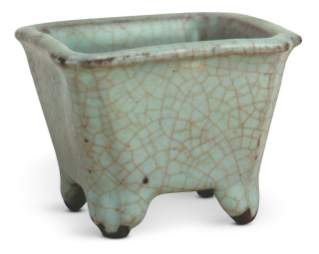
© 北京故宮博物院藏品
参考:CURIOSITY IV
3062 A RARE GUAN VASE
SOUTHERN SONG DYNASTY
Estimate 2,500,000 — 3,000,000 HKD
LOT SOLD. 12,720,000 HKD


A RARE GUAN VASE
SOUTHERN SONG DYNASTY
superbly potted with a pear-shaped body surmounted by a tall tubular neck, all supported on a gently tapered foot, the dark brown body unctuously applied overall save for the unglazed footring with a lustrous glaze of pale greyish-blue tone, the glaze suffused with a network of luminous golden-beige crackles
15.1 cm, 5 7/8 in.
READ CONDITION REPORT
The vase is in very good condition with the exception of a very minute glaze flake (0.1cm) below the rim.
“In response to your inquiry, we are pleased to provide you with a general report of the condition of the property described above. Since we are not professional conservators or restorers, we urge you to consult with a restorer or conservator of your choice who will be better able to provide a detailed, professional report. Prospective buyers should inspect each lot to satisfy themselves as to condition and must understand that any statement made by Sotheby’s is merely a subjective, qualified opinion. Prospective buyers should also refer to any Important Notices regarding this sale, which are printed in the Sale Catalogue.
NOTWITHSTANDING THIS REPORT OR ANY DISCUSSIONS CONCERNING A LOT, ALL LOTS ARE OFFERED AND SOLD AS IS” IN ACCORDANCE WITH THE CONDITIONS OF BUSINESS PRINTED IN THE SALE CATALOGUE.”
PROVENANCE
An English private collection, by repute.
CATALOGUE NOTE
This exquisite vase belongs to one of the most celebrated ceramic wares of China’s history. Crackled guan, the fabled ‘official ware’ specially created for the imperial court of the Southern Song (1127-1279) in Hangzhou, Zhejiang of south China, is perhaps the most desirable and certainly one of the rarest types of Chinese ceramics. Guan wares were made in very small numbers, and the present vase is an extremely rare example. The serenity of its attractive tactile glaze and sophistication of its minimalist form and intimate size are particularly appealing to the eyes and invites being held.
Guan ware was already mentioned and lauded in contemporary texts of the Southern Song period. Yet despite the immense importance of these official ceramics for the history of Chinese ceramics, guan ware is still less well understood than most other ceramics of that period. Among the many reasons for its enigma are their rarity and the fact that every piece is unique, with contemporaneous wares varying immensely.
The unctuous glaze of the present vase with its smooth texture, delicate green tint and subtle sheen, was achieved by gradually applying multiple layers of glaze, which were likely successively fired. The thick coating formed gently embraces the elementary form to create an object that is pleasing and ‘soft’ to the touch. The distinct web of veins of the large-scale crackle was caused by different degrees of shrinkage between the glaze and body material, the product of a well-controlled cooling process after the last firing and subsequent staining. Its earthy quality endows the piece with the impression of being carved from a natural material such as jade. The dark blackish body visible at the foot adds depth to the glaze and gravitas to the whole object while subtly accentuating the shape.
Guan vases of this restrained form are rare and only one closely related example appears to have been published, excavated in 1952 from the tomb of Ren in the town of Zhonggu, Qingpu District, Shanghai, now in the Shanghai Museum, Shanghai, published in the catalogue to the exhibition Precious as the Morning Star. 12th-14th Century Celadons in the Qing Court Collection, Palace Museum, Taipei, 2016, p. 165, together with a Longquan celadon version, cat. no. II-47. Compare vases of this form covered in related glazes, such as two Ge examples, from the Qing Court collection and still in Beijing, illustrated in The Complete Collection of Treasures of the Palace Museum. Porcelain of the Song Dynasty (II), pls 35 and 36; and another, catalogued as guan-type and attributed to the Northern Song period, from the Carl Kempe Collection and now in the Museum of Far Eastern Antiquities, Stockholm, included in Oriental Ceramics. The World’s Great Collections, vol. 8, Tokyo, 1982, pl. 138.
參考:北京保利2018春季拍卖会
LOT 号:0280 哥釉观音瓶

估 价:50,000 ~80,000
成 交 价:RMB —
日 期:2018-07-27
参考 株式会社东京中央拍卖
古玩珍藏专场
2012秋季拍卖会
2012-09-07
1917 清乾隆 仿官窑贡耳直口瓶
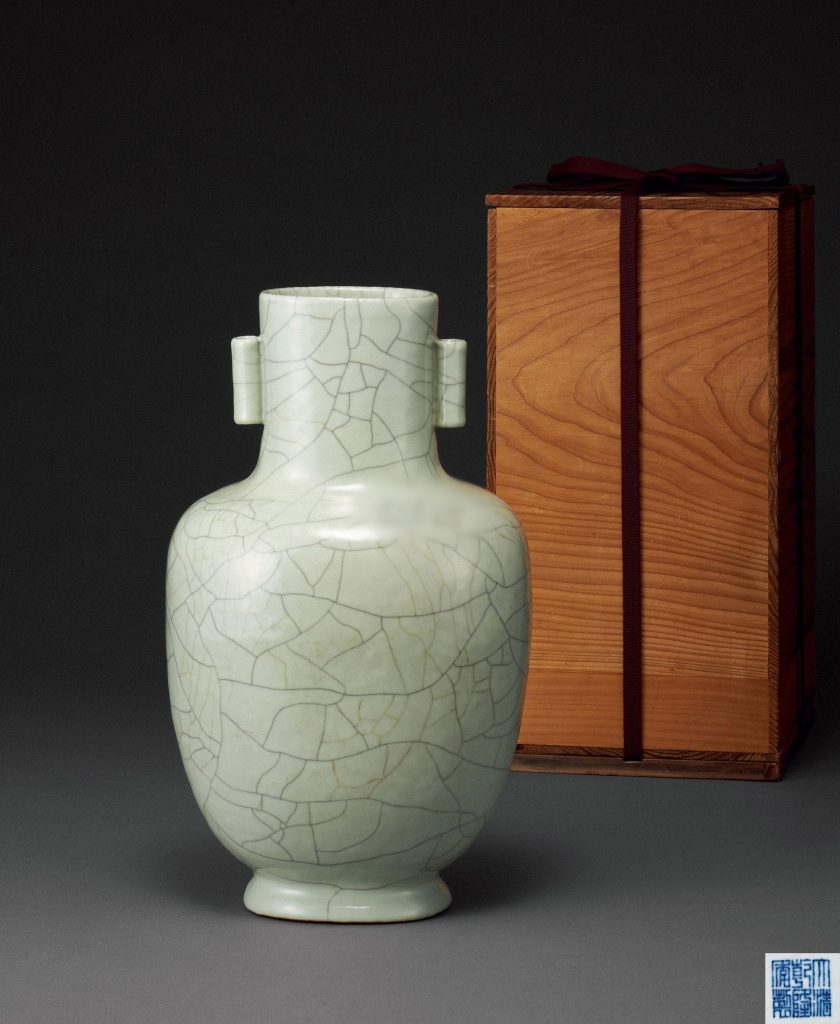
尺寸 宽15cm;高25cm
估价 RMB 273,000-351,000
成交价
“大清乾隆年制”款
说明
此瓶呈扁圆形,方口,束颈,垂腹,圈足。颈部两侧配置中空筒状圆形直耳,称“贯耳”。足底酱褐色,底刻“大清乾隆年制”青花篆书款。此品是仿宋代官窑,釉色粉青,开满大小纹片,瓷质光滑润泽。仿官釉贯耳瓶样式通常以六方、倭角为常见,而本品造型甚少,多出一份古拙之气更贴近宋器之神韵。除造型古朴之外,其釉层物理变化之妙亦远胜同类,尤其 “铁线”纹理疏朗有秩,廖廖数道即贯通全器,气势非凡,一改常见的细碎繁密之风格,予人耳目一新之感。
参考 佳士得香港有限公司
中国重要陶瓷
1994-10-311994年秋季拍卖会
0635 清乾隆 仿哥窑贯耳方壶
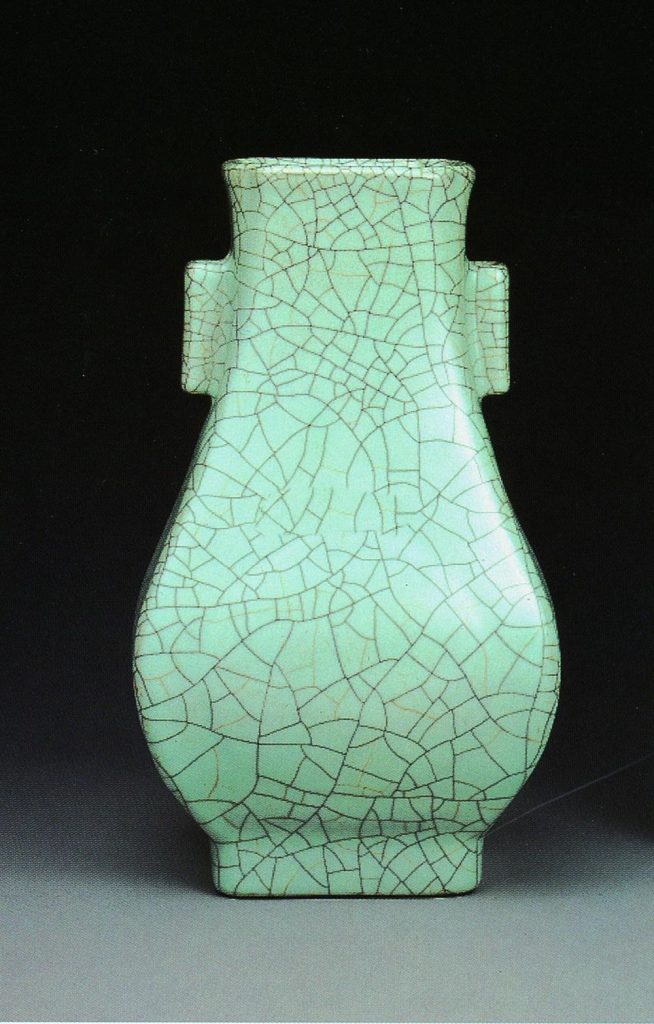
尺寸 高31.8公分
估价 HKD 120,000-150,000
成交价
六字篆书款
参考 清乾隆仿哥窑鋪首耳尊
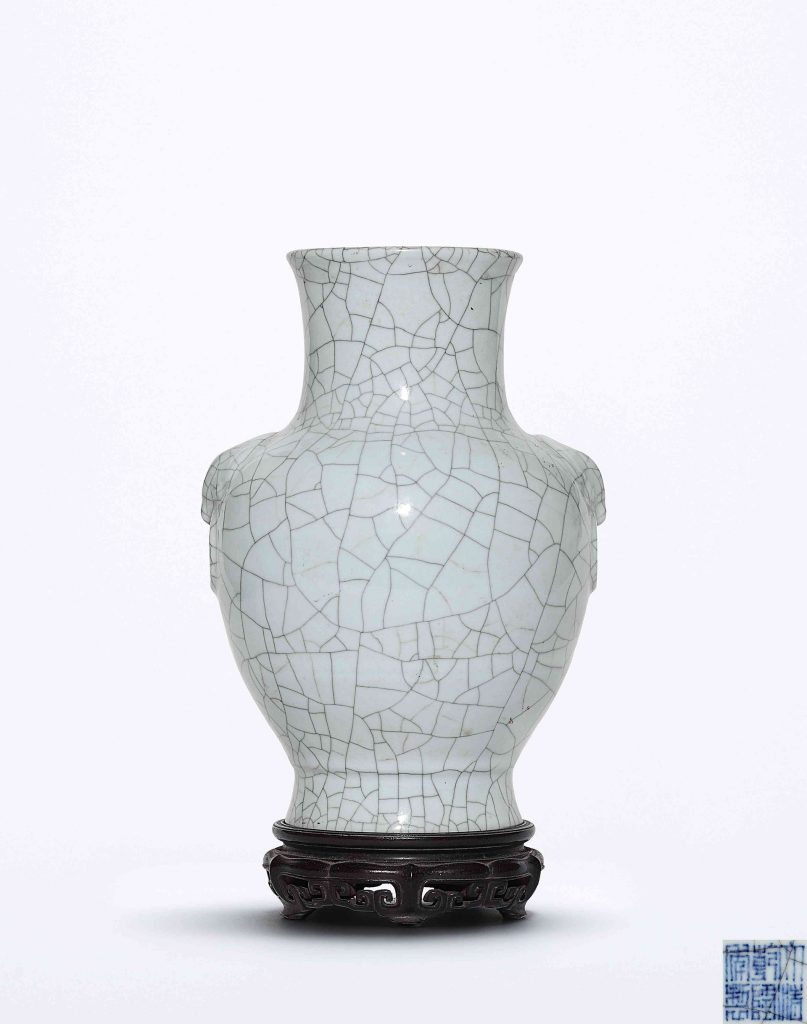
25.3cm
雍乾二帝仰慕古風,富於文人趣味,尤其是對宋器頗為鐘情,以宋人審美為自身品味追求的標準。宋官窯為宋器之精粹,千百年來以古樸典雅之氣質折服無數欽慕者,為文人雅士首推之佳器,明張謙德《瓶花譜》中贊曰:“尚古莫如銅器,窯則柴、汝最貴而世絕無之,官、哥、宣、定為當今第一珍品。”故雍乾御窯對摹造官窯瓷器尤為重視,由《陶成紀事碑記》的記載可見一斑。雍正十三年乙卯冬月,唐英總結雍正一朝瓷業成就所作的《陶成紀事碑》將仿官釉置於五十七種重要供御瓷器品類之首,可見宮廷上下對其之厚愛與尊崇。由雍正皇帝開啓的摹古宋器風尚在乾隆早期繼續流行。乾隆登基之後,依然秉承前朝之傳統,在摹仿宋瓷舊物之中體現出父子二人驚人相似的審美趣味,為了追求最佳的仿古效果,乾隆皇帝不惜下發內府典藏的宋官窯古物讓御窯廠對照臨摹。
本品正是此番摹古熱潮下的傑出代表,成功地以後仿之器詮釋宋人崇尚一色純淨之美學理念。其造型仿西周青銅器,製作規範,造型古樸凝重,腹部兩側有鋪首一對,莊重大氣,古風蕩蕩,器身凸起兩道弦紋,平添動感。通體施青灰仿哥釉,釉水凝潤,金絲鐵線開片疏朗有致,遍布器身,氣勢非凡,雖曰人工,宛若天成,宋人意趣,盡在其中,與清代古瓷鑒定家藍浦所雲“古哥窯器好者類官,亦號百圾碎”(載《景德鎮陶錄》)正相符。圈足塗飾鐵褐之色,底內施釉,書“大清乾隆年制”青花六字篆書款,篆法精到,端莊規整。
此式鋪首尊創燒自雍正,後成官窯傳統器形,以青花纏枝花卉最為常見,單色釉作品相對較少,故頗為珍稀。縱觀明清兩代,若論顏色釉之水平與品類之豐富,當推雍乾之交的御窯廠為最,尤其唐英榷陶以來至乾隆初年的二十年裡,仿古與創新俱精,斑斕多彩,成就顯赫,技藝均達到出神入化、隨心所欲的境界,傳世至今,許多成為空前絕後之佳作,肇啓清代御瓷藝術之巔峰,令後世不可企及。
参考:江苏爱涛拍卖有限公司
2011艺术品拍卖会
2011-09-04
珍瓷雅玩专场
0148 清乾隆 仿哥窑笔筒
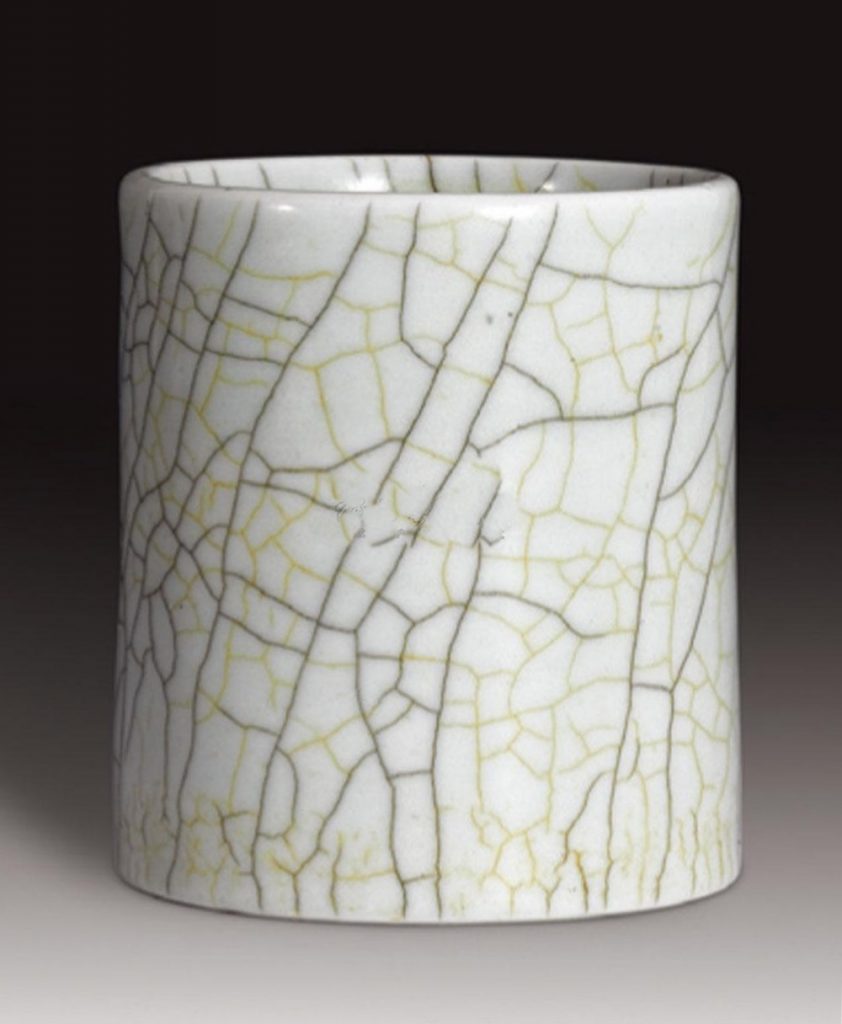
尺寸 直径9.5cm;高12cm
估价 RMB 25,000-35,000
参考0045 清乾隆 仿哥窑观音樽
专场 2001秋季艺术品拍卖会·瓷器工艺品文房器具 拍卖时间 2001-12-15
拍卖公司 敬华(上海)拍卖股份有限公司已开通官网 拍卖会 2001秋季艺术品拍卖会
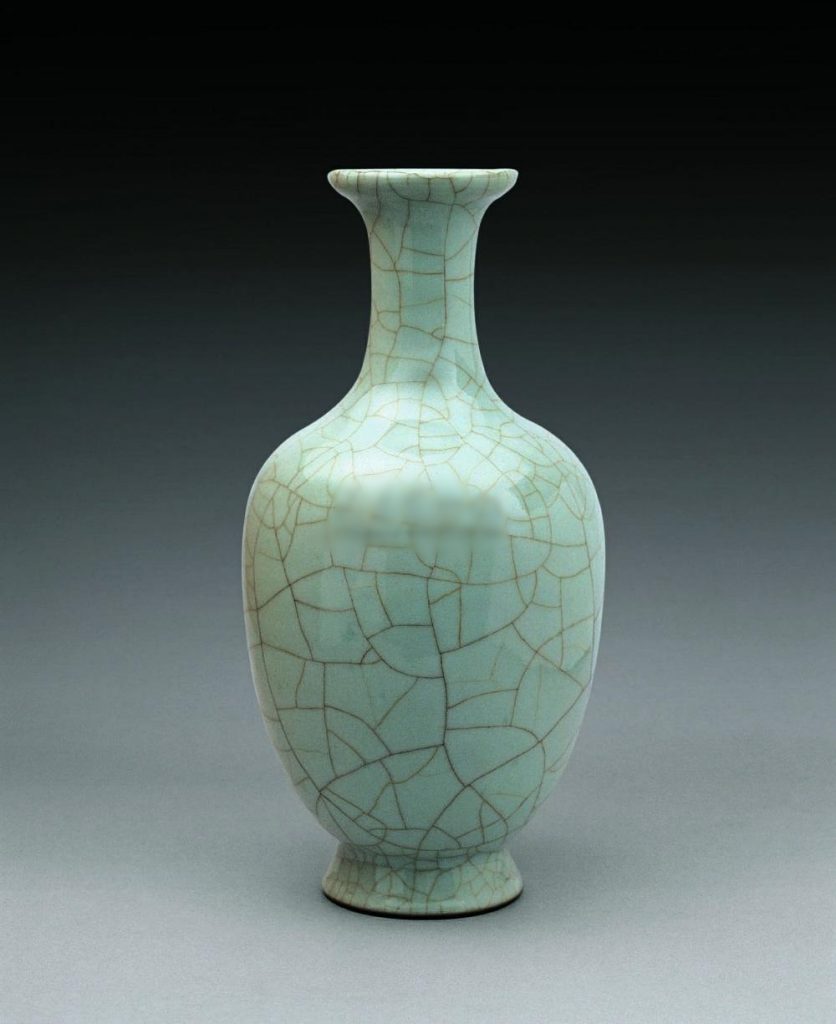
尺寸 高20.8cm
估价 RMB 20,000-30,000
成交价
款识:“大清乾隆年制”六字篆体印章款
说明 说明:撇口,细颈长短适中,丰肩,圆腹较长,腹下收敛,圈足外撇,足墙略高,足底黑褐色,旋纹明显,足内书青花“大清乾隆年制”六字篆体印章款,胎质分量恰当,釉面浅灰,通体米黄色开片,大小错落。观音樽康熙、雍正均有烧造,乾隆时形制最为规整;仿哥窑雍正、乾隆时期亦为清代最佳水平。
参考
专场 古董珍玩(四)——古董珍玩专场 拍卖时间 2014-01-12
拍卖公司 北京翰海拍卖有限公司已开通官网 拍卖会 翰海四季(第83期)拍卖会 1955 清 仿官窑撇口瓶
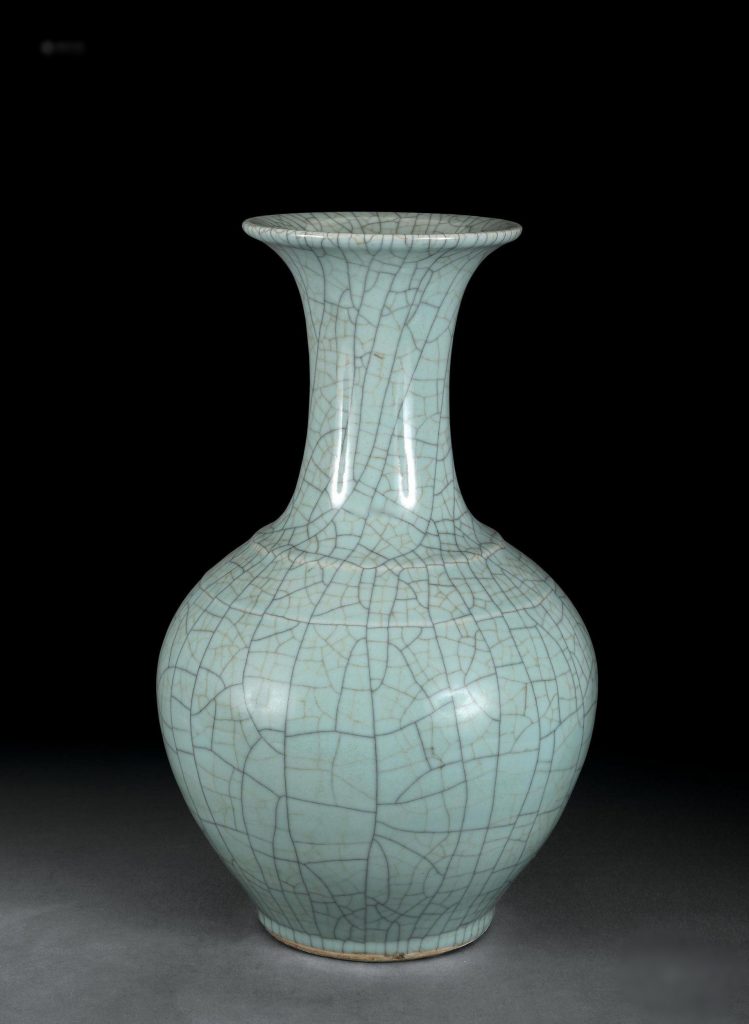
作者 — 尺寸 高52cm
作品分类 陶瓷>清代单色釉瓷器 创作年代 清
估价 RMB 600,000-600,000
成交价 登录后可查看
专场 古董珍玩(四)——古董珍玩专场 拍卖时间 2014-01-12
拍卖公司 北京翰海拍卖有限公司已开通官网 拍卖会 翰海四季(第83期)拍卖会
更多
尺寸 高52cm
作品分类 陶瓷>清代单色釉瓷器 创作年代 清
估价 RMB 600,000-600,000
参考:0033 清乾隆 仿官釉葵口碗
专场 艺林臻赏——瓷器、玉器、工艺品(一) 拍卖时间 2013-09-28
拍卖公司 苏州东方艺术品拍卖有限公司 拍卖会 2013秋季艺术品拍卖会
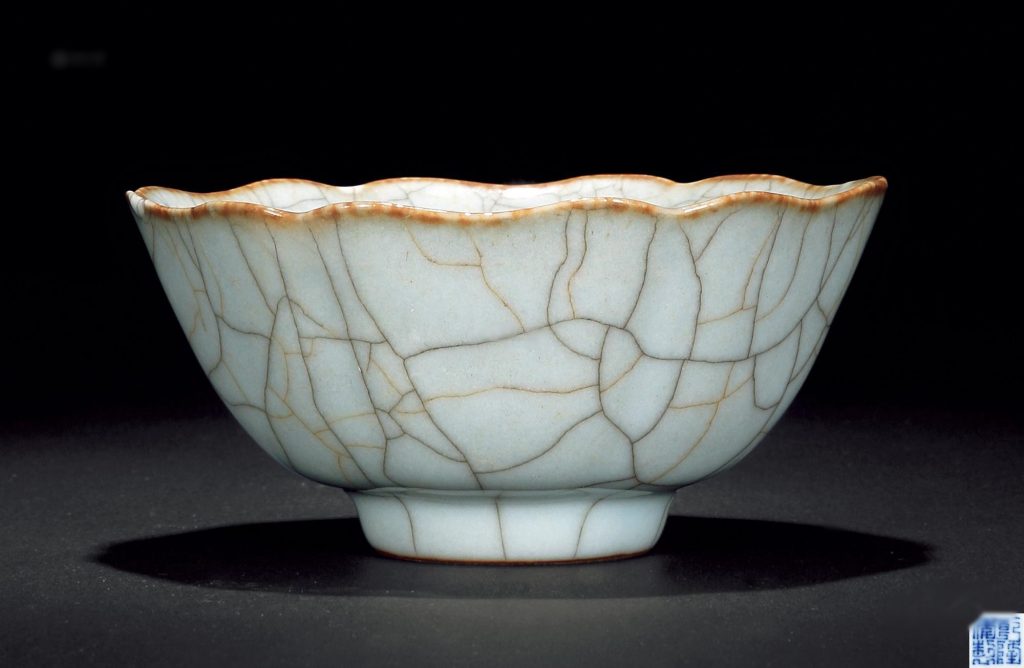
尺寸 直径12cm
估价 RMB 80,000-80,000
成交价
“乾隆年制”四字双行楷书款
说明
葵形口,浅腹,圈足。口沿施酱釉模仿宋官窑的紫口,圈足施铁色护胎釉模仿宋官窑器的铁足。器身施满仿官釉,釉面布满深浅不一的两色开片,似金丝铁线。釉色泽宁静,釉光油润,开片舒朗有致,属乾隆朝仿宋官釉之佳作。
参考: 清乾隆 仿官窑釉瓶
专场 净名斋藏品专场 拍卖时间 2014-01-02
拍卖公司 广州市皇玛拍卖有限公司 拍卖会 2013冬季拍卖会
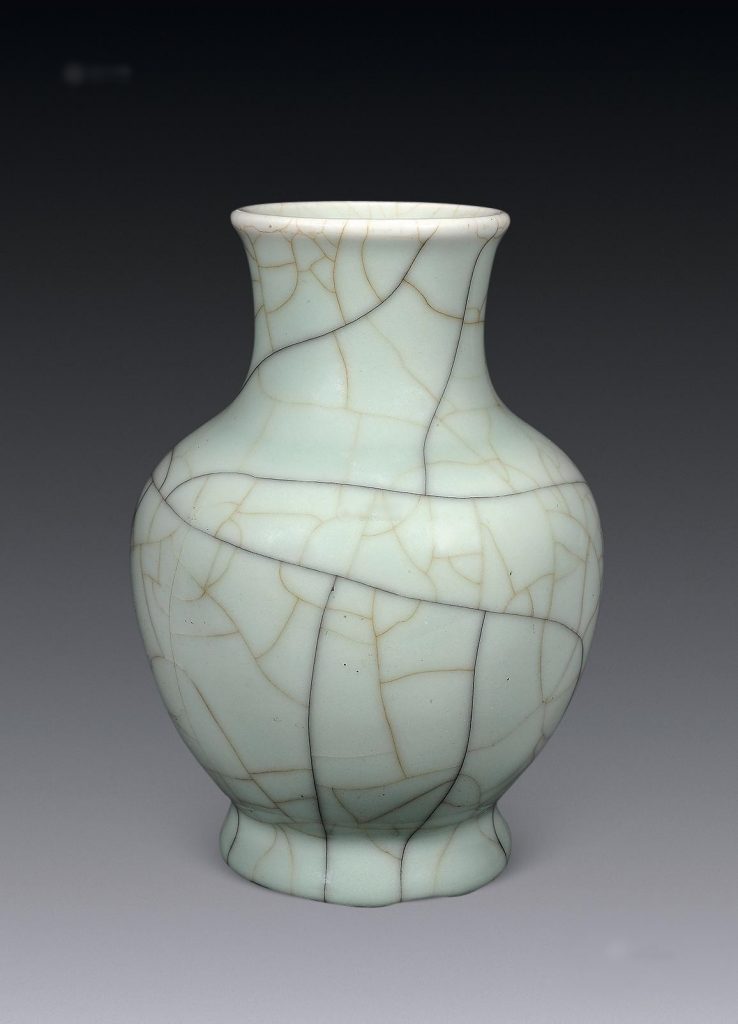
尺寸 高17cm
估价 无 底 价
参考:3418 清乾隆 仿官窑贯耳瓶
专场 中国古董珍玩专场 拍卖时间 2015-04-06
拍卖公司 保利香港拍卖有限公司已开通官网 拍卖会 保利香港2015年春季拍卖会
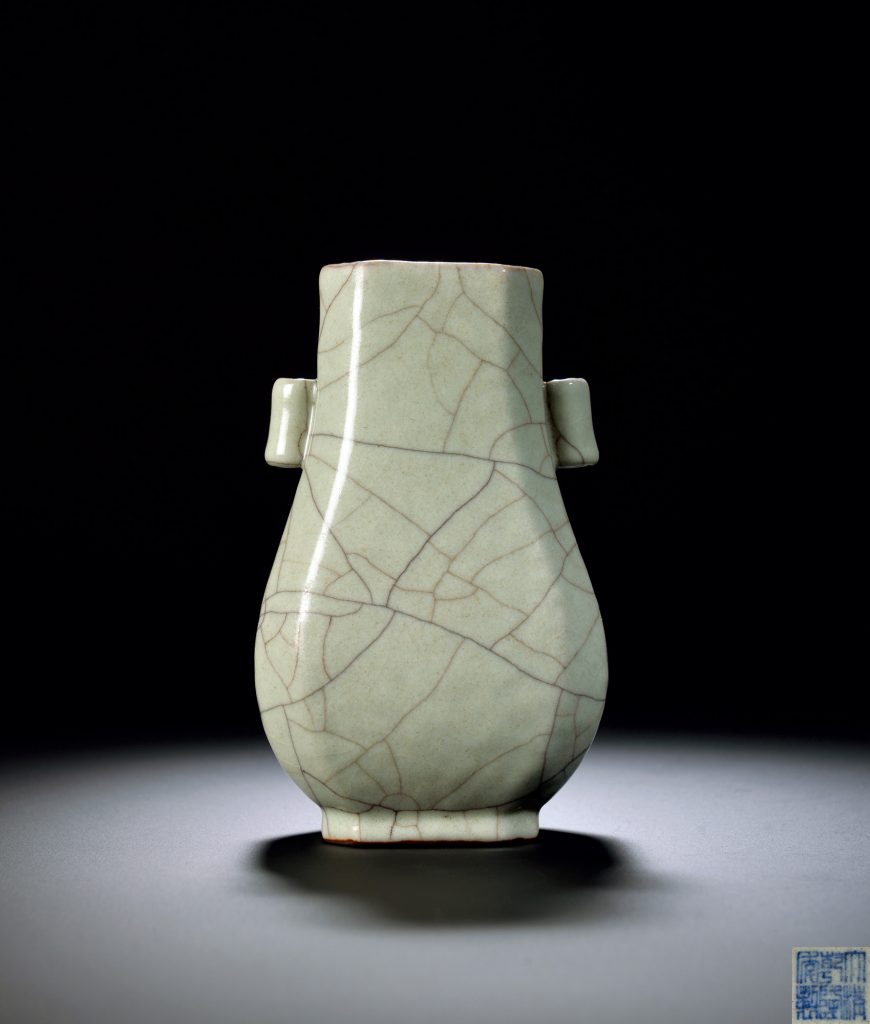
尺寸 高14cm;直径5.5cm
估价 HKD 60,000-80,000
款识:「大清乾隆年制」篆书款
说明
此瓶体呈扁八方形,直颈溜肩,配双贯耳,腹下微鼓,下收为足。瓶外壁通体及足内均施仿官窑釉,釉色乳白如玉,淡雅隽永,铁线开片浑然天成,圈足平实,涂饰铁褐色。各方面的装饰手法都正合唐英《陶成纪事碑》中所载:「…一仿铁骨大观釉,有月白、粉青、大绿等三种,俱仿内发宋器色泽…」,从造办处档案记载中看,仿官釉器物的生产数量也居各类仿宋釉色之首,可见宫廷对其厚爱与尊崇。底内施釉,书「大清乾隆年制」青花六字篆书款,篆法精到,端庄规整,为乾隆仿古瓷器中的精品。
参考:保利厦门2016年秋季拍卖会
中国古董珍玩
清乾隆 仿哥釉鸠耳尊
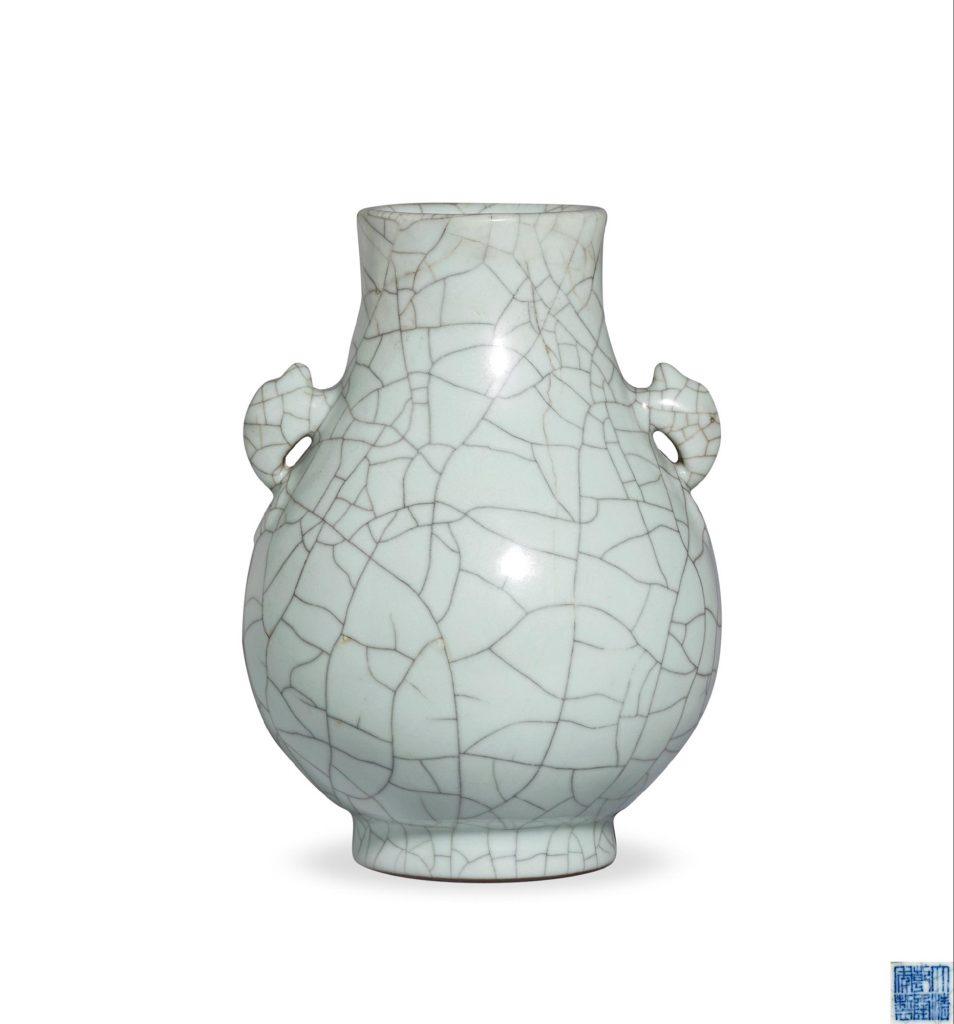
拍卖信息
Lot 0685 清乾隆 仿哥釉鸠耳尊
估价:300,000-400,000 RMB
未成交
尺寸:高21.5cm
拍品说明:
款识:“大清乾隆年制”六字三行楷书款 说明:鸠耳含有长寿意味,《后汉书》中有“八十九十礼有加赐,玉杖长九尺,端以鸠鸟为饰。鸠者,不噎之鸟也。欲老人不噎。”的记载。鸠耳尊器形创烧于雍正时期,原形类似宋代王黼《博古图录考证》中著录“周高克尊”。乾隆一朝,国力强盛,摹古之风更盛,此尊即是景德镇御窑厂仿制古代铜器的典型作品,是一件乾隆宫廷陈设重器。鸠耳尊撇口,弧腹,圈足,颈部饰双鸠耳衔环。通体施冰肌铁骨般的仿哥釉,器宝光内蕴,光素而不事雕琢,尤显温婉隽永。底书青花“大清乾隆年制”六字篆书款识,款识笔笔间断,字体疏为硬朗,应属乾隆早期官窑款识之风格。拍品在造型、釉彩上与沈阳故宫博物院清宫旧藏清乾隆款仿哥双兽耳瓶(参见《沈阳故宫博物院院藏文物精粹》. 瓷器卷(下),页166)相同,可资比较。参阅:《沈阳故宫博物院院藏文物精粹》. 瓷器卷(下),万卷出版公司,2008年,页166
参考:佳士得拍賣 14850
古韻天成-臨宇山人珍藏( 三 )
紐約|2018年3月22日
拍品512
北宋 磁州窯白釉瓶
NORTHERN SONG DYNASTY (960-1127)
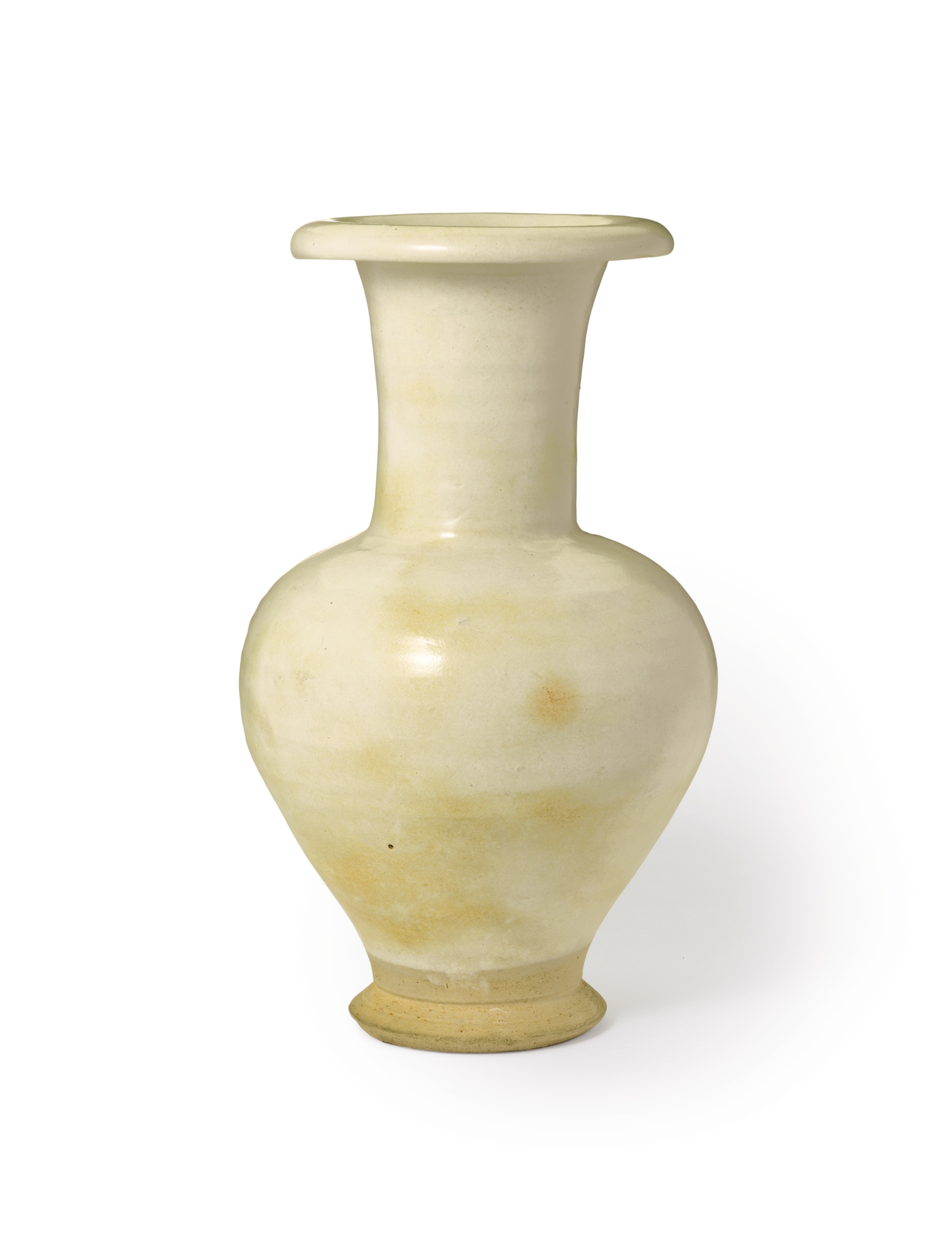
北宋 磁州窯白釉瓶
成交總額 USD 100,000
估價 USD 50,000 – USD 70,000
北宋 磁州窯白釉瓶
12 in. (30.5 cm.) high, Japanese wood box
來源
戶栗美術館藏品,東京。
倫敦蘇富比,2004年6月9日,拍品56號。
文獻及展覽
文獻
大阪市立美術館,《中国美術展シリーズ4宋元の美術》,大阪,1978年,編號1-137。
大阪市立美術館,《宋元の美術》,東京,1980年,圖版142號。
戶栗美術館,《開館記念名品展》,東京,1987年,編號13。
戶栗美術館,《中國陶磁名品圖錄》,東京,1988年,編號54。
戶栗美術館,《財團法人戶栗美術館藏品選集—西曆2000年記念圖錄》,東京,2000年,圖版17號。
大阪市立美術館,《白と黒の競演 : 中国磁州窯系陶器の世界》,大阪,2002年,60頁,編號3。
佳士得,《古韻天成:臨宇山人宋瓷珍藏展覽》,香港,2012年,編號48。
蘇玫瑰,‘Chinese Classic Wares from a Japanese Collection: Song Ceramics from the Linyushanren Collection’, 《Arts of Asia》,2014年3月至4月,97-108頁,圖23。
展覽
大阪市立美術館,《中國美術名品展第四集:宋元の美術》,1978年10至11月。
戶栗美術館,《開館記念名品展》,東京,1987年。
大阪市立美術館,《白と黒の競演 : 中国磁州窯系陶器の世界》,2002年10至12月。
佳士得,《古韻天成:臨宇山人宋瓷珍藏展覽》,香港,2012年11 月22至27日;紐約,2013年3月15至20日;倫敦,2013年5月10 至14日。

![[临渊阁]天地一家春](https://www.antiquekeeper.ca/wp-content/uploads/2023/04/BW-Erping-1a-17-6-1.jpg)
